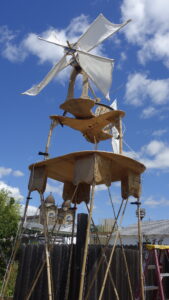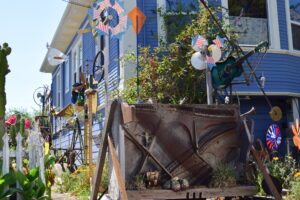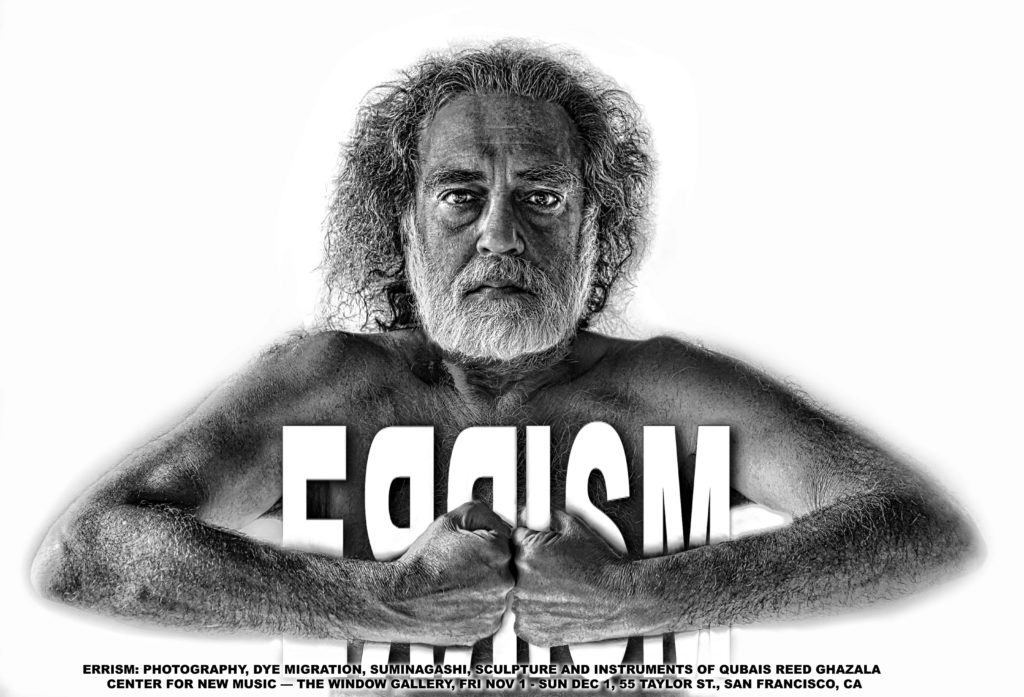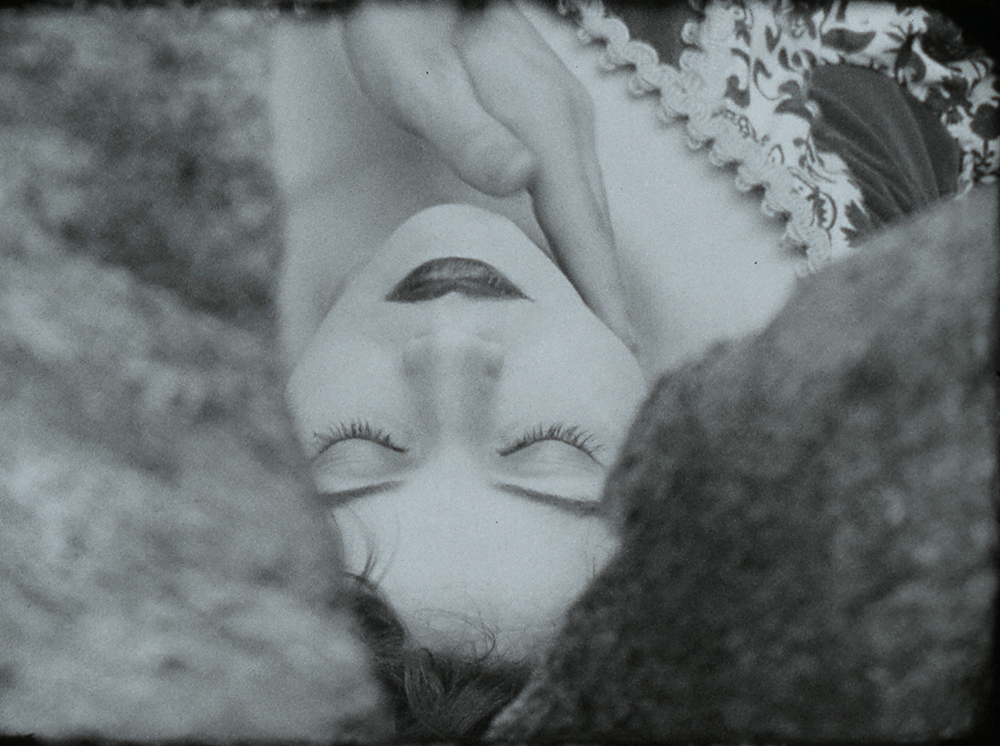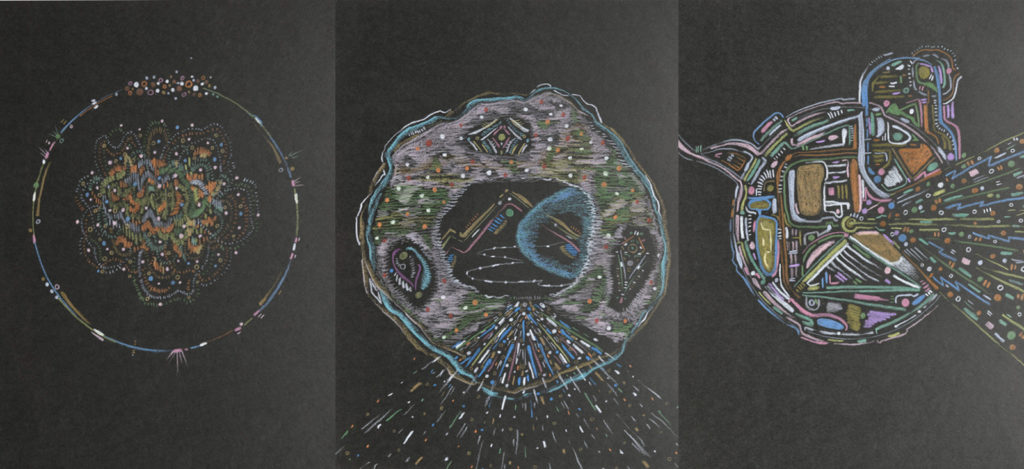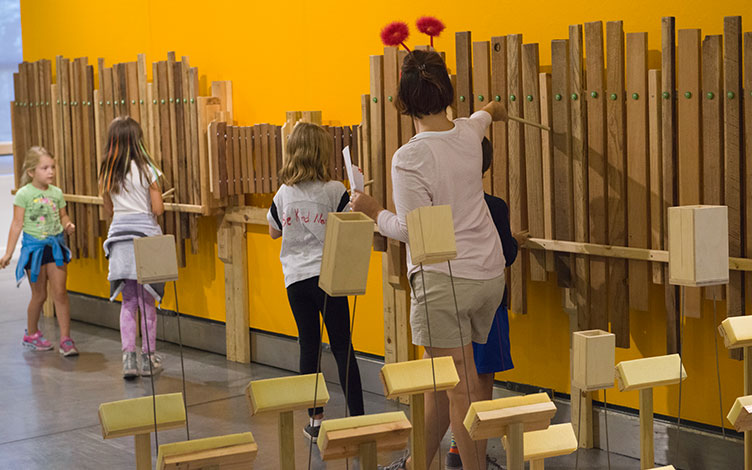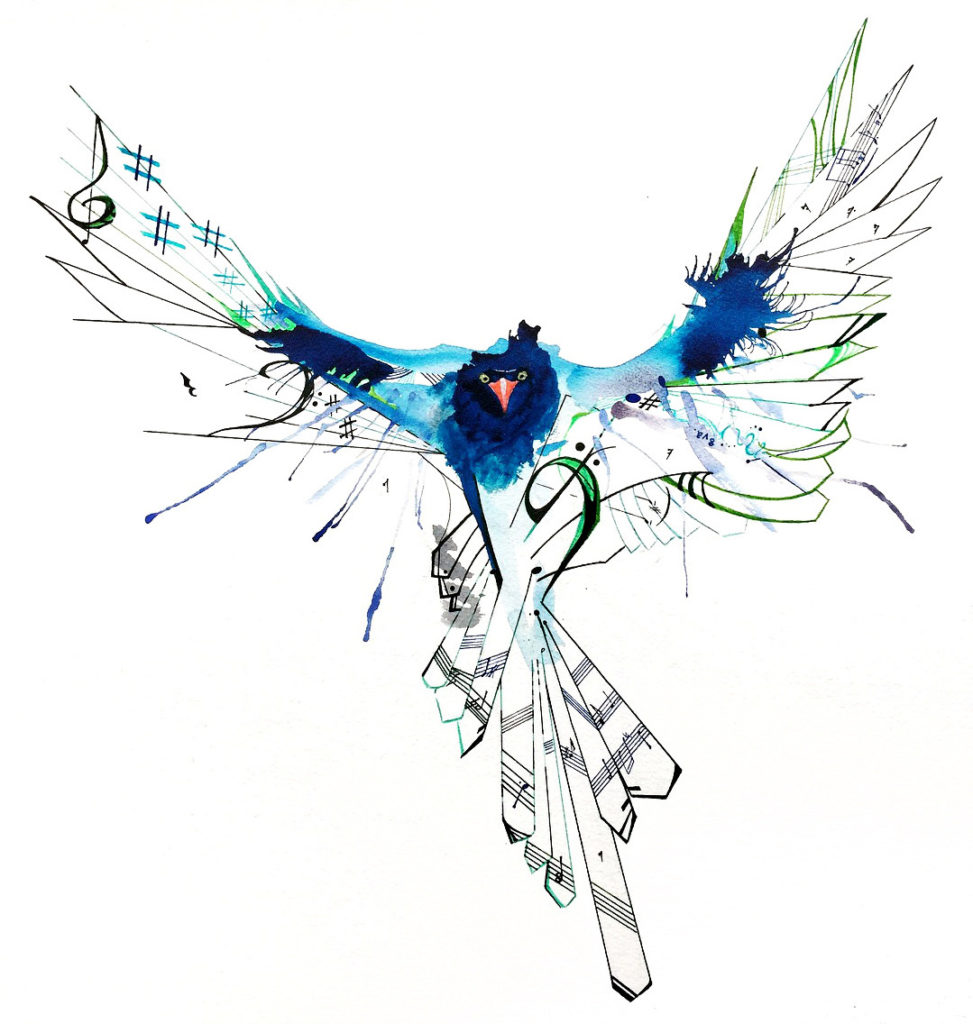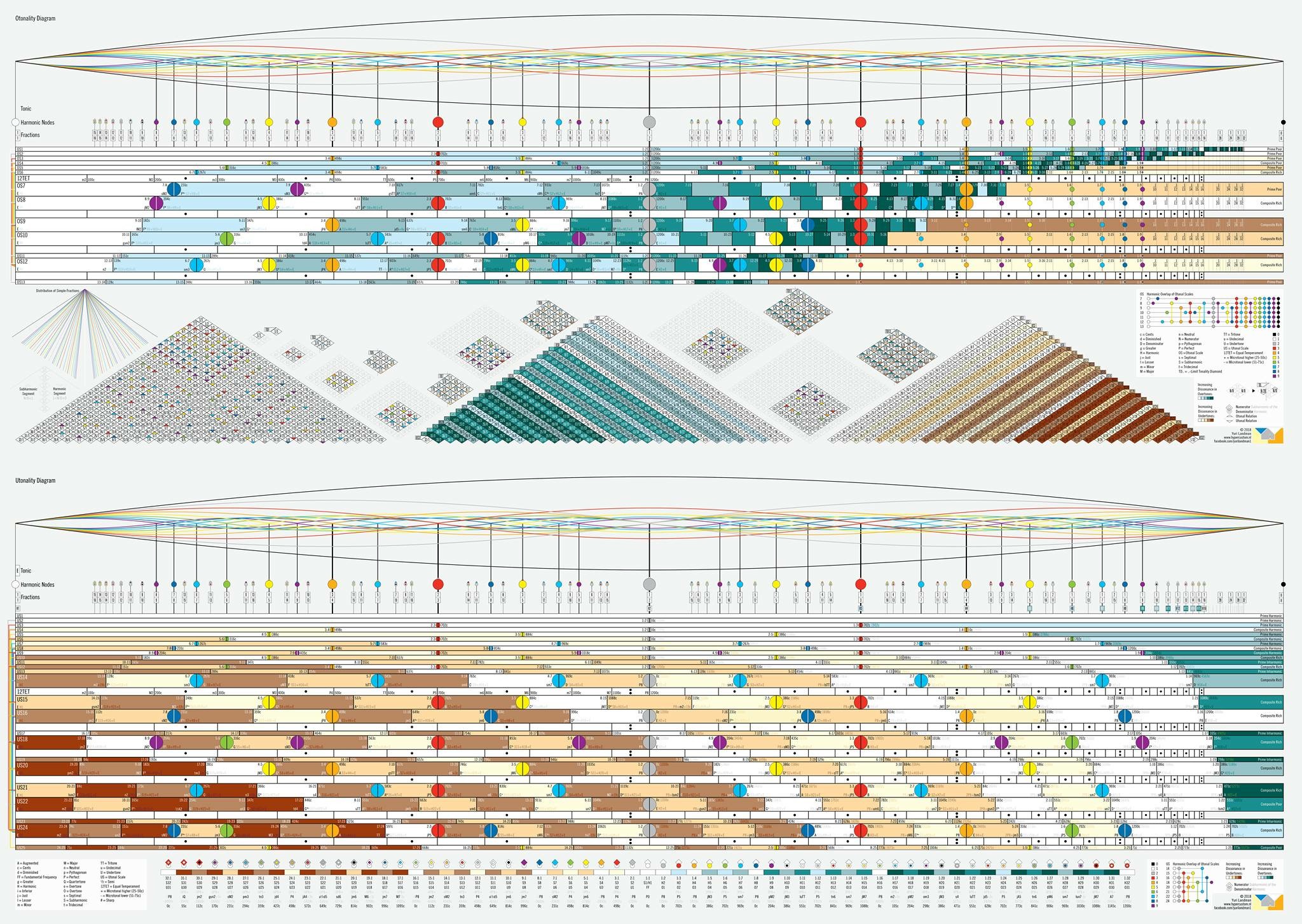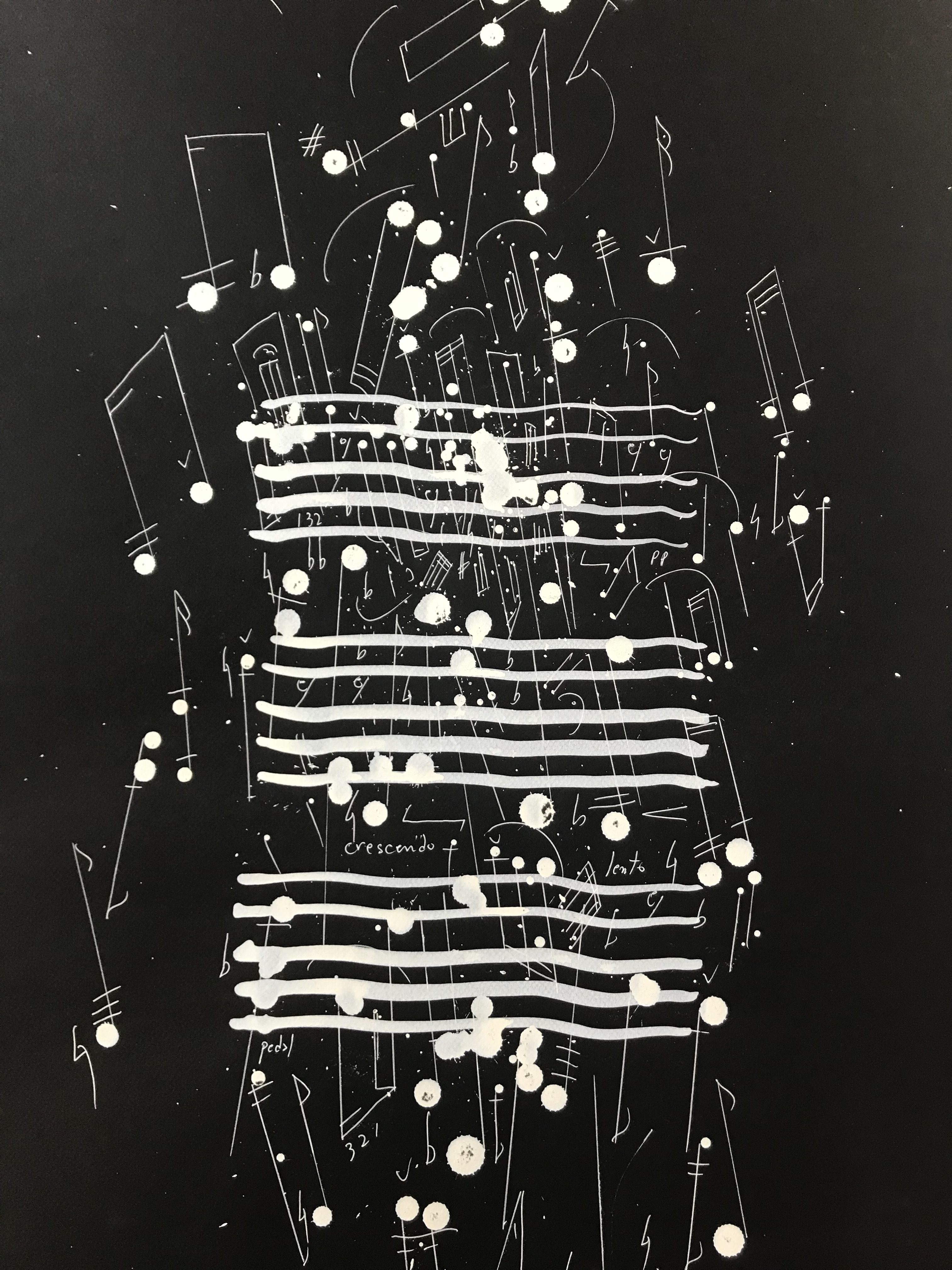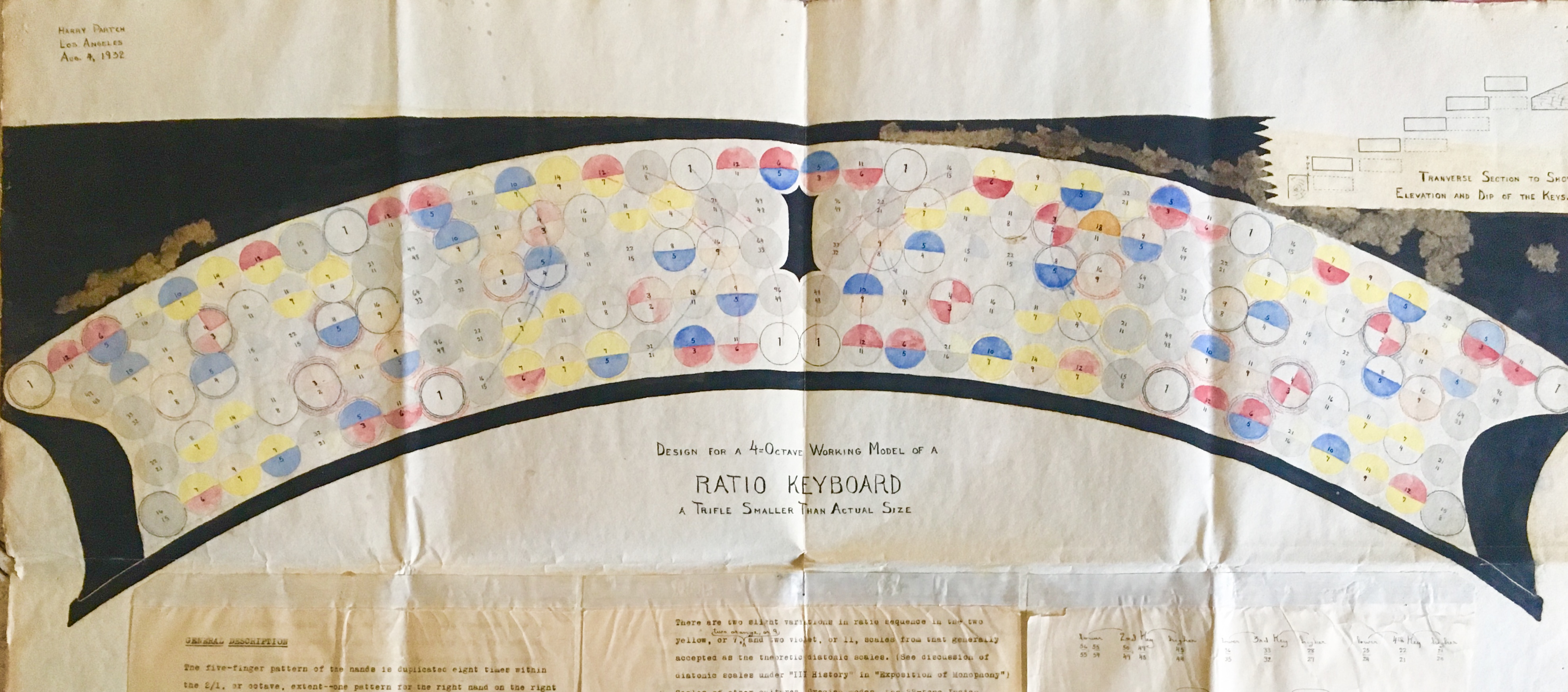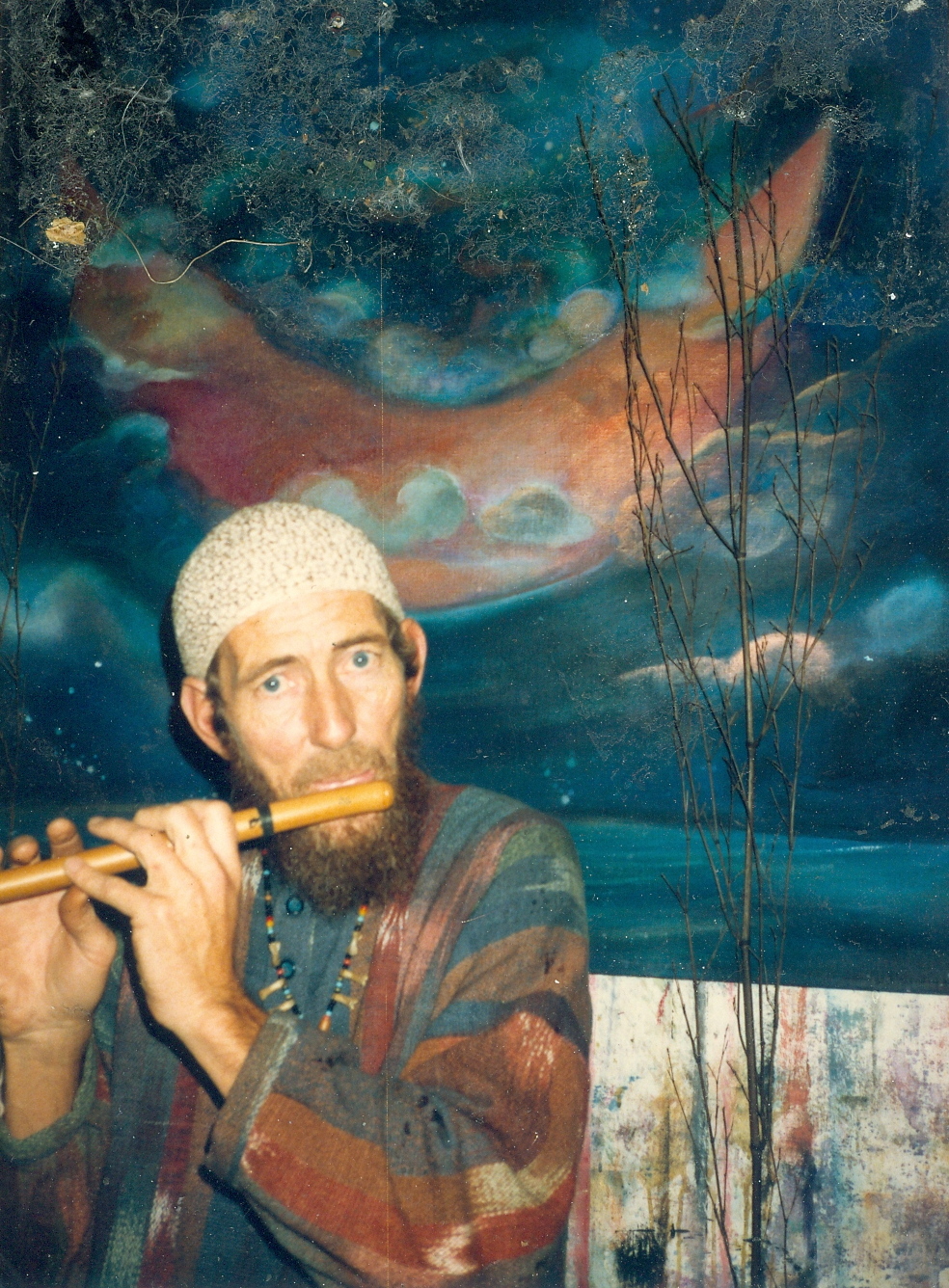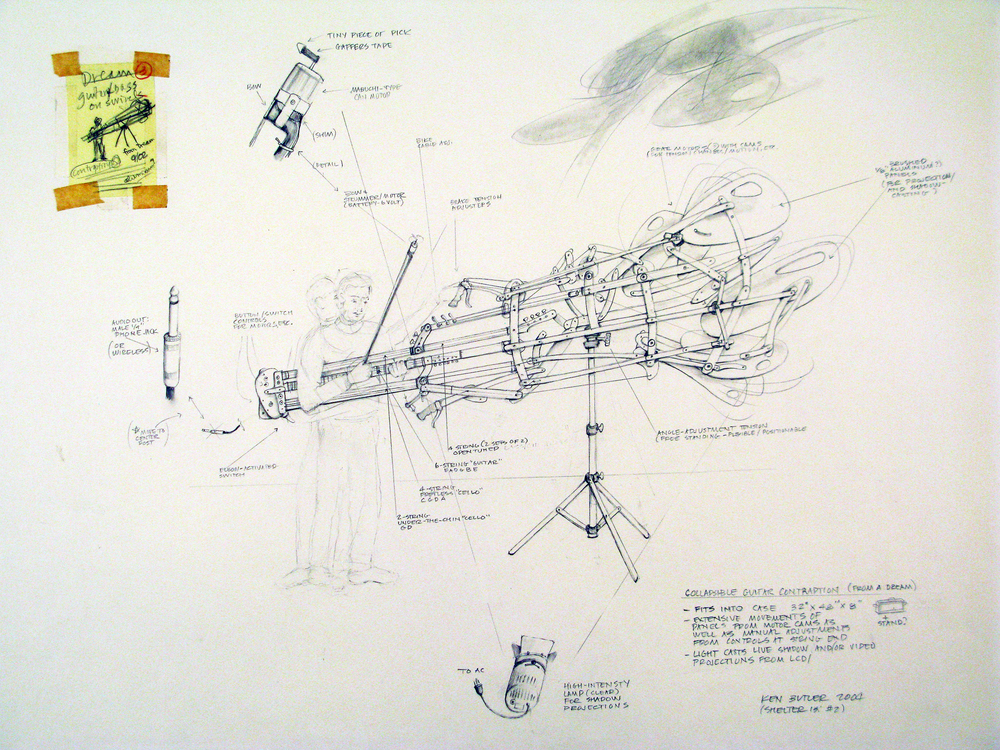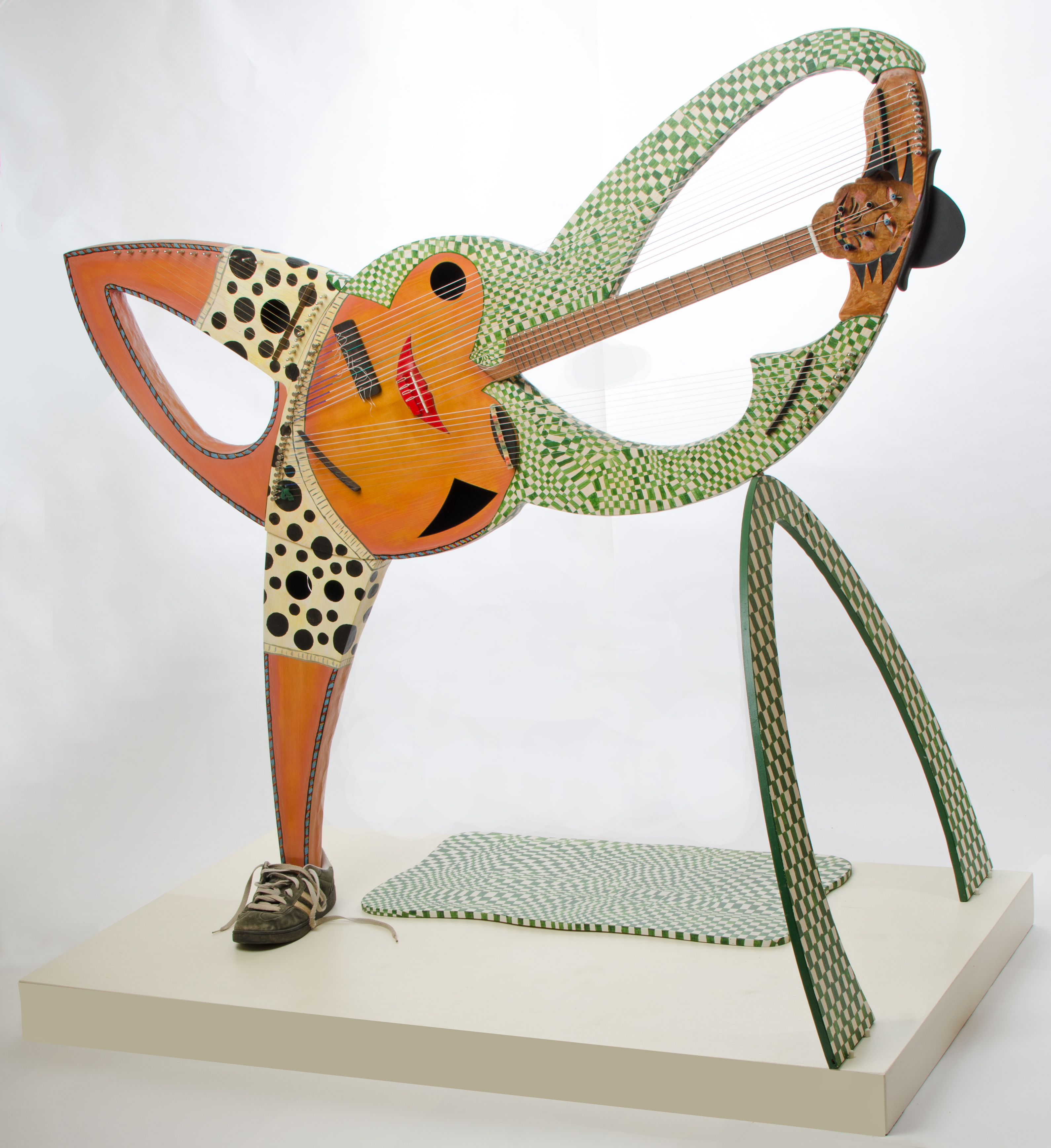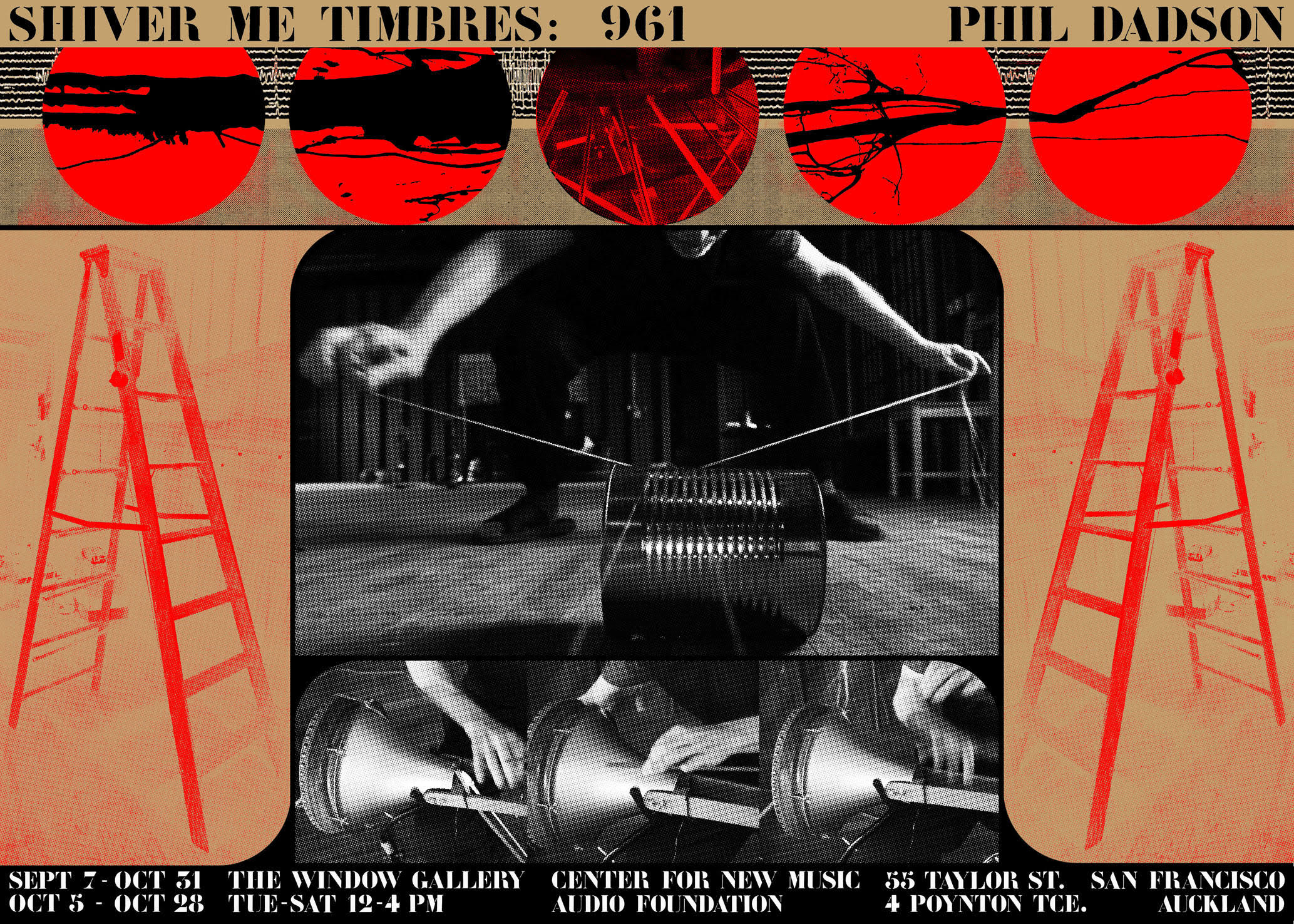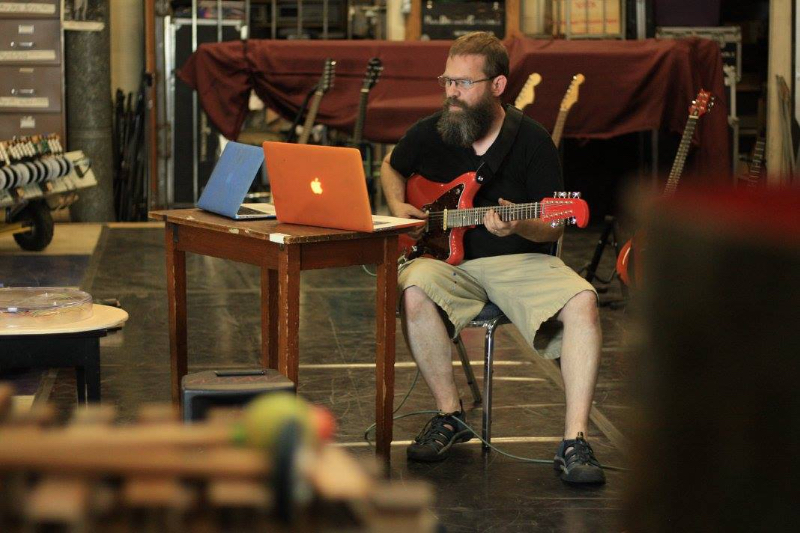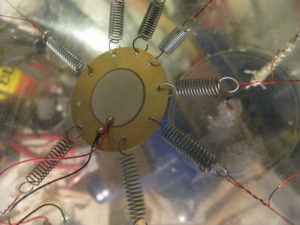Gallery (Past Exhibits)
Upcoming ExhibitsThe Window Gallery presents the work of contemporary makers of unusual and newly invented musical instruments, including emerging artists as well as recognized pioneers. The emphasis is on originality in concept and design, recognizing the seminal role of the search for new sounds in the expansion of musical horizons. Equally essential to the exhibits are notions of beauty, craft, and humor.
The Window Gallery is curated by Bart Hopkin, David Samas, and Kirk Pearson. Located at 55 Taylor Street in San Francisco, the gallery is open to the public Monday through Friday, 9 am – 5 pm, and during performances.
Email the Gallery Manager for information, questions, comments or to propose an installation.
Support the Window Gallery’s one-of-a-kind exhibits by making a contribution to the cause:
CURRENT ATRIUM: Maurice Kamins’ “Shofarot”
Fri, Nov 1 — Tue, Dec 31, 2024
Artist Statement
Close to 30 years ago while sitting in the balcony at Congregation Sherith Israel listening to the sound of the shofar, with hubris and a bit of gall, I thought I could do that (blow the shofar) and build my own. At the time I was making sheath knives and noticed that Texas Knifemakers, as well as selling scales, sold whole Kudu horns. So I bought one and made my first shofar. It never occurred to me when I started that there were hundreds of pages of biblical text and commentaries on the making and blowing of the shofar. Over the years I have made over 600 shofarot from about 20 different kosher animals. Although I make traditional shofarot from rams horns I also have made shofarot from Kudu, Waterbuck, Roan Antelope, Sable Antelope, Bighorn Sheep, Buffalo, Prong Horned Antelope, Scimitar Oryx and many others. I am honored that my shofarot have been carried around the world and are enhancing the High Holiday services in innumerable congregations.
Maurice

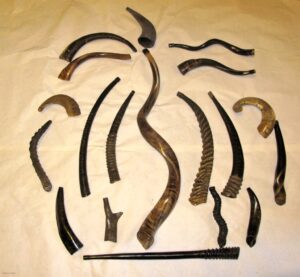
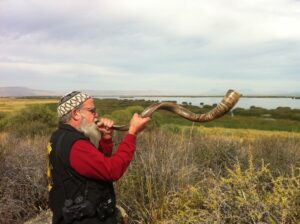
CURRENT EXHIBIT: Judy Dunaway – Balloon Tapestry with the Sound of Its Own Making (Tribute to Robert Morris)
Sat, Nov 2 — Tue, Dec 31, 2024
Performance/opening November 2: Judy Dunaway, Free Improvisations and “Balloon Tapestry with the Sound of Its Own Making”
View Performance/Opening page here
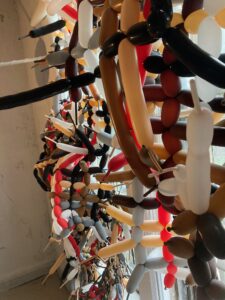
Artist’s Statement
This composition/sound installation is about the sound of the weaving of “twister” balloons and the visual culmination of that sound. Balloon twisting is both an art and a skill. Commonly used by street and party entertainers, it has also been used to weave artistic creations and even for fashion. These professionals use “twister” balloons, long thin latex balloons manufactured especially for this purpose. However, as a “sound artist,” my interest is in the sound of the weaving. At various times during exhibition hours, “twister” balloons will be woven together on site and afterward hung in the space. An audio recording will be made of the weaving. When the balloons are not being woven, the recording of the weaving will be played back softly in the room. The twister balloons will gradually deflate over the course of a few days or weeks, and new balloon tapestry squares will be added on a regular basis. It is a futile exercise, as the creation is constantly dying. However the audio recordings will accumulate, making a longer and longer loop. The form of the piece will change throughout the duration of the exhibition. Guest performers/weavers: Kattt Atchley, Brenda Hutchinson, Cheryl Leonard, Brent Miller, and more TBA. Materials: 100% natural latex twister balloons (photodegradable), biodegradable ribbon, air, audio recording device, method(s) for audio playback.

Bio
Judy Dunaway is internationally known for her numerous works for latex balloons as sound producers, including sculptural sonic performances, sound installations, interactive pieces and acousmatic works. She has presented these works at many notable locations including the Academy of Media Arts Cologne, Alternative Museum (NYC), Audio Art Festival 2016 (Krakow), Barcelona Museum of Contemporary Art (MACBA), Cafe Oto (London), Bang on a Can Festival (NYC), Everson Art Museum (Syracuse), Expo’74 at Mass MoCA, Frau Musica Nova (Germany), the Guelph Jazz Festival (Canada), Lincoln Center Out-of-Doors (NYC), the New Museum of Contemporary Art (NYC), Performance Space 122 (NYC), Podewil (Berlin), Roulette (NYC), the Roy and Edna Disney Center (Los Angeles), Seltsame Musik Festival (Austria) and STEIM (Netherlands). Her awards/grants/residencies include Foundation for Contemporary Arts Emergency Grant, iii Instrument Inventors Artist-in-Residence, Elektronmusikstudion Stockholm, New York State Music Fund, the Aaron Copland Fund Recording Grant, the American Composers Forum’s Composers Commissioning Fund, Zentrum fuer Kunst und Medientechnologie, Harvestworks Digital Media Arts Center and the National Endowment for the Arts performance fund. She has given academic presentations about her works at many colleges and universities, including Accademia di Belle Arti di Brera (Milan, Italy), Berlin University of the Arts, Brown University, Columbia University, Concordia University (Montreal), Hochschule fuer Gestaltung Karlsruhe (Germany), Juilliard School of Music, Musik Akademie Basel (Switzerland), New England Conservatory, Rennselaer Polytechnic, University of California at Santa Cruz, University of Gothenberg (Sweden), University of Huddersfield (U.K.) and University of Michigan. She has a Ph.D. from Stony Brook University and an M.A. from Wesleyan University (where she studied with Alvin Lucier). She has been teaching at Massachusetts College of Art and Design in Boston since 2005. Website: www.judydunaway.com
Press Quotes
Although it is a household object that is associated with childhood and celebrations, Dunaway’s works for balloon rarely expounds on such quotidian functions. Her practice challenges these assumptions, compelling audiences to wonder how such a mundane object can engender such complex sounds and meanings….Instead of presenting a narrative, many of Dunaway’s works strive to create a sense of space…In a context that features ambient rather than rhetorical material, these micro-components of sound become of primary interest to the listener. Thus, in addition to transferring listening capacities to other areas of the body, this physical approach to music-making slightly shifts the focus on what audiences should listen for. – Tonia Ko, “Acts of Envelopment: Implications of Touch in Judy Dunaway’s Works for Balloons” from “A Portfolio of Two Essays” by Tonia Chi Wing Ko, Doctoral Dissertation, Cornell University, Ithaca, NY:
https://ecommons.cornell.edu/items/be59d7b8-223e-4a99-b42e-d54495e38651
The embodied relationship that Dunaway has developed with the balloon over the past decades resulted in an artistic practice extremely tuned to the sonic proprieties of every inch of the latex balloon. – Carlo Patrão, Sounding Out!, April 22, 2019
Dunaway is utterly fearless in her approach to her craft, and unflinching in the face of inevitable backlash from both her classical and avant-garde contemporaries. – Meredith Yayanos, Coilhouse Magazine, October 2007 (Review of “Mother of Balloon Music” CD on Innova Records)
https://coilhouse.net/2007/10/the-amplified-pneumatic-squeakitude-of-judy-dunaway/
EXHIBIT: Larnie Fox’s ‘Contraptions’
Sun, Sep 1 — Thu, Oct 31, 2024
Larnie Fox presents ‘Contraptions’ his installation of invented instruments at C4NM’s Window Gallery! A reception will be held on Sunday, September 8th at 4pm. Reception with light refreshments will be followed by a talk/demo by Fox. View the event page at the link below.
Artist’s Statement ~ Contraptions
What I’m doing is fun. It has developed, gradually, over many years, starting in Salt Lake City in the early 80s when we had heard about “performance art”. We didn’t have any idea what it was, but we did it anyway, and had a blast. My instrument building work has evolved from hacking old mechanical devices we used in performances, like 8-track tape players or TVs, to working with more natural materials like bamboo, sticks, and feathers. I like common materials, such as plywood, string, and hot glue and I love to work with recycled materials like coat hangers, rubber bands and found hardware
I’ve never formally studied sculpture, or electronics, or sound, so I always feel like an explorer, discovering things that are already well known, but are new to me. My studio feels a bit like a mad scientists’ lab. My lack of expertise forces me to keep things basic, so folks can see how the instruments work. I approach these things in new ways, so that folks can see the materials and the objects created from them in new ways as well
I am happy if there is a little pathos to my work. Perhaps they look like a child made them, or perhaps they look like they are ready to break. I am happy if there’s a little vulnerability to the work. I have no desire for my work to be polished or slick
I love making things, then turning them over to collaborators to see what they do with them ~ it is always surprising! It is akin to the joy one feels after giving a successful present to a loved one. What I am doing is fun. Deep fun
Larnie Fox
8/10/24

Bio
Larnie Fox is a visual and sound artist known for his large-scale bamboo sculptures, kinetic sculptures, sound installations, performances, and paintings. After earning an MFA in painting from the University of Utah, he taught at Weber State College in Ogden, Utah, and later directed children’s programs at the Palo Alto Art Center. He also served as the Executive Director of Arts Benicia in Benicia, California, from 2010 to 2015
Fox’s work has been shown in numerous exhibitions and performances in the San Francisco Bay Area and nationally. He created and led the Crank Ensemble, a group that performs on hand-cranked instruments he built. Currently, he is inventing instruments, composing, and performing with the new-music group the Contraption Quartet, a sound art collaboration that explores sound and visual performance using low-tech handmade instruments and sound sculptures
Recent collaborations with his wife, Bodil Fox, include interactive sound sculpture shows at Pro Arts Gallery in Oakland and NY2CA Gallery in Benicia, titled Probability, and Probability 2. Their joint projects also encompass dicewalks, interactive installations, residencies, performances as a duo as well as with the Contraption Quartet and the Crank Ensemble. They recently returned from a month-long residency at Mas de Grape near Aix en Provence, France, where they created installations using found materials at an old farmstead. Their sound installations are currently on view at Zaprice Castle and the Volčji Potok Arboretum as part of the six-month-long, multi-venue art project Dobre Novice in Kamnik, Slovenia
Larnie and Bodil Fox live and work together in an old house near the water in Benicia, California
ATRIUM EXHIBIT: Moe Staiano’s Bird Line
Thu, Aug 1 — Mon, Sep 30, 2024
Moe Staiano (b.1973, Staten Island, New York)
Moe Staiano is a musician and composer of new music works and angular rock music for various bands including Sleepytime Gorilla Museum, Mute Socialite, and currently Surplus 1980. He also runs the Moe Staiano Ensemble which performs his works of composed works for varying degrees of amounts of musicians. He has been performing since about 1995 or so. This little exhibition you see here is not music, but photography, which has been an interest to Mr. Moe since way back. This is his first ever part of an exhibition and his work dive into a photography project. Some of his photographs has graced some of his releases that he has put out over the years and likes to combine the two together. Neat.

If you’re keen to peak your interest, you can check him out at www.moestaiano.com. Thanks.
Artist Statement
I have always liked the angular visual of a geometric composition that comprises an image, whether it be drawn or photographed, there is something that has grasped my interest that is compelling and interesting. I have found that to be the case with my photographs that I have taken recently that consist of telephone lines acquainted with a fellow object. The object, in this case, is a bird (or birds, in some instances). In some of my past photos, I found a simplicity with telephone lines among an overcast backdrop, with endless options to construct an image with other overlapping lines. The overcast backdrop gives me a palette to work with in a way to make the contrasts very sharp in a black and white setting. The shapes of the lines provide an endless chance of possibilities that compose the image, with the bird being the focal point in an abstract fashion that calls out to the art styles of Constructivism and Supremacism while being very minimalist at the same time. Rather than a typical bird on a wire, I like having the challenge of a bird in action, moving between the lines, instantly compartmentalizing it in a frame of wires.
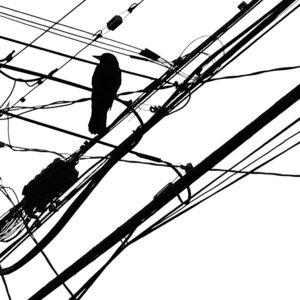
One such feature that made this project more of being at ease with getting very compelling images is due to one avian corvid, an American Crow, who I gave the name ‘Alfred’ (after the photographer Alfred Stieglitz) in my neighbourhood. Alfred is in a majority of the photographs you see here and is easy to spot: launching from a telephone line, with sometimes the illusion of gravity taking over and looking like it is falling down (or flying UP to a telephone line in one case). This is due in part to the likelihood of feeding squirrels in my parking spot at my apartment complex. In some way, a crow made its way to that feeding spot and gave some nuts (shelled peanuts, always unsalted, by the way). Overtime, I would see a crow and drop a nut somewhere where it would retrieve it. As time went on it would fly near me and I would fully acknowledge it and give it a peanut. I was then gifted the privilege of having it be near me on a telephone line, have my cameraphone at the ready with peanut in hand, then throw it away from me. I would then get a series of photos of the crow in action, dive-bombing for its food reward while rewarding me with some wonderful images. I still make the effort to walk around in the morning, search for Alfred to fly to me for his peanut treats.
The prints will be made available to purchase.
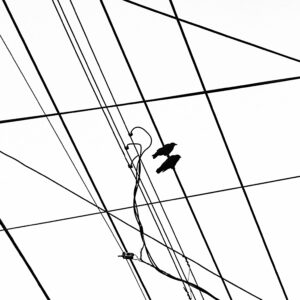
Sung Kim
Mon, Jul 1 — Sat, Aug 31, 2024
An opening reception for this exhibit will occur on Friday, July 12th, at 6pm. Learn more and RSVP for this free event at the link below
Artist Statement:
Immersed in the vibrant DC Punk Rock scene, Sung Kim nurtured a unique vision: to channel the collective power and dynamism of an entire band through his singular artistry. His journey as a pioneering force in avant-garde sound and instrument building took a profound turn following a life-altering accident that severed and reattached two fingers on his dominant left hand.
This adversity became the catalyst for a remarkable evolution in his craft. As Sung embarked on his healing journey, his workshop transformed into a sanctuary of innovation. In the early days of recovery, he began crafting rudimentary instruments, each a testament to his resilience and determination to continue creating despite his physical limitations. These initial creations were simple yet functional, reflecting the nascent stages of his recovery.
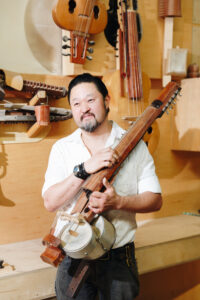
As strength and dexterity gradually returned to his hand, Sung’s instruments evolved in complexity and sophistication. Each new piece embodied his regrowing mastery and unyielding spirit, transitioning from basic forms to intricately designed marvels of craftsmanship. The process was iterative and deeply personal, with each instrument marking a milestone in his healing journey.
This collection, now displayed at the West Oakland Sound Series, is a chronological narrative of Sung Kim’s perseverance and transformation. Each instrument in the collection tells a story of growth and renewal, illustrating the step-by-step evolution of his artistry. Sung invites audiences to witness this journey through his improvisations, where every note played on these instruments weaves a melodic tapestry of healing and triumph, showcasing the indomitable spirit of creativity.
ATRIUM: Paul Winstanley
Mon, Jul 1 — Wed, Jul 31, 2024

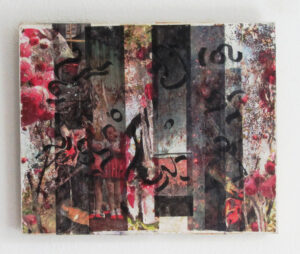
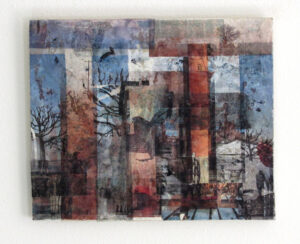
Difficult Listening for Beginners
Wed, May 1 — Sun, Jun 30, 2024
Two of my earliest memories are of listening to Hank Williams on the radio and playing with the odd electronic sounds produced by poor radio reception when moving the dial up and down. Since then my musical tastes have always been moving somewhere between these two extremes.
Having experimented with the sonic possibilities of found objects, kitchenware and electric guitars for several years I made my first musical instruments while traveling in Northern Thailand in 1989, using available local materials such as bamboo, bicycle spokes, tin cans and rice.
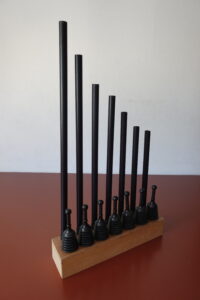
Instrument building became an excellent way for me to combine my interests in sculpture and music and early on I set about creating my own mini orchestra of original instruments and unique sounds. Soon I was invited to compose scores for live dance and films, which lead to live performance and songwriting. Along the way I met many of the Northern California instrument builders community often playing together with them in various combinations.
I have derived many of my instruments from existing folk instruments from around the world, making my own versions using unconventional materials. In most cases I have then had to teach myself how to play whatever I had made.
As time progressed I began incorporating a wider variety of sound sources into the compositions. I have used invented instruments together with electronic keyboards, sampling, looping, toys, vocals and many conventional instruments in various combinations to create both songs and instrumental music.
I grew up on Pop and Rock music in the days when there was a lot of experimentation even in mainstream music, so the influence of this music is never too far away.

Bio:
Peter Whitehead is a composer, performer, songwriter, instrument builder, multi-instrumentalist and visual artist. He works with both acoustic and electronics sounds. The instruments he builds are often based on folk instruments from around the world, and feature unusual or found materials in place of traditional ones, (e.g. a banjo made from a metal pan). His instruments have appeared in exhibitions at The Oakland Museum (’97), The L.A. Municipal Museum of Art (’97) the Vancouver Museum (’98), The Yerba Buena Center For The Arts, San Francisco (’99) , ODC Theater Gallery S.F.(’00), Gallery 60Six San Francisco (’12), Center for New Music SF (13), Bridge Arts Center, Richmond CA (’19), Ojai Arts Center CA(22), Arc Gallery SF (23), Studio Valencia SF (23)
He creates scores for film and dance and performs solo work using a variety of homemade sound sources, plus an array of more conventional instruments alongside electronic keyboards, toys and sampling.

He is also a member of Closer To Carbon, a trio featuring bass, cello, spike fiddles, sampler, percussion, toys and an array of conventional, invented & found instruments. He was a founder-member of San Francisco’s critically acclaimed Mobius Operandi performance group, known for its spectacular, large-scale, multi-media events. In this ensemble he functioned as musician, actor and musical director. (Exit Vacaville ’95/96, Xibalba, ’97). He is also an original member of the Conspiracy of Beards, a 30-member, all-male, acapella choir which performs exclusively the songs of Leonard Cohen.
For Dance he has composed several full length scores, including Giselle (Underbelly Dance Theater ’94), Come Live With Me and You’ll Know Me (Rachel Kaplan ’97), The Tree of Life ( Michelle Stortz ’97), dear (Maxine Moerman ’96), Red Tuba (Charles Moulton ’98). Anna Halprin Turns 80 (’00), Monk at the Met /Feast of Souls (Sarah Shelton Mann ‘00 – ’03 , with Norman Rutherford), Just Dancing ( Jess Curtis & Gravity ‘06), Frame Dances (Susan Marshall & Company ‘08), Adamantine (Susan Marshall & Company ’09), Quiet to Departure ( Leigh Evans ’10), Botany’s Breath ( Epiphany Dance ’13), Angles of Enchantment ( Garret/Moulton ’14), Shall we go ( 10HL ’18), XO ( Randee Paufve 18)
In 2010 he composed music for a solo by Mikhail Baryshnikov, “For You”, choreographed by Susan Marshall and performed at the Baryshnikov Arts Center NY.
His film scores include Testing the Waters (Elena Konstantinou’10), Bag It (Michelle Hill ’10), Dancing Across Borders (Anne Bass’10), The Key of G (Robert Arnold ‘06), Following Sean (Ralph Arlick ’04), American Dream 2.0 ( Jennifer Thompson ’03), City of Ghosts (Matt Dillon ’02), China Diary & 24 Girls (Eva Brzeski ‘02 & ’97), Shift (Maxine Moerman ’97), the theme music for the San Francisco International Film Festival (’97), Fortune Tell (Robert Strauss ’95).
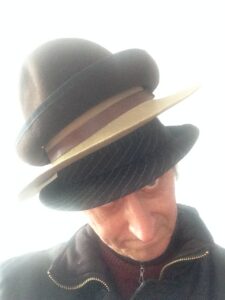
His recorded music appears on six solo CDs: Three Bags Full (Strange Attractor Records ‘98) Now This, Giselle, Under the Gun, Adamantine, The Brightness of the day is bigger than the bed – (‘01, ‘03, ‘06, ’10, ’12 – Out of Round Records), Angles of Enchantment (’12) with the group Closer To Carbon ( Out Of Round ‘01 & ‘07), with Mobius Operandi on the CD What Were We Thinking (Mobius Music ’98) and in the Ellipsis Arts CD/book of experimental musical instrument builders Orbitones Spoonharps & Bellowphones (’98) and in numerous guest appearances, especially for fellow Out of Round Artists with whom he co-founded the label in 2001.
Since 2017 he has appeared as a guest lead vocalist on four albums with San Francisco Art Rock band The Residents.
He has traveled extensively in India, Nepal, Sri Lanka, Thailand, Laos, Viet Nam, Malaysia, Indonesia & Morocco collecting music and instruments along the way.
Originally from England he has lived in the US since 1975, mostly in San Francisco and New York.
Cheryl E. Leonard’s “Wilding”
Fri, Mar 1 — Tue, Apr 30, 2024
This Window Gallery exhibit will have a reception on April 18th at 6pm. Reception with light refreshments starts at 6 followed by a talk/demo at 7 by Leonard. Admission is FREE with RSVP!
https://www.eventbrite.com/e/gallery-reception-cheryl-e-leonards-wilding-tickets-826136294897?aff=oddtdtcreator
In “Wilding,” newly-conjured musical instruments of wood, bone, shell, seaweed, and stone are combined with an assortment of graphic scores I have developed over the last two decades. Rooted in first hand explorations of untamed and re-wilded places – from the remote polar regions to right outside my front door in San Francisco – these sculptural instruments and notation experiments are part of my ongoing attempts to untangle how I can best duet with environments and ecosystems, to merge music and wilderness.
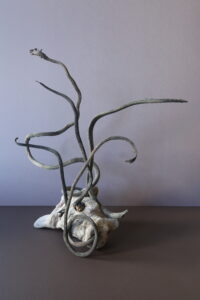
Constructed out of materials gathered in California and Norway, the instruments evoke fantastical flora and fauna. From clear, pitched tones to gritty, textural noises, these creations produce a wealth of unique timbres, tones, and ambiances when played with various techniques and amplified via microphones. In order to articulate how to produce these unusual voices and enable musicians to perform my compositions, I have invented my own systems of graphic notation. “Wilding” showcases approaches to scoring that I have experimented with while I working with natural-object musical instruments since the early 2000s.

Included are: timelines packed with intricate graphic symbols, recipes for improvisations, abstract gesture diagrams, and asemic calligraphies.
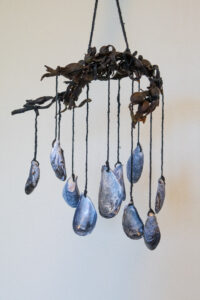
Artist Bio
Cheryl E. Leonard is a San Francisco-based composer, performer, field recordist, and instrument builder whose works investigate natural sites and ecosystems, and human relationships to them. She uses microphones and amplification to explore sonic intricacies, highlighting unique voices and soundscapes while addressing environmental issues. Her projects often feature sculptural natural-object instruments and field recordings from remote locales. Leonard’s musical research has taken her to a wide range of wilderness areas, including Antarctica and the Arctic. Her works have been presented in concerts and art exhibitions in the Americas, Europe, Japan, and Australasia. Grants awarded include the Antarctic Artists and Writers Program, American Music Center, American Composers Forum, and ASCAP. Commissions include works for Kronos Quartet, San Francisco Museum of Modern Art, and Funsch Dance. Leonard has contributed to several publications about music and sound art. Her recordings are available on Other Minds, mappa, Gilgongo, Rural Situationism, and numerous other labels. www.allwaysnorth.com
Bryan Day’s Vertical Measures
Mon, Jan 1 — Thu, Feb 29, 2024
‘Vertical Measures’ showcases a collection of invented instruments and sound art pieces that I developed after moving back to the East Bay in 2017. The pieces presented in this exhibition are constructed using upcycled common household objects, and many of them are midi-controllable through a simple keyboard interface. A recent focus in my work involves building self-resonating instruments that make use of controlled feedback loops. This shift in focus has significantly influenced my recorded work, placing less emphasis on percussive elements and more on extended textural passages. As with all my work, I aim to highlight their accidental imperfections rather than striving to fit neatly into an established framework.


Bryan Day is a sonic adventurer, painter, and inventor of curious things based in the East Bay. Using scavenged electronics, repurposed mechanical components, and amplified materials that you might find in your garage or your great uncle’s office, he re-imagines them into constructivist sound sculptures. Day has performed, taught workshops, and built sound installations across Europe, Asia, and the Americas. He spends his days designing, building and fixing exhibits at the Exploratorium in San Francisco.
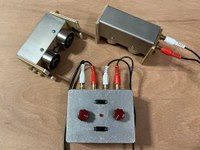

ATRIUM: Gino Robair’s Letterpress Printing as Graphic Score Generator
Wed, Nov 1 — Sun, Dec 31, 2023
Since 2018, Gino Robair has been developing letterpress-printing techniques modeled on the approach he uses as an instrumentalist, in order to transform what is normally considered a craft-based practice into a performing artform.
By applying the concept of extended techniques to the printing press, new perspectives about the tools and materials emerge. Chance operations, game-based structures, and text prompts are used as generative processes that expand the language of printing in compositional and improvisation contexts as well as refocus the activity towards a time-based, performance practice rather from its traditional results orientation.
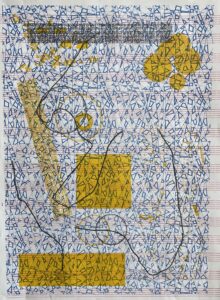
The artifacts generated by performance-based printing are the subject of Robair’s most recent research: Letterpress printing as a real-time score generator. The concept is to establish a feedback system within a performance where the printer’s output is reintroduced as input to the performers. For example, printed objects that materialize through the printer’s interactivity with other artists are presented as graphic scores intended to further inspire the participants over the course of the event.
Six of the seven prints in this exhibit—B through G—are the results of this concept, many of which have been reimagined as scores for other pieces. The score in print A is included in this exhibit as a precursor to the real-time, score-creation concept, where the practice of letterpress printing played a major role in the development of the work.
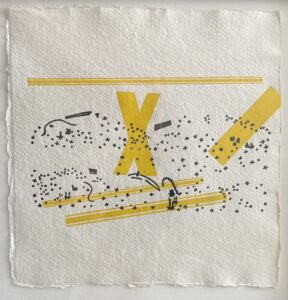
Bio
As a composer and visual artist, Gino Robair explores how scores with nonrepresentational imagery influence interpretive performances across different media—music, dance, video and theatre. He is currently a PhD candidate in Performance Studies at the University of California, Davis, developing performative models for improvised papermaking and letterpress printing. Special thanks for the San Francisco Center for the Book (sfcb.org) for the use of their Vandercook proof presses.
Victoria Shen’s Zero Player Piano
Wed, Nov 1 — Sun, Dec 31, 2023
We’re pleased to welcome Victoria Shen to the Window Gallery for November and December! Be sure to join us for her Gallery Reception on December 14th at 6pm! RSVP for this FREE event on Eventbrite:
https://www.eventbrite.com/e/window-gallery-reception-victoria-shens-zero-player-piano-tickets-758344979247?aff=oddtdtcreator
Bio & Artist Statement:
Victoria Shen is a sound artist, experimental music performer, and instrument-maker based in San Francisco.
Shen’s sound practice is concerned with the spatiality/physicality of sound and its relationship to the human body. Her music features analog modular synthesizers, vinyl/resin records, and self-built electronics. Eschewing conventions in harmony and rhythm in favor of extreme textures and gestural tones, Shen uses what she calls “chaotic sound” to oppose signal and information, eluding traditionally embedded meaning.
Her personal identity; her body; is the space her work utilizes to restructure sonic meaning. In her live performances, she proposes an exploration between meaning and non-meaning through the physical activation of noise tropes. Her probing into these melodic voids interrogate the ways we perceive value within aural experiences. The appendage-like instruments and objects she makes, exemplify Shen’s ability to embody through sound her interest in the tension created by opposition: control and chaos, the unique and the mass produced, the practical and the absurd.
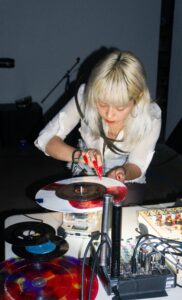
Shen’s multimedia practice extends beyond musical composition and performance to include installation and non-traditional methods of distribution. Her DIY approach to deconstructing the concepts of “materiality, value and mass production” both integrate and re-contextualize the formats of the readymade and assemblage techniques. For example, the album art for her debut LP, Hair Birth, utilizes copper to transform the cover into a loudspeaker through which the record can be played. In 2021, Shen produced a series of cut-up records in cast resin embedded with found materials, functioning not only as playable music media but as unique art objects. For recent performances, she pioneered the use of Needle Nails, acrylic nails with embedded turntable styluses, which allow her to play up to 5 tracks of a record at once. Needle Nails, Levitating speaker, and her Noise Combs are some of the objects created by her as part of an extensive repertoire of innovations in the design of sound augmentation. These sculptural elements invite the viewer to unpack one’s relationship with the material possibilities for creating sound.
Shen has performed solo across North America, Japan, Mexico, and Europe, and in Europe as a member of a turntable trio with Mariam Rezaei and Maria Chavez, as a member of hip hop group 1 Above Minus Underground, and as a collaborator with the Kronos Quartet. Some notable venues in which she has performed include Boston City Hall, the Solomon R. Guggenheim Museum, ISSUE Project Room NY, DOMMUNE Tokyo, Petreon Sculpture Park Cyprus, MUNCH Museum Oslo, and Museo d’Arte Orientale Torino. Shen has also been an artist in residence at Elektronmusikstudion EMS Stockholm SE, WORM Rotterdam NL, Kurimanzutto New York US, The Royal Danish Academy Copenhagen DK, and AUDIUM San Francisco, Bemis Center for Contemporary Arts Omaha, and Headlands Center for the Arts.
Shen currently works at the Center for Computer Research in Music and Acoustics Stanford and School of Visual Arts NY.
Piece description:
Zero Player Piano (Conlon’s Game of Life) is an homage to composer Conlon Nancarrow and a nod to the cellular automaton the Game of Life. Discarded piano parts, bass piano wire, felted hammers, tuning pegs, etc, play a generative, non-repeating composition.
ATRIUM: Derek Fenner’s Rhizomatic Will
Fri, Dec 1 — Sun, Dec 31, 2023
There is a mysterious boundary between text scores and graphic notation where language breaks down, and image takes on a deeper purpose. The scores in this exhibition arise from one such compositions: Flightlines (an Opera in Sigils), by poet Derek Fenner, written for the Cornelius Cardew Choir. “Flightlines” written during lockdown and explores issues of non-local performance, and collaborative improvisational interpretation.
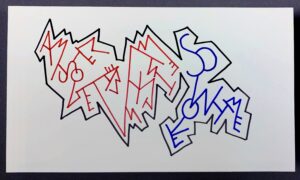
“The rhizome is a map and a tracing. The map is entirely oriented toward experimentation in contact with the real. The map constructs the subconscious. The map is open and connectable in all of its dimensions. It can be drawn on a wall, conceived of as a work of art, constructed as a political action or meditation. Perhaps one of the most important characteristics of the rhizome is that it is always multiple entryways” (Delueze / Guattari). Where are you going? Where are you coming from? What are you heading for? These are totally useless questions. Another way of traveling and moving is proceeding from the middle, through the middle, coming and going rather than starting and finishing. “Look backwards on your future and forward to your past” (Bonnie Prince Billy). “Anyway, Art [making] is a magic which makes the hours melt away and even days dissolve into seconds” (Leonora Carrington). These “sigils are the means of guiding and uniting the partially free belief with an organic desire, its carriage and retention till its purpose served in the sub-conscious self, and its means of reincarnation in the Ego” (Austin Osman Spare). “My works are not simply paintings, they are total worlds; coherent worlds, secret worlds” (Remedios Varo).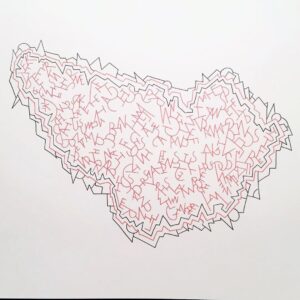
Dr. Derek Fenner is an artist, educator, and researcher working in the Carolinas. He earned his MFA in writing and poetics from the Jack Kerouac School of Disembodied Poetics at Naropa University. After a decade of experience as an art educator and administrator in the Massachusetts juvenile justice system, he completed an MA and Ed.D in educational leadership from Mills College. With over 20 years of experience in K-12 schools, his research interests include youth participatory action research as pedagogy, integrated thinking and learning, juvenile justice education, decolonizing methodologies, and arts-based research. He is the director of art education and the FOCUS Gallery at the University of South Carolina Upstate.
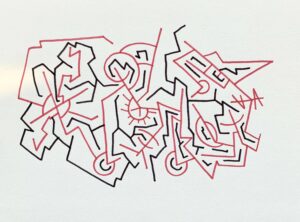

Moldover’s HappenCraft Creations
Fri, Sep 1 — Tue, Oct 31, 2023
We’re pleased to welcome Moldover to the Window Gallery for September and October! Be sure to join us for Moldover’s Gallery Reception on September 7th at 6pm! RSVP for this FREE event on Eventbrite:
https://www.eventbrite.com/e/window-gallery-reception-for-moldover-happencraft-creations-tickets-676326128657?aff=oddtdtcreator
Artist Statement:
I love music and technology. Marrying them together in new ways, while preserving traditional artistic values, is the central theme of my work. In particular, live music making features a combination of immediacy and transpersonal human connection that has drawn me to musical instrument creation. It is moments of unique joy, which occur when exploring a newly born instrument, that inspire what I call HappenCraft.
I am honored and excited by this opportunity to present a variety of my physical instruments, encompassing three distinct categories: performance instruments, playable packaging, and jamboxes. Although less visible, the software component of these instruments is vital to their design and is represented in a limited fashion here with screenshots. Also on display are photos of various kinds of instruments I was commissioned to produce. This exhibit gives visitors a window into the evolution of my designs, how they have intersected over time, and what innovations make them noteworthy.
Performance instruments
These instruments have evolved in correlation with the needs of my solo performances. They are either augmentations of my preferred conventional instruments (guitar and microphone) or are novel creations for the playback and manipulation of pre-recorded sounds (i.e. The Mojo). Original songs are my favorite compositional conduits between personal experiences and an audience. Similarly, these bespoke instruments create distinctive conduits between my favored physical gestures and sonic expressions. They give me a direct and tactile relationship with sound, facilitating the development of muscle memory, virtuosity, and a transparent relationship between movement and music that benefits both myself as performer, and my audience. The ergonomic configuration of these instruments encourages intuitive play. As my agility with them develops, I can improvise new gesture-combinations that exponentially broaden the sonic palette. Additional practicalities (durability, portability, repairability, modularity) all factor into the designs as well.

Playable packaging
At a time when many musicians struggled against the tide of online streaming platforms and declining album sales, I supported my career as a touring artist by selling an abundance of albums in playable packages. These packages function both as pocket-sized instruments and as containers for a piece of established music media, such as a CD or USB drive. What began as a novel method for injecting interactivity into a conventional CD case, blossomed into a multifaceted art form as I learned how to design printed circuit boards. I discovered that this utilitarian platform for assembling electronics could, simultaneously, be a medium for visual art, puzzles, and DIY education, while also functioning as a remarkable medium for my recorded music. I hope that fans enjoy investigating the intricate details embedded in these artifacts as much as I enjoyed designing them.
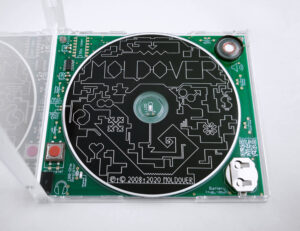
Jamboxes
These are multiplayer, electronic, musical instruments. My jambox designs have grown out of a love for interactive art, musical collaboration, and the unique joy that comes with facilitating the creativity of others. This unusual, under-explored, category of instrument presents several fascinating challenges. What sorts of interfaces will attract players, help them learn quickly, and encourage both experimentation and collaboration? How are ensemble roles (melody, harmony, percussion, etc.) divided, distributed, and connected? What kinds of sound-palettes will inspire individuals’ self expression while also cultivating collective moods and emotions? What is an effective balance of practical concerns including cabinetry, visual feedback mechanisms, multichannel sound-system configurations, size, and cost? Although these are some of the more complex devices I construct, and searching for these answers often happens over long spans of time, the seductive excitement that jamboxes generate keeps them in heavy rotation among my projects.

Commissions
Over the years, I have developed a rare combination of performer’s wisdom and technical design skills. I’ve enjoyed mastering new techniques to bridge practical limitations and artistic visions. My interest and confidence with larger collaborations has grown; therefore, I now accept offers to create instruments as contracted work. I find great satisfaction in realizing shared goals for new instruments and in seeing other artists wield them in ways I never imagined.
Artist Bio:
Moldover is an American musician, artist, and inventor of musical instruments. He is best known for coining the term controllerism, encapsulating this set of rapidly expanding artistic practices and evangelizing it for a new generation. The principles of innovation, empowerment, and authenticity engendered by controllerist methods pervade his diverse body of work which includes live performances, eclectic compositions, and the creation of totally new kinds of electronic instruments.
As a performer, Moldover has appeared at international music festivals such as Sonar, Mutek, and Coachella, and is a frequent guest speaker at schools including NYU, Stanford, and MIT. He has collaborated with renowned artists DJ Shadow, Mickey Hart, and Will-i-am, and developed new designs with leading music tech companies such as Ableton, Yaeltex, and Native Instruments. His unique, self-released playable packaging albums merge traditional music media with miniature electronic instruments, garnering both critical acclaim and commercial success. His multiplayer instruments (jamboxes) are featured at clubs, conferences, and festivals, as well as being installed at museum exhibits across North America including Meow Wolf’s Omega Mart in Las Vegas, The Museum of Making Music in Carlsbad, and The Tech Interactive Museum in San Jose.
As a pioneer, educator, and proponent of all things creative, Moldover is deeply committed to sharing inspiration and bridging the gap between traditional musicianship and modern music culture. More information about his work can be found at moldover.com.
Adventures in Casual Instruments
Sat, Jul 1 — Thu, Aug 31, 2023
We’re pleased to welcome Tim Thompson to the Window Gallery for July and August! Be sure to join us for Tim’s Gallery Reception on July 20th at 6pm! RSVP for this FREE event at Eventbrite:
https://www.eventbrite.com/e/window-gallery-reception-exploring-casual-instruments-the-space-palettes-tickets-661385711467
Artist statement:
I am an advocate and developer of “casual instruments” that have a shallow learning curve along with significant potential for deep exploration. My instruments take the form of interactive installations with immediately entertaining output that is uniquely personal, each player looking and sounding different. Recent advances in sensor technology now enable three-dimensional input, and I have found depth-sensing cameras (like the Microsoft Kinect) and pressure-sensitive surfaces (like the Sensel Morph) particularly useful for creating interfaces that are as simple and natural as finger painting. Balancing such interfaces with curated parameter presets has been an effective combination for the casual instruments I’ve deployed at Burning Man and other festivals, represented by the Space Palettes in this exhibit.
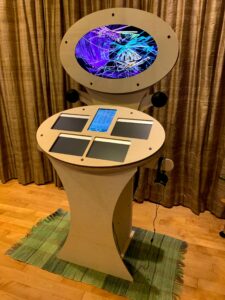
Tim Thompson bio:
Tim Thompson is a software engineer, musician, and interactive installation artist. His wide-ranging artistic work over four decades includes a programming language for MIDI, interactive installations at Burning Man and other festivals, musical performances with Playstation dance pads and QWERTY keyboards, and realtime video looping and processing with a handheld security camera. Recently, Tim has focused on the expressive potential of three-dimensional input in casual instruments for visual music, using devices such as the Microsoft Kinect (in the original Space Palette) and the Sensel Morph (in the newer Space Palette Pro). His website is https://timthompson.com.
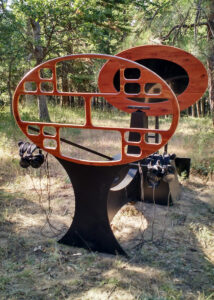
Atrium: Jaap Blonk’s Drawings with Asemic Statements
Tue, Aug 1 — Wed, Aug 30, 2023
This exhibit will run during August in C4NM’s Atrium!
Artist Statement:
My asemic writing – writing with no semantic meaning – gradually developed from my notations for sound poetry. These are functional scores with a script consisting of the International Phonetic Alphabet with a lot of added symbols of my own invention. Sometime around the turn of the millennium the signs started ’emancipating’ themselves from the task of representing sounds to an independent life as pure image. Since then I have been developing the writing in various directions: sometimes it takes the form of tiny beings, sometimes just short phrases or small clouds of signs.
In many cases I design backgrounds, mostly in greyscales, to be printed and then drawn on by hand. These backgrounds are basically made in two different ways. On the one hand, geometric structures, either based on number sequences or generated with non-linear equations. On the other hand, photos I took or scans of collages I made, that I then processed with small programs I wrote.
Artist Bio:
Jaap Blonk (born 1953 in Woerden, Netherlands) is a self-taught composer, performer, poet and visual artist.
His unfinished studies in mathematics and musicology mainly created a penchant for activities in a Dada vein, as did several unsuccessful jobs in offices and other well-organized systems.
In the late 1970s he discovered his potential as a vocal performer, at first in reciting historical sound poetry and later on in improvisations and his own compositions.
As a vocalist, Jaap Blonk is unique for his powerful stage presence and extended vocal abilities. He has performed and taught around the world, on all continents.
Blonk’s recorded / published output comprises some 60 titles: CDs, vinyl, books and cassettes.
From his sound poetry scores he developed an independent body of visual work, which has been exhibited in various countries. Selections have been collected in books by publishers in Germany, Ireland, Canada and the United States.
Send purchase inquiries to gallery@centerfornewmusic.com
AsemiQuad #61 – $45
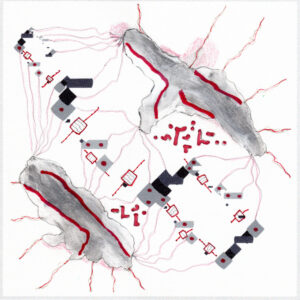
Conjecture #92 – $90

Conjecture #120 – $90

Friendly Ghosts #7 – $45
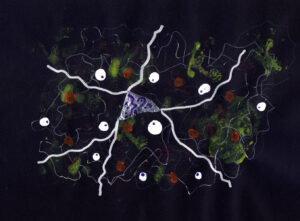
Lockdown Variation #83 – $45
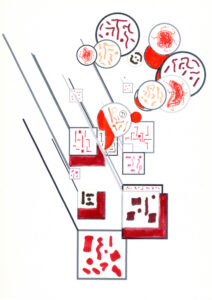
Lockdown Variation #84 – $45
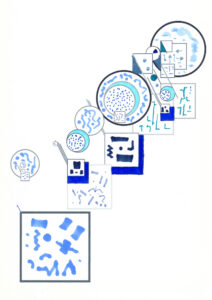
Possible Garden #18 – $90
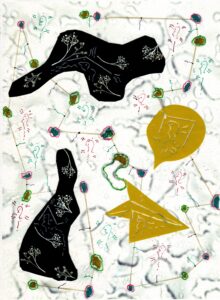
Possible Garden #58 – $90
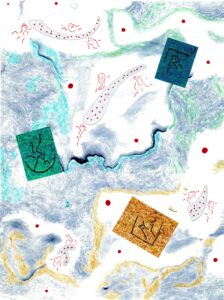
Somnambulism #83 – $45
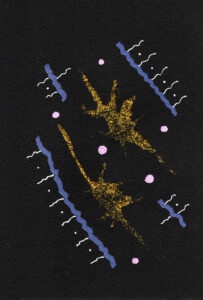
Somnambulism #90 – $45
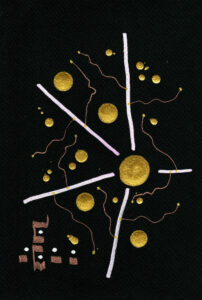
A list of my recent artist’s books includes:
111 Recipes (Xexoxial Editions, West Lima, Wisconsin, 2019)
Garbage Collection (Redfoxpress, Argyll, Ireland, 2021)
Possible Gardens (Post-Asemic Press, Minneapolis, 2022)
Stampscapes (nOIR:Z, Ontario, 2022)
AsemiQuads, Timglaset Editions, Malmö, Sweden, 2023)
Books can be ordered here: https://jaapblonk.
Atrium: Three Part Harmony
Thu, Jun 1 — Sun, Jul 30, 2023

June 1-July 30
Kyte Tatt is an American-born mixed media artist based in Berlin Germany. Kyte has been honing his skills as an artist for many years. It was in 2015 after relocating himself to his beloved Berlin, that Kyte began painting. A natural autodidact and creative, Kyte quickly developed his visual language as a painter. Having lived and traveled in a caravan in the USA for nearly a decade before his move to Europe, Kyte was in primary involvement in several art communities and projects there. The culmination of his work and experience result in his work today

Just as a diamond is formed through prolonged intense pressure on decaying matter, Kyte is an artist whose creations are formed through the prolonged intense pressures of a decaying world. “ I believe art says something about the human condition. “ explains the artist.

Kyte Tatt’s main endeavor is currently on his Gardens of Liberty collection where his raw and gestural marks and splashes of color can be characterized as part abstract and part impressionist; part rough and part gentle. Look once and you find violent brushstrokes and broad movements, look again and find poetry. His spectrum of media includes acrylic, house paint, charcoal, graphite, soft pastel, and even coffee. Kyte hopes to remind and reconnect the viewer back to nature by showing its power and diversity in a strong yet delicate visual language.
Music Maker Festival
Mon, May 1 — Fri, Jun 30, 2023
The Maker Music Festival celebrates the makers of innovative, experimental and just
plain unusual musical instruments.
Currently, it is a virtual community of over 300 makers from around the world. The website is composed of a campus of “buildings” that each house a collection of exhibits. Every year, the campus grows as more exhibits are added

“Samson, Drummer in a Suitcase”. “Samson” is a portable percussion unit housed in a vintage suitcase. It can be remotely controlled by any Bluetooth MIDI enabled sequencer. Maker: Josef Szuecs. Location: SF Bay Area
What is a music maker? Needless to say, there are many types of projects that fit into the mold. The fundamental music maker has crafted their own unique musical instrument. It may be made from traditional materials, scrap materials, modified electronics, altered playback devices, electromechanics, or an AI driven robot. The works also include non-physical works like algorithmic music and interactive applications.
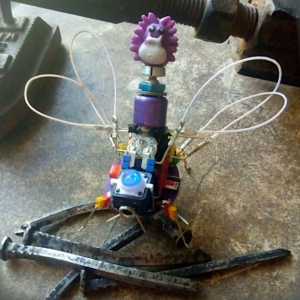
“Cicadas, Sound Sculpture Devices”. A Cicada is a noise~rompler, and rompler is an electronic musical instrument that plays pre-fabricated sounds based on audio samples. Each of Cicada has two ways to change prefabricated sound: by a potentiometer and by photoresistor. Different Cicadas can be connected to each other and mix their sounds directly, without a sound mixer. In addition, also, it is possible to make more complex noise~sound~design and connect into Cicadas prepared modules from children’s toys.
Atrium: Speed of Silence
Fri, Mar 17 — Mon, May 1, 2023
SPEED OF SILENCE is a chronicle in pictures and sounds of the passing of the world as we move through it. Photographs in the show and book derive from a 13,000-mile road trip through 37 of the United States undertaken in fall 2020, in the depths of the Covid pandemic. Empty towns and landscapes full of slipping silence. Darkness arising out of the blurring, fading light, going by in a heartbeat. What is the sound of things as they disappear?

Artist Statement:
Some of these images come from a 13,000-mile road trip through 37 of the United States undertaken in fall 2020, in the depths of the Covid pandemic. Empty towns and landscapes full of slipping silence. Darkness arising out of the blurring, fading light, going by in a heartbeat. What is the sound of things as they disappear?
My principal goal with photography has been, always, to frame an armature of energies in dynamic interplay. These are not records of events or people, or views of the past, nor are they meant to foster a specific response or conclusion. They are states, to be experienced fresh upon each viewing.
Tom Djll’s electronic music compositions for the SPEED OF SILENCE book were developed alongside the photographs with the intention of presenting the sonics with the visuals. An immersive synaesthetic experience, without computer screens.

Local musician, teacher, printer and raconteur Gino Robair will put Djll on the witness stand to try to unearth his ideas around sound, silence, and images, and perhaps demonstrate his wicked John Cage impersonation. To round out the evening, the acoustic trio Brittle Feebling will play a set of improvisations that further blur the boundaries of sound, silence, gesture, and agency. Brittle Feebling consists of Kanoko Nishi-Smith, koto; Jacob Felix Heule, bass drum and cymbals; and Tom Djll on trumpet with attachments and deconstructions.
Shape Studies
Thu, Mar 2 — Sun, Apr 30, 2023
Shape Studies features suspended sculptural ceramic bells with a stunning sound. Made by Vancouver, Canada based interdisciplinary artist Roxanne Nesbitt, these pieces are crafted from porcelain and bone china clay. Nesbitt creates pieces that bloom with gradual physical transformations. These processes result in musical scales with incremental changes in timbre and pitch. Shape, colour, and texture are employed to extract full, robust sounds from seemingly delicate materials. Nesbitt uses a combination of ancient mathematical concepts and freehand intuition to craft these works, which have been described as “resonant magic” and “other worldly.”
Viewers are able to play the pieces with the mallets provided in the gallery.
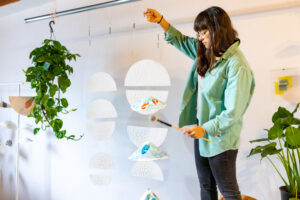
Artist Bio:
Roxanne Nesbitt is a designer, musician, composer, and sound artist of Indo-Caribbean and European ancestry. Following formal studies in classical double bass and architecture, Roxanne works between the fields of music and design. Her research explores radical instrument design, the meeting place of composition and improvisation, sculptural ceramics and participatory sound installation. Roxanne collaborates with instrument designers, musicians, composers, and choreographers to create work.
Her instruments have been played at Gadeamus Muziekweek in Utrecht, November Music in Den Bosch, Bauchhund in Berlin, Array Space in Toronto, and the Western Front in Vancouver. Roxanne has made instruments and sound sculptures for violinist Ilana Waniuk, composer Niloufar Nourbakhsh, the International Contemporary Ensemble and many self-initiated projects. She celebrates process making work that is intimate, inquisitive, and exploratory. Roxanne is currently based on the unceded territories of the Musqueam, Squamish, and Tsleil-Waututh Nations (Vancouver, Canada).
http://roxannenesbitt.com/

Artist Statement:
For as long as I can remember I have been attracted to sound. First through playful curiosity, building make-shift instruments from household items. As a child of a Trinidadian immigrant, the steel pan is intrinsic to my initial interest in instrument design. Growing up, I was surrounded by photos, drawings of steel pans, miniatures pans and Calypso and Soca music. As a child, I did not understand the political and social implications of transforming colonial garbage into a complex and stunning instrument. I did not grasp the resilience required to create this new instrument after the traditional instruments of your culture had been stolen and outlawed. Although I could not fully appreciate the depth of this design, I felt from an early age that an instrument was something anyone could make to fulfill a need.
Clay is currently my preferred musical medium because of its malleability and connection to the domestic realm. I first became curious about ceramics while listening to the sounds of colliding bowls and cups while washing dishes. How can we celebrate our own unique existence through sound? In considering the transformative possibilities of sound, the ability of vibration to bring the mind back to the present moment while also hearing timbres that my grandmothers and great grandmothers might have heard in their kitchens, I still feel that I can make any shape with clay.
I believe that new instrument design can help empower all of us to explore music and sound free from the toxic perfectionism still prevalent in many types of music practices today. Perhaps, by exploring how to build and play new instruments, these untethered vessels can help us to focus more on the sound an instrument creates, rather than the success of playing it to an established standard.
Before focusing on experimental music, I completed formal studies in classical music and architecture. In both of my degrees, I created opportunities for myself through directed study courses to study the physics of sound, sonic phenomena, and traditional musical instrument design. This research directly influences my work designing instruments, and making music with them.
To make musical instruments, I combine ancient tools, techniques, instrument design formulas, with new processes of exploration. I apply established formulas for tuning to a-typical shapes. I create musical scales by gradually transforming shapes. I embrace the fluidity of clay to explore a multitude of approaches. Even when working with mathematical formulas, timers, and precise measurements, I privilege my intuition.
Queering the Instrumentarium
Thu, Feb 2 — Tue, Feb 28, 2023
The performing arts have a deep and significant footing in queerness and while performing arts spaces are not inherently queer, they are essentially other than ordinary and quite often fabulous. Music is a queer art, it has no gender, and arouses feelings beyond gender and relationship boundaries. Music is the drag our feelings wear when they come out for tips and instruments are the queer body of music.
While the instruments of the orchestra feel dominated by old white male money and conservative values, at the experimental fringe where we imagine new possibilities there is ample room for a rainbow of expression.
The window gallery for invented instruments sits at the heart of the SF Transgender Cultural District. To speak from and to the community, we have commissioned 3 queer artists to explore the concept of “queering the instrumentarium.”

Pink and pearl rhinestone guitar
Oscar Gallegos Zamora
Artist Bio:
Oscar Gallegos Zamora is a gay collage and assemblage artist. He grew up in the suburbs of Orange County after immigrating to the U.S. from Mexico. He moved to San Francisco at 18 to study fine art at San Francisco State University. He lives and works in the Castro where he helps to coordinate local art events like the Castro Art Mart. He is an avid collector of vintage physique magazines and queer art. You can see more of his art on his website oscargallegos.com or on all social media at @thecandycoven
Artist Statement:
My assemblage work consists of found objects such as weapons, animal skulls, and figurines which are painted and hand-stoned to be transformed into sparkly, rhinestone-encrusted art objects. These sculptures focus on beautifying the darker parts of my personal experience as an HIV-positive, gay, femme man. The bedazzled weapons relate to my ever present anxiety of being gay bashed while my animal skulls acknowledge my ongoing fear of dying of AIDs due to a lack of access to proper healthcare.
Ten Instruments I Never Learned To Play
Michael Jaecks
Artist’s bio:
Michael Jaecks is an artist and queer sober housedad living and working in Minneapolis, MN. He thinks of himself as an Aries, who doesn’t take stock in astrology, except in situations where it can conveniently explain away his bad decisions.
Artist’s Statement:
My current work is a daily discipline guided by memory, whimsy, and interactions on social media. The fantastical, sometimes surrealist results sometimes prompts a viewer to suspect I’m under the influence of some drug, disorder or spell, but that couldn’t be further from the truth. Instead, I hope the viewer considers the possibility that the work itself is a psychoactive prescription I’ve written for them, metaphorically speaking.
A Sureal Sonata
Alisson Gothz –
Artist bio:
Coming from the punk and goth subcultures, Alisson Gothz started experimenting with make-up and art by the age of 15. Artists such as David Bowie and Salvador Dali inspired his looks which soon turned him into a well-known avant-garde drag performer in his native country of Brazil.
As the idea of becoming a walking piece of art grew stronger, he started taking self-portraits to immortalize these creations. These portraits grabbed the attention of curators who displayed the works in international art galleries.
Alisson moved to Oakland/California (USA) almost ten years ago setting aside his art to focus on his career and new relationship. He regained his artistic spark after working with queer youth and minorities in desperate need to take a journey into self-discovery and self-love. He started using his creations to inspire people and make them feel they are worthy, they are loved, and they can become their own masterpiece.
Alisson identifies as a queer, non-binary artist who uses any/all pronouns.
Website: www.alissongothz.com
Instagram: @alissongothz
Artist Statement
Beauty is in the eye of the beholder. You only see the beauty in my portraits because you have a divine beauty inside of you. With this divine beauty inside of you, you can express yourself through that and become empowered. You share this beauty with others and surround yourself with nothing but good vibes.
This process allows you to become your own masterpiece – you celebrate your own uniqueness and don’t let anyone sculpt you into something you’re not.
When I was a teen, I found the punk and goth subcultures in my native country of Brazil. The freedom to express oneself through clothes, art, and makeup took hold as I discovered David Bowie, Andy Warhol, Salvador Dali, and Leigh Bowery. I began experimenting with makeup, using my face as a canvas, and transforming my body into works of art that mirrored the icons who inspire me. My looks took to the stage, and I became a well-known avant-garde drag performer.
The stage was not enough. I wanted my creations immortalized, so I started taking self-portraits and shared them with friends and on social media. My portraits grabbed the attention of curators all over the world, and they included them in shows, campaigns, and galleries in Sao Paulo, Rio de Janeiro, Madrid, Paris, Amsterdam, Belfast, San Francisco, and New York.
In 2013, I moved to Oakland, CA. Navigating a new country as an immigrant Latinx artist took all of my attention, and I focused on my career and personal life. I felt adrift. I needed inspiration.
I started working with queer and immigrant youth who were searching for themselves and representations of who they could be. My artistic practice reignited, and I realized my art was more than the paint on my face, the costumes I wore, and the photos I took. My art is a journey into self-discovery and self-love, and it can be used to inspire others, letting them know that they are worthy and loved and their own masterpiece.
Now, my work takes a critical view of social and cultural issues. I deconstruct the various dimensions of gender and propose a conversation on identity, prejudice, racial, and sexual differences.
My name is Alisson Gothz. I am an international artist who bridges diasporas and icons.
And you are the artist of your own life.

Patterns of Convergence
Thu, Nov 3 — Sat, Dec 31, 2022
Nathaniel Ober: Patterns of Convergence
Nov 3-Dec 31
Reception at 6
Talk/demonstration at 7
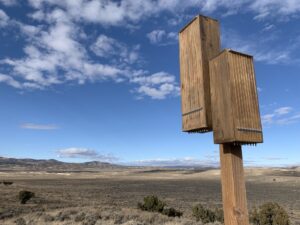
Nathaniel Ober is an internationally known experimental digital artist who has a unique hybrid
creative practice that spans installation, sculpture, sound, instrument building, digital prototyping
and astrophysics. He engages audiences by sharing listening experiences from the natural
world with processes of sonification. These experimental works can be experienced in the field
or through his multi-sensory immersive installations.
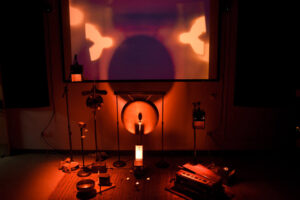
Ober’s work has been featured nationally at the Yerba Buena Center for the Arts in San
Francisco, and internationally at the Parque Explora in Medellín Colombia, Arteles Creative
Center in Finland as well as the International Symposium on Electronic Art (ISEA).
From 2009–2013 Nathaniel was program director of multimedia and graphic design at the
Raffles Design Institute in New Delhi, India and Colombo, Sri Lanka. Ober holds an MFA from
the Digital Arts and New Media program at the University of California, Santa Cruz, and a BFA
from the Columbus College of Art and Design.

“Patterns of Convergence”
– Nathaniel I. Ober
My work combines art, technology, music and astrophysics to convey information from the
natural world into creative ideas that can reveal the interconnectedness of life and the patterns
and forms that shape who we are and where we come from. The merging of the arts and
sciences combines multiple disciplines, bridging new understandings in how we interpret and
exist within our environment.
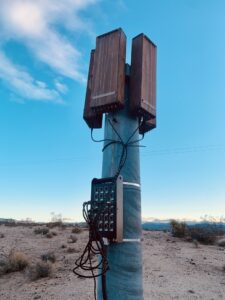
I explore the natural world through sound and work with data for sonification purposes as well
as natural forces such as; light, wind, water and trees. I aim to create works that are not just
influenced by the environment, but physically rely upon an intimate collaboration with the
elements. By doing so, I am reminded that nature is not something to be tamed, but something
to learn and grow from.
This exhibit displays a variety of hand-built autonomous instruments created for various
installations and performances over the past ten years.
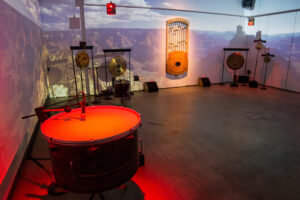
An unexpected composition arises from the asynchronous rhythms and melodies performed by
each individual instrument as they converge into a single movement of sound. The installation
begins with the “Orrery Harp” which plays its melody based on the orbital periods of planets
within our solar system. Their earthly counterparts, (two electro-acoustic tanpuras) are
programed to create a drone that accompanies the celestial soundscape. These three
instruments create a circle of pitches that fall in and out of harmony and time in perpetuity.
While some instruments reveal timescales that mirror terrestrial motions, others playback
recordings of past events. An outcropping of aeolian harps played by the wind are documented,
recorded and played back through transducers mounted within the harps bodies. A single
acoustic guitar is set in motion strumming a chord indefinitely suggesting times perpetual
motion. Together, these instruments provide an incomplete narrative of space and time while
creating patterns of convergence.
Atrium Display: Artificial Scores for Live Music
Tue, Nov 15 — Sat, Dec 31, 2022
The question of authorship is as old as ego. Most folk songs can live for generations quite happily without a named composer and are essentially immortal as long as someone remembers them; but when music doesn’t originate from composers, where does music come from?
Music which does not originate from composers originates from musicians. The resulting performances lean heavily on a generation of talent trained in free improvisation, brought up on interpreting graphic scores and visual notation; a generation highly entangled with their own technologies.
AI software like MidJourney and Wombo are offering artists unprecedented access to hack human creativity with digitized imagination. The work is familiar yet strange, stunningly ordinary, because its source material is the breath of organic expression. In this exhibition we explore scores, instrument design and musical interfaces created using AI software.
Perhaps in the future there will be no more need for composers or musicians, no reason to build instruments or make sounds; perhaps we will all be enjoying our AI generated music-alternative personalized soundtrack. With the question of authorship out of the way we may have room to ponder if, without novel human expression, it is still “art”.
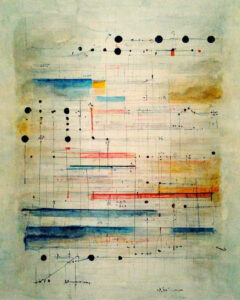
mIEKAL aND lives outside the constraints of academia in the most lush and rural part of the unglaciated Driftless area of southwest Wisconsin. Choosing to focus on creating wilderness and abundance surrounded by the perfect setting for limitless imagination his course of action includes demonstrating alternatives to inbred aesthetics, delighting in the play of DIY culture, and making art and writing that is both anarchic and noisy.
Son of Witz makes comics, paintings, album covers, and now, apparently, experiments with this weird GAN text to image tool. He’s not sure what to make of it all…
David Samas is a queer, SF native polymath composer, conceptual artist, wilderness advocate, poet, and wizard working in the grey areas between science, magic and art. His work has been shown in the Asian Art Museum, the Oakland Museum of CA, the Diego Rivera Gallery, the DiRosa Collection and the Canessa Gallery.
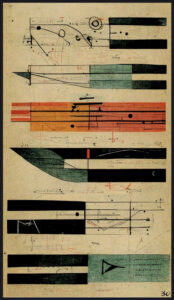
Growing up in his father’s picture frame shop and art gallery on the North Shore of Oahu, Hawaii, Kai Laigo is no stranger to the arts. After gravitating towards music in his teens and working in that industry ever since, he has returned to creating visual art in the form of artistic renders as well as animation. Releasing art and music under the name “Aquamaster”, Kai has been shown in NFT Magazine #2 (from My Creative Images), features on a (music) single released in Japan by Torao Hikariyama, and has also been shown at the HIVE gallery in Downtown Los Angeles. Kai prefers to use Krita, Blender, and REAPER in his workflow, and has been eagerly experimenting with the new generation of A.I. assisted image generation tools, such as Stable Diffusion, Automatic 1111, and MidJourney
With an interdisciplinary career blending classical training in cello and composition, sound/audio data research, and innovative computational arts education, Margaret Anne Schedel transcends the boundaries of disparate fields to produce integrated work at the nexus of computation and the arts. She has a diverse creative output with works spanning the interactive multimedia opera The King Listens, virtual reality experiences, sound art, video game scores, and compositions for a wide variety of classical instruments or custom controllers with interactive audio and video processing. She is internationally recognized for the creation and performance of ferociously interactive media and won the 2019 Pamela Z Innovation Award. In her spare time, she curates exhibitions focusing on the intersection of art, science, new media, and sound while running www.arts.codes, a platform and artist collective celebrating art with computational underpinnings.
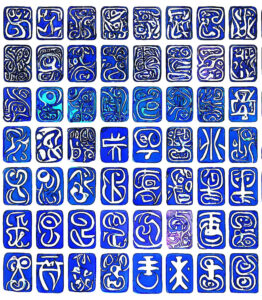
The Harmonic Series Gamelan
Mon, Sep 5 — Mon, Oct 31, 2022
The Harmonic Series Gamelan is a special project of Pet the Tiger Instrument Inventors Collective, directed by David Samas. Inspired by a Harrison/Colvig instrument which was used for constructing just tunings, the HSG is a collection of over 30 instruments created by 17 inventors, all tuned to the Schumann Cavity Resonance as a fundamental. The ensemble performs songs and incidental music including exotic textures, whimsical pairings and tightly composed harmonic music.
This exhibition includes works by Bart Hopkin, Stephen Parris, Daniel Schmidt, Peter Whitehead, Bill Wesley, Sasha Leitman, Brenda Hutchinson, Ian Saxton, Krys Bobrowski, Sudhu Tewari, David Samas, Joshua Reff, and Randy Masters.


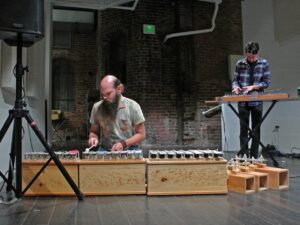

ATRIUM DISPLAY: THE EVOLUTION OF SKATCH
Sat, Sep 3 — Sun, Oct 30, 2022
Tom Nunn, the Evolution of Scatch
Sept 3- October 30.
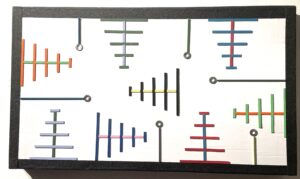
Tom Nunn designed, built, and performed with original musical instruments from 1976 to 2022. His instruments use commonly available materials, are sculptural in appearance, utilize contact microphones for amplification, and were designed specifically for improvisation with elements of ambiguity, unpredictability, and nonlinearity. Bearing little or no resemblance to conventional instruments, Nunn’s constructed instruments are free of the hierarchy that separates non-musician or amateur from virtuosi; there was no history of technique or correct way to play these instruments. Considered in the social context of the collaborative groups in which they evolved, Nunn’s instruments can be seen to embody idealized concepts of social, political, and spiritual activism. Nunn’s instruments can also be seen as a form of composition; a compositional framework or a system with which the performer/composer interacts in real time. Nunn’s catalog of instruments are the result of a lengthy period of refinement of instrument designs that began as a freely improvised process of experimentation and discovery.
Join us for Remembering Tom Nunn on October 8 to celebrate the life and work of the featured artist
Window Gallery: Orchestra Obscura
Fri, May 13 — Thu, Jun 30, 2022
Orchestra Obscura is a collection of works that incorporates sensors, microcontrollers, and electronics to explore new ways of using movement and gesture in creating live electronic music. Sometimes the physical actions of the performer clearly map to the resulting sounds one hears, sometimes the connections are completely hidden, but more often they are partially obscured, leaving the listener to make their own connections and adding another level of artistic interpretation.
While all the works involve sound and electronics in some way, the end products are as diverse as the students and their interests. Many combine the inherent elements of other practices and hobbies with music making, such as RC car racing, martial arts, storytelling, costume design, and skateboarding. Others dive into new analog and MIDI instrument design, beyond the piano keyboard and drum pads. Others repurpose and modify electronic toys, injecting a playful quality. And still others go inwards, into the human body finding more subtlety changing movements to control sound. Likewise, the resulting music covers a wide range, from experimental to EDM, ambient to hip-hop, with each artist bringing their own musical experience and interests to their project.
Justin Alley – ALLOPHONE
Sheena Chand – Whack – A – Melody
Michel Conrad and Laura Cox-Conrad – SeaCape
J & Addams – Dragonsong
Quinn Manely and Zohar Aguilar Noriega – RC Vibes
Louise Morin – Ruby Soundscape
Sandy Napkin – Synthescrima
Shawn Westmoreland and Arash Moradi – Möbinix and T-Midi
Tom Yaniv – Mix Thrasher
Alex Zharchuk – Bioelectric Sound Experiment 01

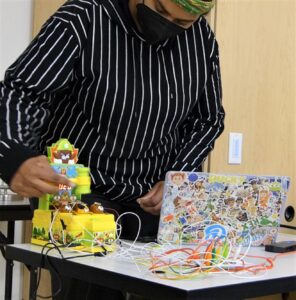

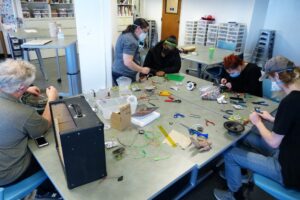
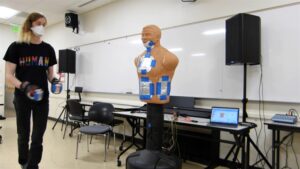
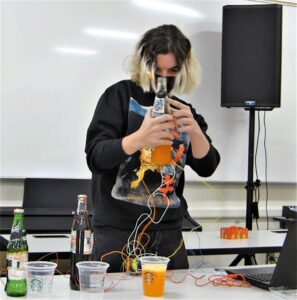
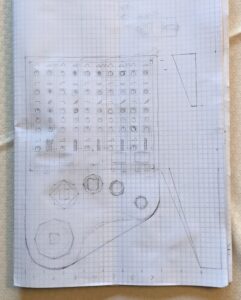
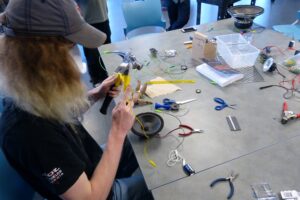
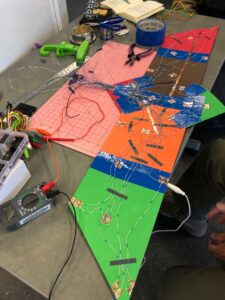
Grist from the Mills
Tue, Mar 1 — Sun, May 1, 2022
The Window Gallery presents an exhibit of pieces from past and present professors at Mills. Featuring works from Chris Brown, Fred Frith, The Hub, Roscoe Mitchell, Maggi Payne, Laetitia Sonami, Wendy Reid, Daniel Schmidt.
Join us for an online reception and discussion with the artists! More info here.

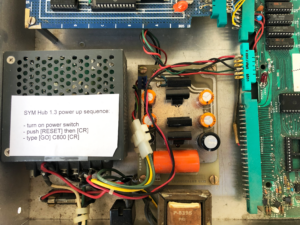
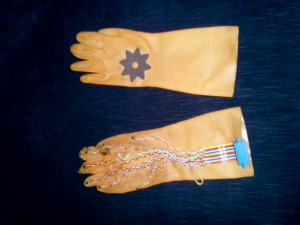
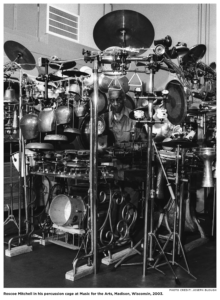
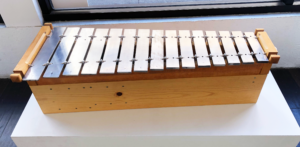


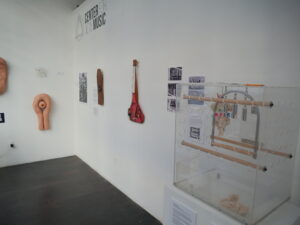
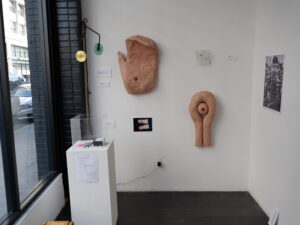
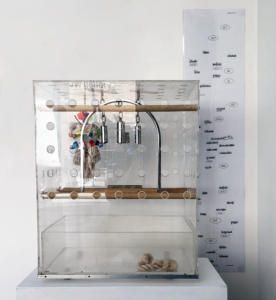
somewhere else by Aaron Soloway
Sat, Jan 1 — Mon, Feb 28, 2022
somewhere else is meant to take you out of your current setting, out of your current moment, out of your current focus to somewhere else. It is designed to be experienced only from outside the gallery. Stand on the circle and your background will fade away as you hear the sounds from somewhere else.
Join us for a streamed discussion about the work on February 24.
There are over 50 one minute recordings of different beaches that play onto the street using the glass windows as speakers. The visual captures the outlines of your features and uses feedback to preserve the shape of your movement in hopes of slowing down time a little.
Please note: Volume is turned down during business hours. For the full experience, please visit the Window Gallery at the following times:
- Monday–Friday: 8am–9am, 5pm–10pm
- Saturday–Sunday: 8am–10pm
About the Artist

Aaron Soloway is an Experiential Designer. His point of view has been wrought by deep work in human-centered design, research and development, extensive audio engineering, and a lifelong devotion to music. He has worked at a hardware startup reverse engineering mammalian auditory biology to create a biomimetic sound localization sensor, designed across a wide range of industries at IDEO, and taught at California College of the Arts. In addition to playing bassoon, piano, and guitar he has also designed a number of new instruments.
Aeolian Day: Celebrate the Sound of the Wind
Mon, Nov 1 — Fri, Dec 31, 2021

In partnership with Thingamajigs.

Presenting Bay Area instrument inventors’ collaborations with a force of nature, Aeolian Day is a recurring festival in Oakland, CA, mounted by Thingamajigs. Aeolian Day exhibits solo works and installations created with local OUSD schoolchildren. The event fosters the creative interplay of art, music, and science through innovative sound sculptures.
Join the artists for a reception celebrating their works on 12/16 at 6pm.
Aeolian Day is made possible in part by the generous support of the Alameda Art Commission, Arts for Oakland Kids, California Arts Council, City of Oakland Cultural Funding, and individual donations from the community.
Thingamajigs is a genre-crossing arts organization that promotes music and other art forms created with made and found materials or alternate tuning systems.
Our mission is to develop and nurture the exploration of alternate materials and methods of creating sound and promote collaborative efforts between artists and local communities.
With open workshops, performances, and a robust education program, we welcome audiences/participants of all ages and backgrounds to join in the tradition of Bay Area visionaries such as Harry Partch, Lou Harrison, and John Cage.
The Artists
Krys Bobrowski is a sound artist and musician. In addition to concert works, she has created interactive installations and designed day long performances. Krys often transforms natural and everyday objects such as kelp and bowls into musical instruments.
Larnie Fox is a visual and sound artist known for monumental bamboo sculpture, sound installations, performances and painting. His kinetic/sound sculptures and new instruments have been shown in numerous one-person and group shows and performances in the SF Bay Area and nationally. He is a founding member of 23five, a non-profit to promote sound art, directed the Crank Ensemble who performed on hand-cranked instruments he built, and currently is performing with the new music group Contraption Quartet. He holds an MFA in Painting from the University of Utah and is the former Executive Director of Arts Benicia and former Director of the Children’s Fine Art Program at the Palo Alto Art Center. He lives, works and collaborates with his wife Bodil in Benicia.
Sudhu Tewari is an electro-acoustic composer, improvisor, and tinkerer in sound, kinetic and interactive art. He has been called a professional bricoleur, junkyard maven and young audio-gadgeteer. An early interest in disassembling alarm clocks and coffee makers gave rise to electro-acoustic instruments constructed with the remains of discarded stereo equipment, kinetic sculptures and sound installations. Sudhu builds audio electronics, acoustic instruments, kinetic sculptures, interactive installations, wearable sound art and recently began working with bicycles with wide variety of end results.
Tom Nunn has designed, built and performed with original musical instruments since 1976, having received a B.Mus. and M.A. in music composition from the University of Texas at Austin and S.U.N.Y. Stony Brook, and post-graduate work at U.C. San Diego. His instruments typically feature commonly available materials, are sculptural in appearance, utilize contact microphones for amplification, and are designed specifically for improvisation with elements of ambiguity, unpredictability and nonlinearity.
David Samas is a queer, SF native polymath composer, conceptual artist, wilderness advocate, poet, and wizard working in the grey areas between science, magic and art. His work has been seen in most major Bay Area museums, and concert halls. He is director of Pet the Tiger, an instrument inventors collective and curates the Window Gallery for invented instruments at the Center for New Music SF. He was curator of the Meridian Gallery’s Composers in Performance Series, six seasons at the Turquoise Yantra Grotto, and the director of the 18th Annual Thingamajigs Festival and MicroFest North.
Animal Magnetism: Tape Music of the 2020s
Wed, Sep 1 — Mon, Nov 1, 2021
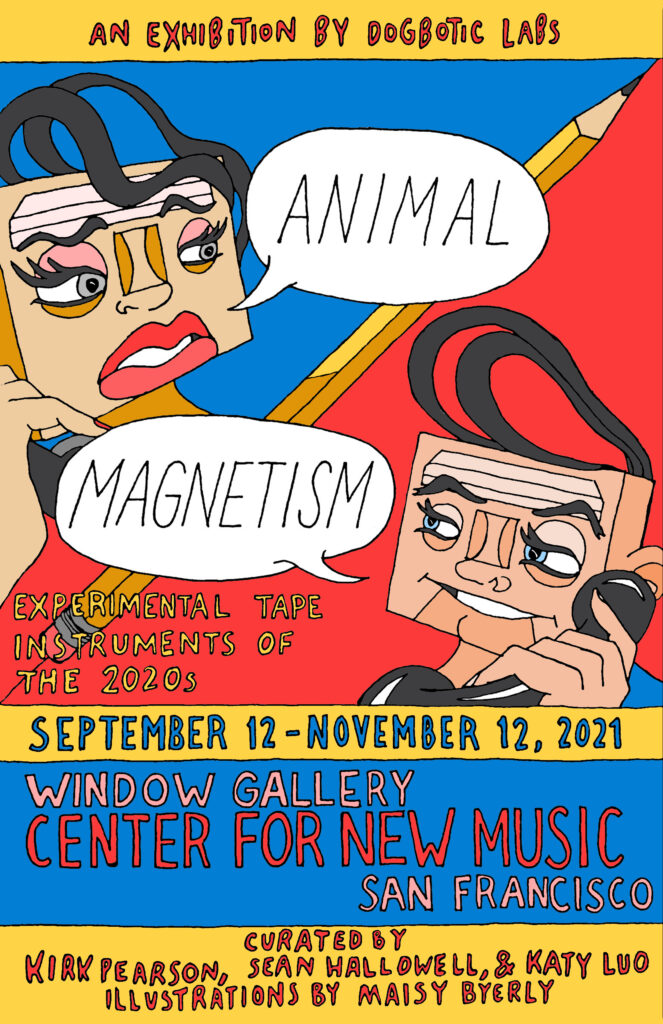
Join us on October 18 at 6pm for a discussion of this menagerie of instruments, compositions, and other audio experiments that explore the myriad musical uses of magnetic tape in the 21st century.
Watch the broadcast:
A menagerie of instruments, compositions, and other audio experiments that explore the myriad musical uses of magnetic tape in the 21st century.
About “Animal Magnetism”

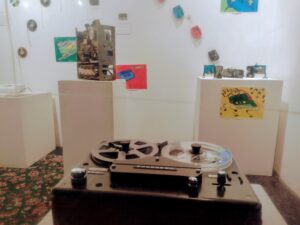
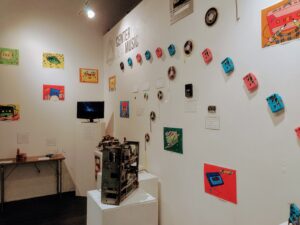
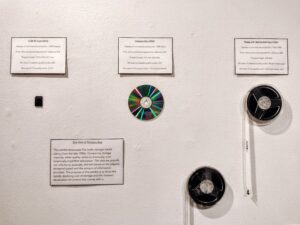
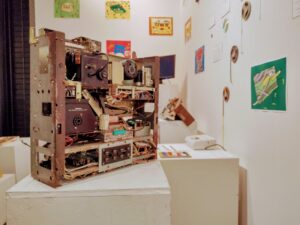
About the Curators
Composer, inventor, and multimedia artist Kirk Pearson spends half their time putting stuff together, and the other half taking stuff apart. They have written music, built installations, and designed experiences for the the New Museum, the American Museum of Natural History, Museum für Kommunikation Bern, and for hundreds of musical ensembles, films, stage productions, and new media projects. In 2017, Kirk was named a recipient of the Thomas Watson Fellowship, through which they spent a year traveling the world composing works for experimental instruments. Pearson has a BMus from Oberlin Conservatory, which people seem to think is important so we’ll mention it here. They cut their sandwiches diagonally.
Sean Russell Hallowell is a musician and composer based in San Francisco, CA. Building on musique concrète and modal counterpoint in equal measure, he makes music for phonons, electrons, and photons that elaborates the potential energy within sounds and sound-making devices. Concert works and installations of his have been showcased at festivals across the US as well as in Latin America, Asia, the UK, and Europe. During the summer of 2021 he will be an Artist-in-Residence in the Westfjords of Iceland as part of ArtsIceland’s Kol&Salt program, for which he will compose a site-specific audiovisual work. He holds a PhD in Medieval polyphony from Columbia University, in which cosmically-attuned tradition his experimental music is steeped.
Katy Luo is a pianist, educator, and lecturer of music at both the University of Hawai‘i at Mānoa and the University of Hawai‘i at West O‘ahu. For the last 25 years, Katy has taught and performed extensively throughout the US, mostly in New York City, where she resided for 14 years. Katy’s performing experience ranges from the works of the classical masters performed on period instruments to the works of Cage, Ligeti, Schnittke, and other contemporary composers. Katy is an alumna of the Young Musicians Program, a community outreach program at the University of California at Berkeley. Her passion for community organization led to her involvement formerly at the Boys Choir of Harlem and at the Bloomingdale School of Music, where she was both Resident Teaching Artist and the Founder/Director of A4TY (Album for the Young): Student New Music Project, a program that provides children the opportunity to compose original compositions for fellow young musicians and to premiere works written by living composers. This program, now in its 16th season, was a recipient of the National Endowment for the Arts Grant. Katy holds a BMus from Oberlin Conservatory, and a M.M. & D.M.A from Stony Brook University.
About Dogbotic Labs
Dogbotic is a creative laboratory for music and sound based in Berkeley, CA. As part of a larger mission on promoting cultural equity, Dogbotic began hosting radical experimental arts workshops in the midst of the COVID-19 pandemic. One of these workshops, “Cassette Hacking,” directly inspired this exhibit and the majority of its works were forged directly from the workshop.
The outgrowth of our passion for making technologically-enriched, culturally-aware music and sharing it with you (yes, you!), Dogbotic Labs is the collaborative enterprise of musicians Kirk Pearson (they/them), Katy Luo (she/her), and Sean Russell Hallowell (he/him). We have each followed our own unique path to the Labs — Kirk as a composer for film, stage, and multimedia with works and installations featured all over the world; Katy as a decorated concert pianist and arts community organizer who has founded award-winning educational initiatives; and Sean as a composer of experimental music whose works for audio and audiovisual media have been showcased internationally at festivals and galleries alike. Across our diverse interests and backgrounds runs a common thread — specifically, our mission to demystify areas of music education traditionally known as “theory” and “technology.” By promoting diversity of thought and encouraging critical thinking about ways in which we collectively make, share, and think about music, we at Dogbotic Labs aim to make music technology a bit more human, human beings a little more technical, and everyone more appreciative of the special type of community music articulates through us all.
Dogbotic Labs Mission Statement
• We research innovative uses for audio tech that bridge the worlds of artistry and scientific exploration.
• We believe that a lab can serve as a playground for both the construction of new media as well as a critical voice for how it is used.
• We teach as a means to promote conversations about cultural equity, discourage mindless consumerism, and to help people become more autonomous + creative beings.
• We aim to spread confusion about what music is, what it needs to be, and who practices it.
Sound Pieces by Norman Tuck
Thu, Jul 1 — Wed, Sep 1, 2021
The Center for New Music hosted a reception for the exhibit featuring a performance by Richard Marriott and a discussion between gallery curator Bart Hopkin and Norman Tuck
About Sound Pieces
Sound is created by vibration. In the works chosen for exhibition at the Center for New Music listening as the various pieces vibrate is as intriguing as watching the source of the vibration.
Experimentation is the basis of my creative process. Occasionally I’ll notice an obscure phenomenon; a pattern that appears when a rod vibrates, the sound of a stepper motor. Curiosity may motivate me to construct an apparatus to explore what I have noticed. If all goes well the apparatus becomes a prototype to be developed until I decide that I can go no further. Then, I’ll either discard what I have made; or give it a name, take its picture, and preserve it in a wooden crate.
The years that I have spent working with my hands have enabled me to work confidently with wood and metal. However, I have no great gift for craftsmanship. Rather, I have been blessed with an ability to create objects that perform in a manner that entertains a viewer for more than a brief moment in time.
About Norman Tuck
Norman Tuck has been exhibiting kinetic and interactive artwork since 1965. He received a B.F.A. in Sculpture from the University of Florida in 1967 and an M.F.A. from the Pennsylvania State University in 1972.
He moved to New York City in 1967 and followed a traditional New York artist’s trajectory of contributing to local group and solo exhibitions. In 1986 his work began to be primarily displayed internationally in science museums.
Tuck was employed as an art installer in New York City (1972-86), and taught sculpture at the University of Minnesota (1978-1979) and Wake Forest University (1986-1987). In 1986-87 he was visiting director of the Wake Forest University Fine Arts Gallery. He has had residencies at the New York Hall of Science (1985-86) and the Exploratorium (1986 + 89).
His solo exhibitions have included: O.K. Harris Gallery, NYC (1974 + 1977); Fashion Moda, Bronx, NY (1982); Art Galaxy, NYC (1984); Southeastern Center for Contemporary Art, Winston-Salem, NC (1991); Technorama Museum, Winterthur, Switzerland (1993); The Exploratorium, San Francisco (1994); and Liberty Science Center, Jersey City, NJ (1994).
Group exhibitions have included: P.S.1, Queens, NY (2); The Sculpture Center, NYC; The Clocktower Gallery, NYC; The Kennedy Center, DC; Fundeacion Tiempos Nuevos, Santiago, Chile; Hong Kong Science Museum, Kowloon; Japan Science Foundation, Tokyo.
Tuck moved from New York City to San Francisco in 1994, and his newer work reflects that new, more lyrical environment.
Rod Organ

A Simple Mechanical Escapement

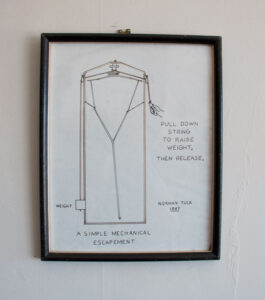
OscylinderScope
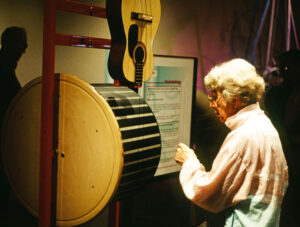
Rotate Resonate
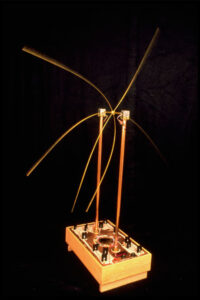
Mirror of Light by Marielle V. Jakobsons
Sat, May 1 — Thu, Jul 1, 2021
Mirror of Light (2021)
It is said that water has the ability to hold our collective memory, a comfort in knowing our connection to each other is already within us. After a year of pandemic lockdown prohibiting access to shared spaces and restricting our physical locations and interactions, it forces us to look with a different perspective at what connects us all. Our points of observation and action have shifted individually and collectively. How can we find comfort in our togetherness, while being separated spatially?
In four continuous movements, Mirror of Light explores the effect of perspective and time on relationship and memory. In this work, sound, water, and light move together, and are seen with different perspectives. Up close and from a distance, our vantage shifts from inside the water to its surface, to envelopes of light collecting and refracting through a curved surface. Water refines and reflects the connections between us; water is a mirror bridging our memories from the individual to the collective.
Building upon my macro-cymatic instruments, which translate sound to movement of water and light, this work spans the range of perspective from what is visible with the naked eye to the microscopic. The sound is composed according to how it moves water and light in the resonances of this particular vessel, and how the sound is amplified and muted by the shape of the glass and water together.
Materials: glass, LED lights, water, electronics
Sound: Electronic organ, synthesizers, voice, crystal bowls, steel drum


The Making of Mirror of Light
Watch the 6/24 Premier and Discussion with Bart Hopkin
About the Artist
Marielle V. Jakobsons is a prolific composer and intermedia artist based in Oakland, CA. Her compositions evoke minimalism with melodic drone and enveloping polyrhythmic soundscapes of synthesizers, strings, and voice. She builds installations and instruments which bring focus to the visceral experience of sound and light, most recently with her “Macro-Cymatic Visual Music Instrument.” Marielle collaborates extensively in experimental arts and technology as a sound designer, audio engineer, and composer. She published recordings and toured internationally on Temporary Residence, Thrill Jockey, Mexican Summer, Students of Decay, and Important Records, as a solo artist and with her bands “Saariselka” “Date Palms“, “Myrmyr“, and other collaborations.
Marielle received her MFA in Electronic Music from Mills College, and BA from Case Western and the Cleveland Institute of Music. She has received numerous awards including the Djerassi Artist Residency, Dresher Ensemble Artist Residency, Brush Creek Arts Residency, American Composer’s Forum Grant, NEXMAP Sounding Out California Composer’s Award, Elizabeth Mills Crawford Award in Composition, among others. Her installations, photographs, and videos have been exhibited or screened at the Staunton International Film Festival (VA), The LAB (CA), Warehouse 1-10 (NM), Indiana University East’s “Art + Science” Juried Exhibition (IN), Allegany Arts Council Juried Photography Exhibition (MD), Brand 44 Works on Paper Annual National Juried Exhibition (CA), and Madelife (CO). She has been a Visiting Professor at Mills College and San Francisco State University, and Visiting Artist at Eastern Washington University.
http://www.mariellejakobsons.com
MAP SCORES by Phillip Greenlief
Sat, May 1 — Mon, May 31, 2021
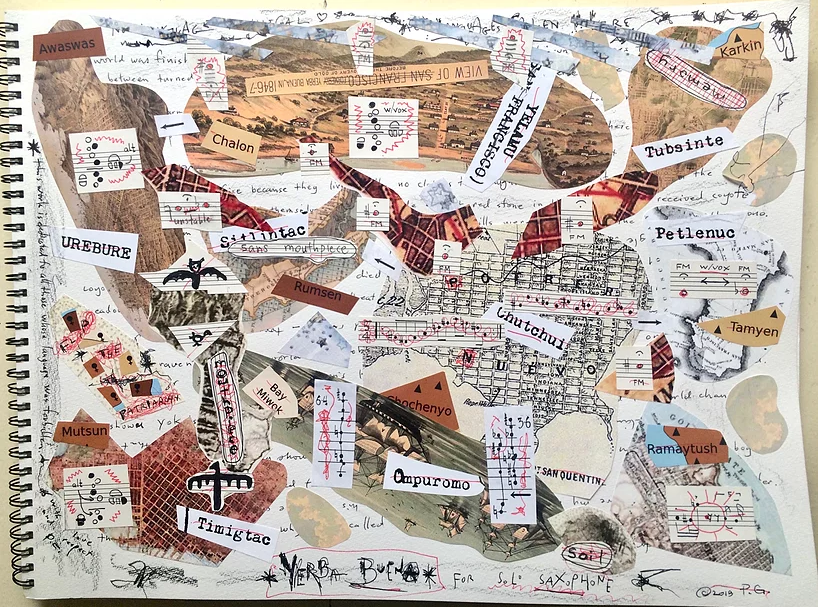
YERBA BUENA for solo saxophone – commissioned by SOMArts gallery, SF (2018)
History of MAP SCORES
i began creating MAP SCORES for the 2+2 project with jon raskin in 2005 and have since created numerous works for solo and ensembles. these piece feel like the some of the first works where i was striking out without a mind to satisfy any particular genre, but was looking for something that could be played with just a quick talk-through before the concert – something that leaves a lot of space for improvising, but also gives some specific compositional elements to create the kind of ensemble unity that can go missing in improvised music.
the works have evolved a great deal over the past 14 years, and i have tried in recent years to create compositions that can work with multi-disciplinary platforms.
over the past few years these works have been the centerpieces of workshops that i teach that i refer to as composing for improvisers.
See more here.
About Phillip Greenlief
Since his emergence on the west coast in the late 1970s, saxophonist/composer Phillip Greenlief has achieved international acclaim for his recordings and performances with musicians and composers in the post-jazz continuum as well as new music innovators and virtuosic improvisers. He has performed with Wadada Leo Smith, Meredith Monk, Rashaun Mitchell and They Might Be Giants. Albums include LANTSKAP LOGIC with Fred Frith and Evelyn Davis, THAT OVERT DESIRE OF OBJECT with Joelle Leandre, ALL AT ONCE with FPR (Frank Gratkowski and Jon Raskin), and OH THAT MONSTER with LA punk pioneers Thelonious Monster. Recent residencies have included the Banff Center for Art and Creativity and Headlands Center for the Arts. His critical writing has been published in Artforum, open space (sfmoma), and Signal to Noise.
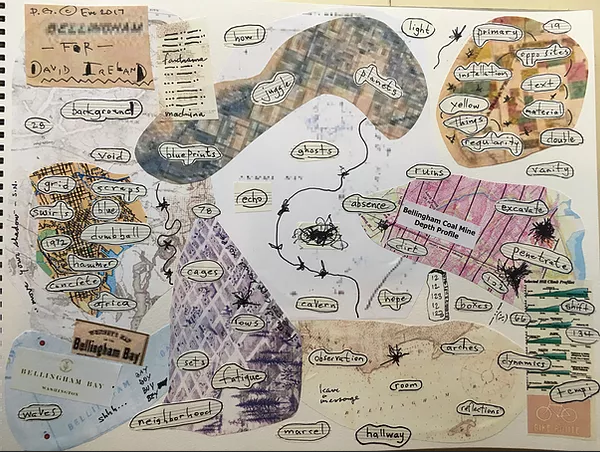
BELLINGHAM for David Ireland

THE FIFTY STATES part one
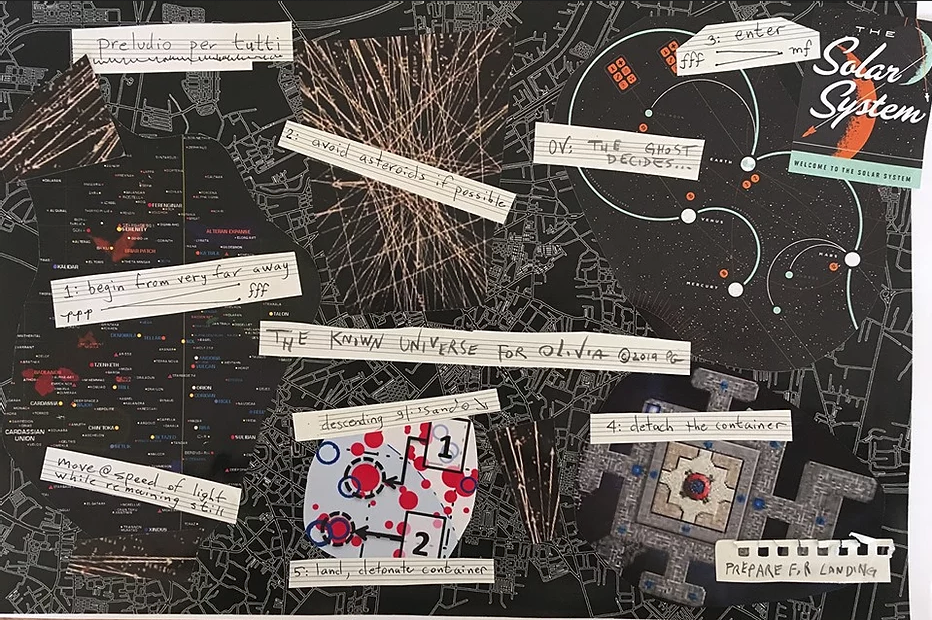
THE OLIVIA TRILOGY: preludio
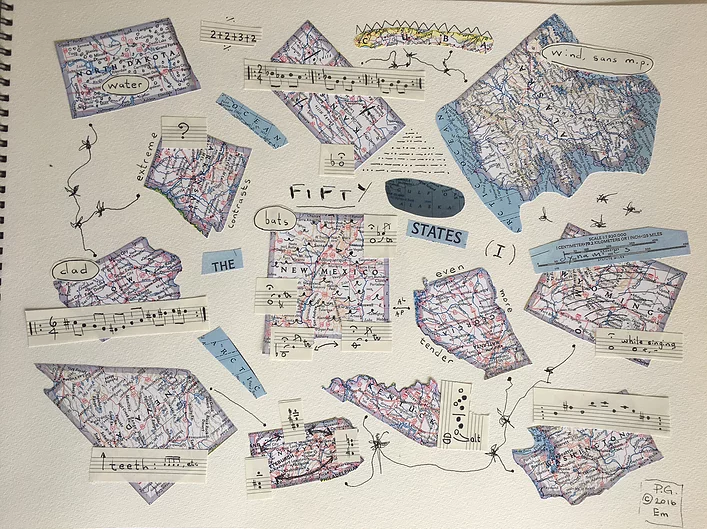
THE OLIVIA TRILOGY: part one
Tonal Relativity: Studies by Alyce Santoro
Mon, Mar 1 — Fri, Apr 30, 2021
Alyce Santoro will be discussing her work with David Samas on 4/8 at 5pm on YouTube Live.
The gallery will be open on 3/28 and 4/11 from 11am until 2pm. Reservations are required. Showings will be 20 minutes and only for small groups and individuals. Please contact annemarie@centerfornewmusic.com for information and booking.
About Tonal Relativity: Studies
The Tonal Relativity Studies are diagrams of musical intervals and sets of intervallic patterns for the purposes of contemplation and exploration (sonic, visual, or otherwise). A musical scale employing twelve equally-spaced tones is represented by a spectrum of 12 equally-spaced colors (from this basic concept, patterns derived from scales consisting of any number of tones or intervals can be imagined).
The current edition of the project employs concentric circles at a scale of ½ inch = ½ step in both color and pitch; one octave therefore equals 6”. The prints displayed at the Center for New Music began as sketches in gouache on paper, all completed during 2020.
Any color can be associated with any pitch; all colors/pitches remain relative. For the sake of consistency and legibility, a somewhat arbitrary choice was made to use red as a starting point for all graphics in this collection.
The Studies consist of three parts: Intervals, Modes/Scale Sets, and the Overtone Series.

TONAL RELATIVITY – STUDIES
“I think music is an instrument. It can create the initial thought patterns that can change the thinking of the people.” — John Coltrane, 1966 Interview with Frank Kofsky for KPFK Radio
An obvious yet fascinating feature of the human sensory system is that impressions evoked by color or sound shift according to context; the qualities of even a (seemingly) singular tone morph as pitches or hues are added. For many musicians, visual artists, and others, intentional focus on such basic relationships can serve as an entry into the appreciation of subtleties and the exploration of more intricate and complex interactions. Sensations, atmospheres, moods, and ideas can be communicated fluidly by those versed in the arts of tonal interactions.
The Tonal Relativity Studies offer a way of contemplating sound through color, and color through sound. They can be utilized by anyone interested in developing new pallets of possibility, sonic, visual, or otherwise.
Here a musical scale employing twelve equally-spaced tones is represented by a spectrum of 12 equally-spaced colors. For the sake of consistency and legibility, a somewhat arbitrary choice was made to use red as a starting point for all graphics in the current collection.
These diagrams are intended only as a starting point; patterns derived from scales consisting of any number of tones or intervals can be imagined using similar methods.
PART 1: INTERVALS
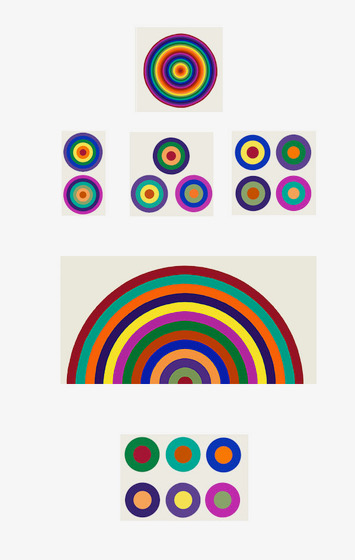 The interval series begins with a 2-octave chromatic scale—twelve rings consisting of all consecutive colors/tones repeated twice.
The interval series begins with a 2-octave chromatic scale—twelve rings consisting of all consecutive colors/tones repeated twice.
Next, a set of two diagrams each consisting of every other color on the spectrum represent, in musical terms, two possible sets of whole tone scales. In color theory, these would be considered a set of six primary colors, and a set of six corresponding secondary and tertiary colors.
A set of three diagrams each consisting of four colors one-and-a-half steps apart on the spectrum represent three sets of stacked minor thirds. In terms of color, these relationships are known as tetrads.
A set of four diagrams each consisting of three colors two steps apart on the spectrum represent four sets of stacked major thirds. In color theory, these relationships are known as triads.
A half-circle (depicted at the same scale as the other graphics, but as a half-circle due to size constraints) consists of twelve colors two-an-a-half steps apart on the spectrum. From center out, this chart represents fourths. From outer edge to center, it represents fifths. In terms of color, these relationships are considered split complementaries (directly opposite one another on the color wheel, offset by one).
The set of six diagrams consisting of two colors three whole steps apart represent tritones. In color theory, these colors—exactly opposite one another on a tertiary (12-hue) color wheel—are known as complementary.
PART 2: MODES/SCALE SETS

These sets of intervallic patterns can be imagined as three-dimensional, extending infinitely in all directions (as if each view is a slice of a ball-shaped object).
Each of the five images in the top row consists of complexes of intervallic patterns. Left to right, the first three are 7-note scales (Modes of the Major Scale, Modes of the Melodic Minor Scale, Modes of the Harmonic Minor Scale, respectively). The rightmost two are 5-note (pentatonic) scales.
Each of the five images in the bottom row depict an individual scale extracted from the complex above it.
PART 3: THE OVERTONE SERIES

Most pitches emanating from a string or tube behave according to a physical phenomenon known as the Overtone Series. The oscillations of a primary tone in turn cause additional pitches to sound, resulting in a subtle cacophony contained within a seemly-singular tone. The order in which this subtle cacophony occurs in part forms the basis for musical scales around the world, and accounts for the variations in timbre of different voices and instruments.
In musical terms, the order is:
Prime, octave, fifth, octave, major third, fifth, minor seventh, octave, major second (or ninth), major third, tritone (sharp eleventh), fifth, minor sixth, minor seventh, major seventh, octave, minor second, major second, minor third, major third…and so on.
About Alyce Santoro
Informed by a background in biology, scientific illustration, and the environmental humanities, Alyce Santoro uses invented frameworks for experimentation, collage (sonic and visual), drawing, and writing to undo undue dualisms, explore new imaginaries, and otherwise remark on existence within an intricate ensemble.
Over the past 25 years, her multimedia works have appeared in over 50 exhibitions related to innovative textiles; experimental musical scores; sound and listening; social/environmental action; and the intersection of science and art.
Website: alycesantoro.com
sounding flow by Doga Buse Cavdir
Mon, Mar 15 — Fri, Apr 30, 2021
This exhibit is experienced best with headphones.
Doga Cavdir discussed the work with Window Gallery curator Bart Hopkin on 3/18/21 YouTube Live.
Introduction
Doga Cavdir on sounding flow:
I design gestural interfaces and movement-based musical performances to create an intermediate medium between physical interfaces and the musician’s body. My work explores the correspondences between music and the movements involved in sound creation. I employ cross-disciplinary gestures and expressive body movements, borrowed from dance, theatre, and sign language, into music.
I am interested in the transformation of communication and expression carried in one gestural domain to a musical one. As a designer, I create embodied and immersive systems that encourage musicians to extend their relationship with their body movement as a mean of compositional tools. These new musical interfaces inspire a natural flow of kinesthetic expression that would be left unnoticed otherwise. I hope my work offers new and inclusive ways of creating music that could bridge across domains and diverse abilities.
about sounding flow
The exhibit, sounding flow, is a series of sonic exploration of how we observe movement in music, from acoustic instruments to movement-based wearable instruments.
The first part of the exhibit presents In Vivo, an audio-visual installation. This installation explores the intersection of our perception of sound, movement, and action. It involves stationary musical instruments decoupled from their sound and excitation. The installation illustrates vibration patterns of acoustic instruments using projection mapping. The motivation behind it draws from the sonic potentials of stillness in movement and the gray areas in human sensorimotor perception.
Movement-based instruments, on the other hand, create an embodied body-to-instrument relationship by physically connecting the musician’s body to the musical instrument. Bodyharp, a new musical instrument, borrows musical gestures from string instruments and extends them with dance gestures. Felt Sound incorporates American Sign Language gestures to low-frequency, high amplitude soundscapes that can be felt as much as it is heard. By amplifying the physical sensations of sound, Felt Sound hopes to offer a shared performance for Deaf and Hard of Hearing and for those who are not.
I. In Vivo

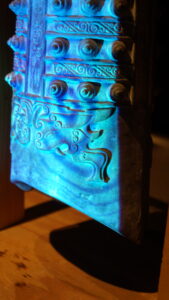
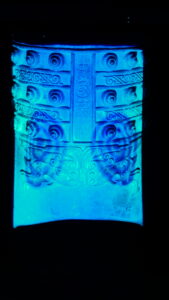

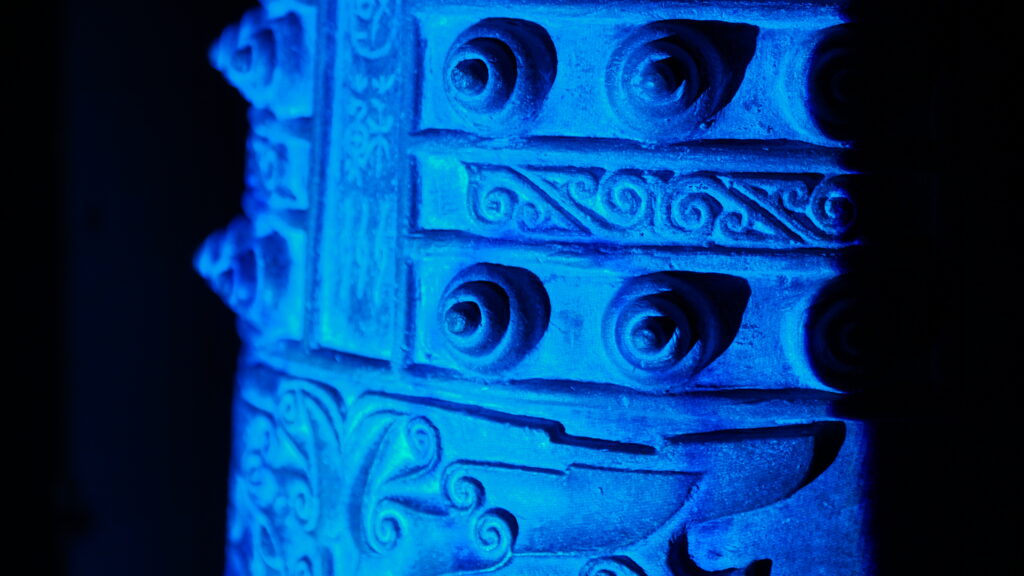
II. Felt Sound

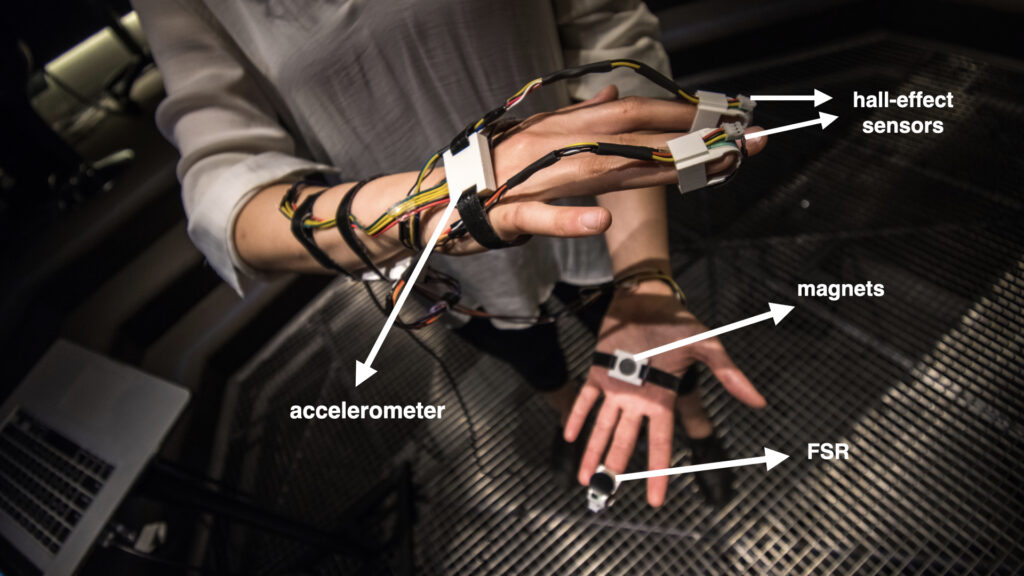
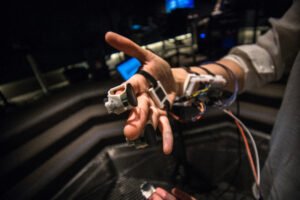
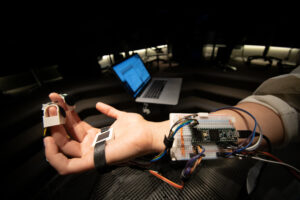
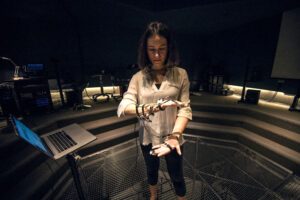

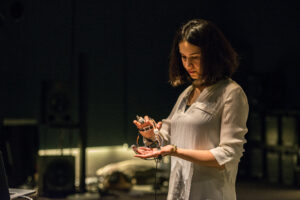
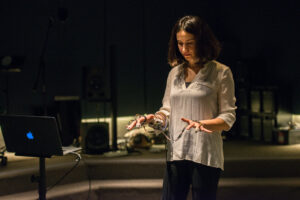
III. Bodyharp
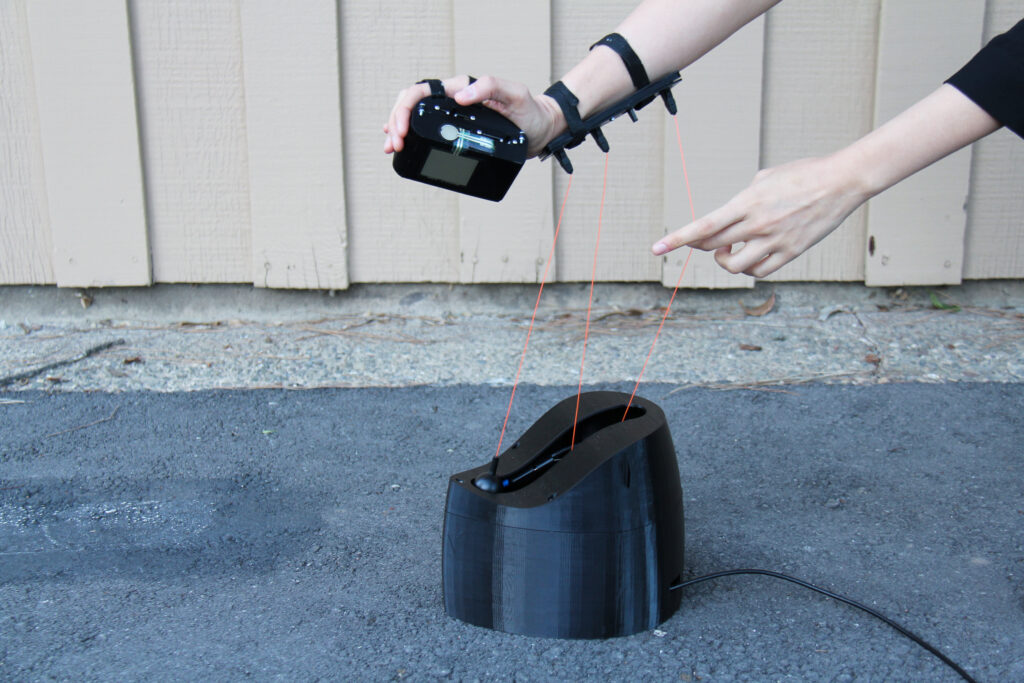
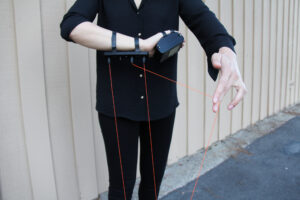
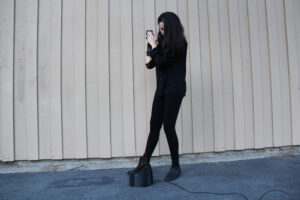
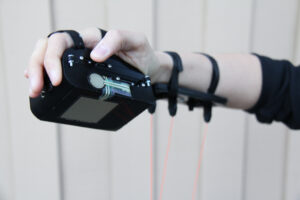
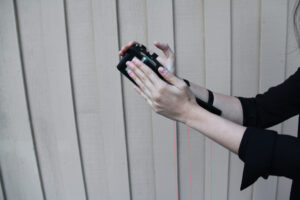
Doga Buse Cavdir is an artist, designer, and researcher whose work integrates body movement and expression into music performance. She explores the relationship of body, sound, and space, through embodiment and interaction.
Her process actively engages with kinesthetic, immersive, and shared experiences for inclusivity as a way to bridge diverse abilities that “shows how we can benefit from and contribute to increased accessibility, inclusivity, and collaboration”. Her designs range from wearable, movement-based interfaces to audio-visual installations.
Doga uses extended piano techniques in her compositions and plays her custom-made instruments when she performs solo and in interdisciplinary female-identifying artist group fff. She holds a B.Sc. degree in Electrical Engineering from Middle East Technical University, and she is currently pursuing her Ph.D. at Stanford’s Research Center for Computer Research in Music and Acoustics (CCRMA).
Synths in Place by Kirk Pearson with Dogbotic Labs
Fri, Jan 1 — Sun, Feb 28, 2021
The Discussion:
About the Show
In March 2020, two weeks after the COVID-19 lockdown, Berkeley-based audio laboratory Dogbotic teamed up with Oakland nonprofit Thingamajigs to produce “Synth In Place,” a socially-distant beginner’s workshop on the joys of DIY electronics. Designed with absolute beginners in mind, the nine-week curriculum teaches participants the art of creative electrical engineering, the cultural significance of electronic audio, and how to blend DIY music with students’ pre-existing creative practices. After building a variety of theremins, talkboxes, stepped tone generators, sequencers, and vactrols, students have the opportunity to design, engineer, and fabricate an instrument entirely of their own creation—several of which you’ll see in front of you.
About the Workshops
The instruments in “Synths in Place” were made by alumni of our 2020 “Synth in Place” workshop series, most as final projects in the course. The workshop, as with all our workshops, is designed for total beginners with no engineering or musical ability required for participation.
Magnolia Symphony by Mauro ffortissimo
Tue, Nov 3 — Wed, Dec 30, 2020
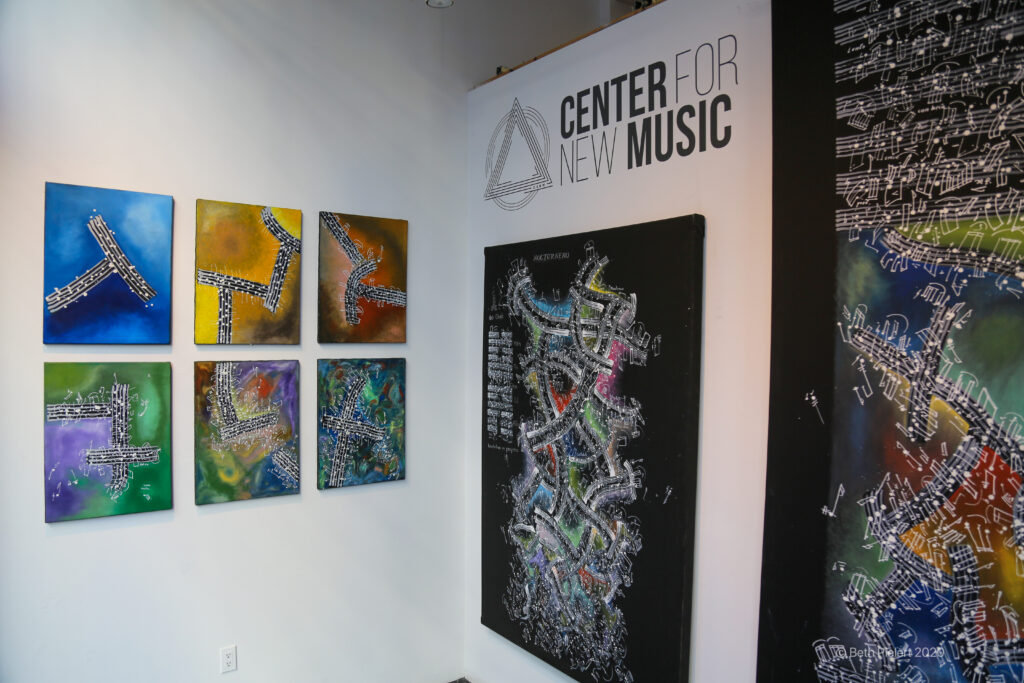

Mauro Ffortissimo created several pieces for the Window Gallery: a collection of inventions, a nocturne, and the ten-foot diptych Magnolia Symphony.
Watch his discussion and demonstration with Jon Raskin, streamed live on December 17, 2020.
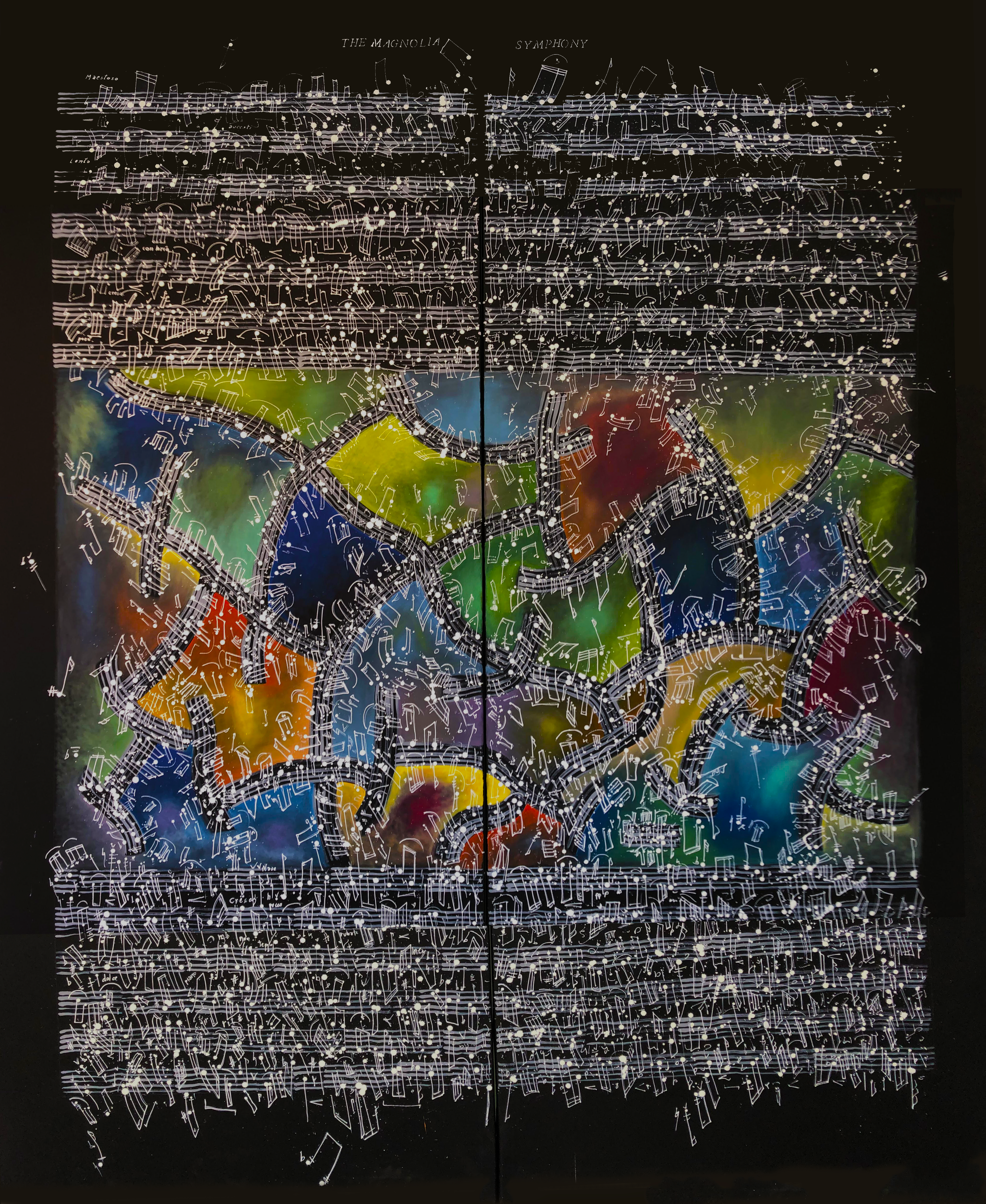
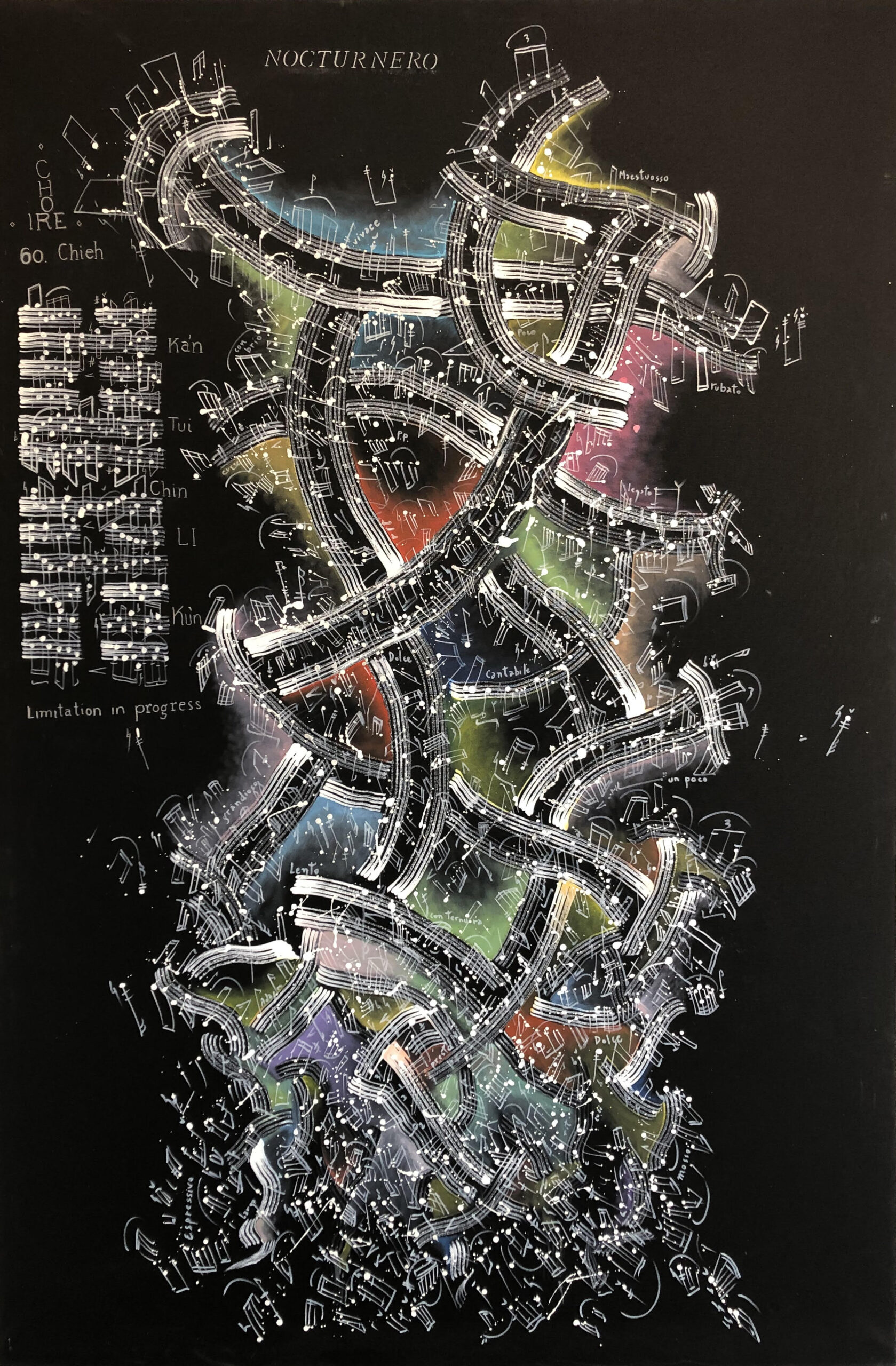
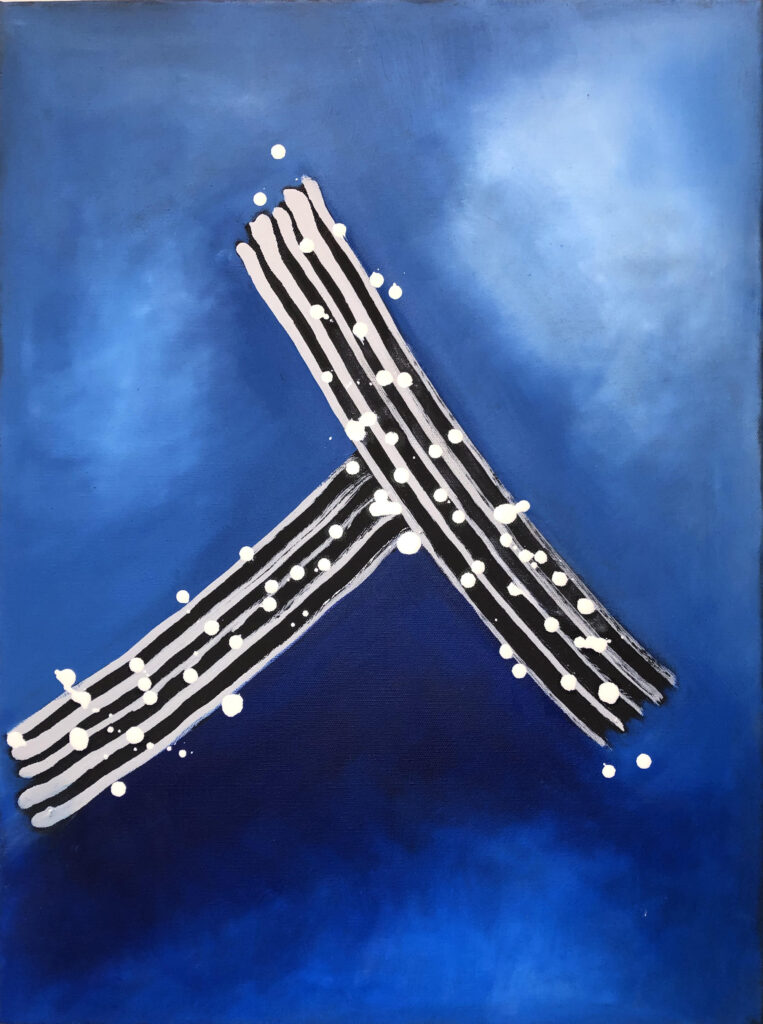
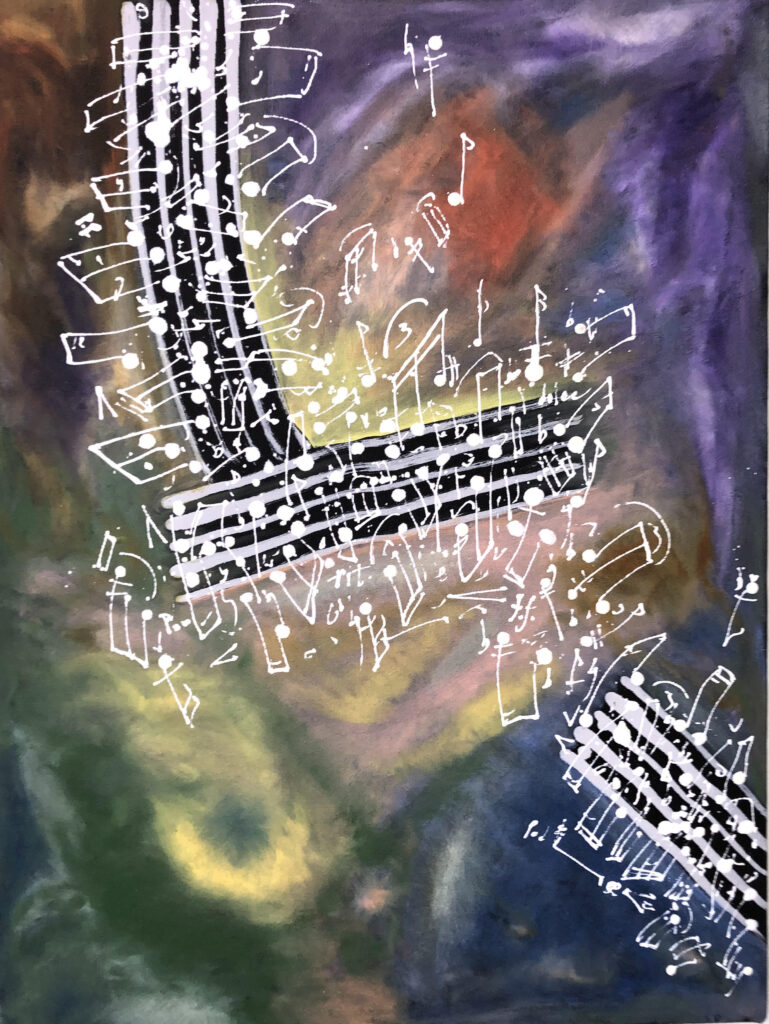
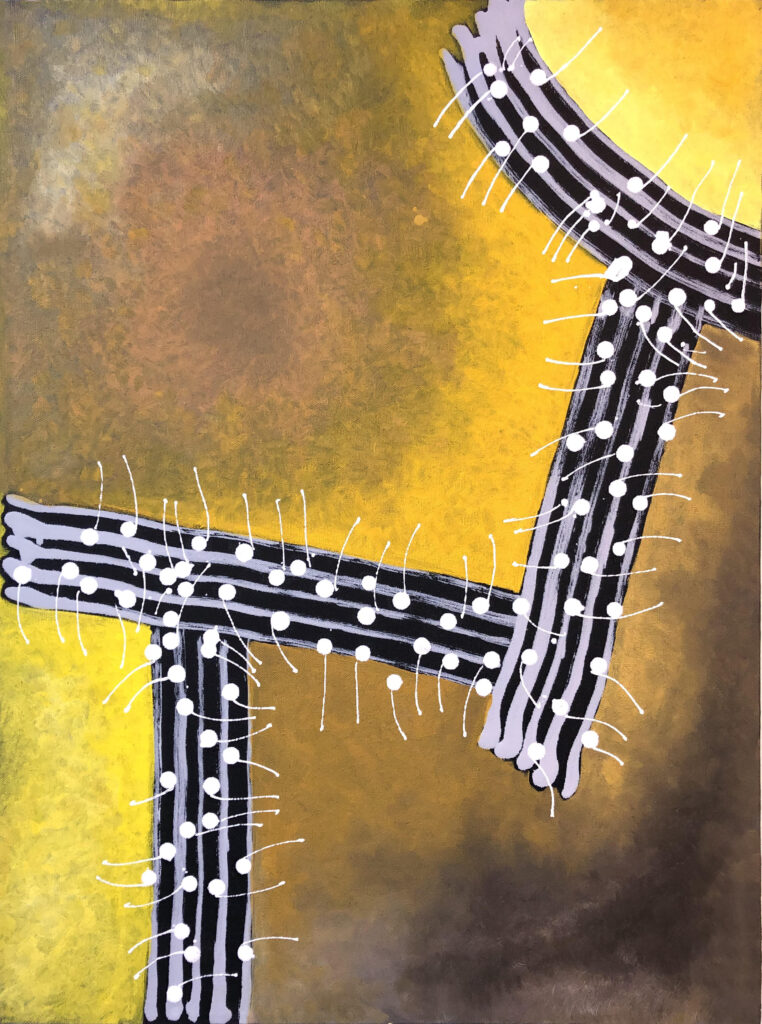
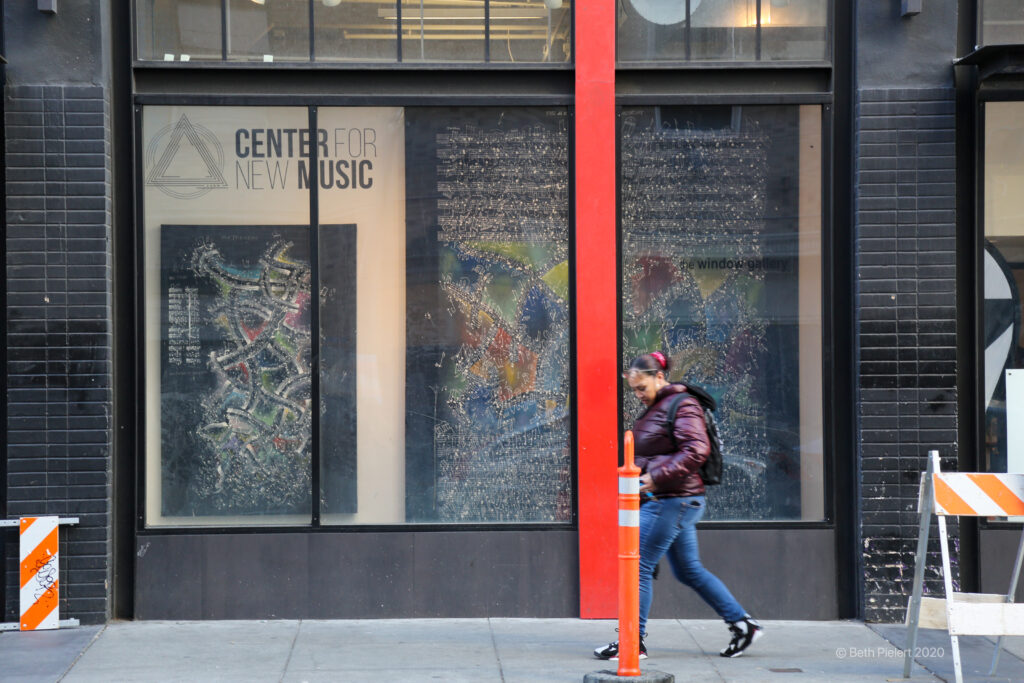
Prototypes II by Fred Frith & Sudhu Tewari
Wed, Dec 2 — Wed, Dec 2, 2020
Curator Bart Hopkin spoke with Fred and Sudhu about their new works. Watch the stream of their discussion and a series of demonstrations from December 2, 2020.
About Prototypes II
In preparing this exhibition we were continuously confronted with basic questions: Why build a new instrument? What is it supposed to do? How will it be played and in what context? To what extent will it require appropriate techniques, and will the result be consistent? Is that actually what we want?
Sudhu and I have been playing in our duo, Normal, for many years now, a “group” that plays manually & electronically manipulated instruments that we build ourselves. Not really instruments in the sense of beautifully crafted art objects so much as crude de-constructions patched together using the simplest of means, and requiring only minimal exertion to produce sound. My “planks of wood with strings” were almost all built in the early 1980s, when for a period of a couple of years I abandoned the guitar as my primary vehicle for improvising. I had come to the conclusion that the guitar was not really relevant—as a guitar—to the way I was playing, and was trying to reduce the idea of an “instrument” to its most basic and simple form. I guess you could say that Sudhu and I share a kind of “junk” aesthetic. We deeply admire the stunning craftsmanship of such inventors as Hans Reichel and Oliver DiCicco, but are also aware of the ways in which that very craftsmanship also reduces the gestural vocabulary to one that is more or less dictated by the perfection of the result. If our musical philosophy runs along the lines of “what will happen if I do this, now” then our constructions need to reflect that openness, and desire—not to say delight—for surprise!
Sudhu is a tinkerer of genius. He plunders garages and junkshops and scours the streets for the sources of his sound world. The smallest spring may turn into a potential orchestra, the bluntest needle into a sharp response. But the thing is, what is really going on is intense listening. As he says: “From my perspective, this project is about making instruments that serve the purpose of making the kinds of music that we make together, or that we might want to make, along with a healthy dash of simply trying things to see if they might result in something amazing that we would never have thought to do.”
The results of these couple of months of reflection and hard work suggest ideas about composition as much as they do about improvisation. The next step will be to take those ideas and run with them wherever they might take us…
Fred Frith – October 30th, 2020
About the Artists
A pioneer of the extended electric guitar, Fred Frith has been active across a broad spectrum of sound exploration for more than 50 years. Described by Guitar Player as “a musician who makes miniatures of the world around him using scraps torn from corners of the map”, Fred has been deeply involved in the art and craft of improvisation since the late 1960s while maintaining a strong connection with his roots in rock and folk music through bands like Henry Cow, Art Bears, Massacre, Skeleton Crew, Cosa Brava and The Fred Frith Trio. His compositions have been performed by groups ranging from the Ensemble Modern, and Arditti Quartet to Ground Zero and Sleepytime Gorilla Museum. Film music credits include the acclaimed documentaries Rivers and Tides and Leaning into the Wind by Thomas Riedelsheimer, The Tango Lesson and The Party by Sally Potter, Werner Penzel’s Zen for Nothing, and the award-winning (and Oscar-nominated) Last Day of Freedom, by Nomi Talisman and Dee Hibbert-Jones. He has also created an extensive catalog of music for dance, notably for Amanda Miller’s Pretty Ugly Dance Company in Germany. Fred taught for twenty years in the Music Department at Mills College in Oakland, California, and co-directed the improvisation Master’s Degree program at the Musik Akademie in Basel, Switzerland. He was also one of the curriculum designers for the new School of Music and Sound Art at the Universidad Austral in Valdivia, Chile, where he is a visiting professor.
Sudhu Tewari has been described as “bricoleur”, “junkyard maven”, and “audio-gadgeteer”. He invents, designs and builds from whatever materials are to hand—musical instruments, kinetic and sound sculpture, interactive installations, audio electronics, and wearable sound art. Along with Fred Frith, Sudhu is one half of the home-made instrument duo Normal, and has performed in this and other configurations in Europe, Japan and the USA. His visual and interactive art has been exhibited at Swarm Gallery, 21 Grand, ProArts, and FLOAT Gallery in Oakland; the Center for New Music, the Exploratorium, and the Museum of Modern Art in San Francisco; and at Montalvo Arts Center, UC Berkeley, the Tech Museum in San Jose, the Oakland Museum of California, PROGR and the Laboratoire Village Nomade in Switzerland. He has been teaching electronics and sound art to children and adults since 2009 and continues to build and perform with self-governing musical systems and self-built musical instruments. His relentless curiosity and delight in unlikely solutions to intractable problems are manifest in all of his work. Sudhu holds an MFA in Electronic Music from Mills College, and a PhD in Cultural Musicology from UC Santa Cruz. He is currently Workshop Technician in the instrument building program at Mills College and teaches art, technology, and design at California College of the Arts, the University of San Francisco, and Expression College in Emeryville.
Tonal Access III: The Array Fields of Bill Wesley
Tue, Sep 1 — Sat, Oct 31, 2020
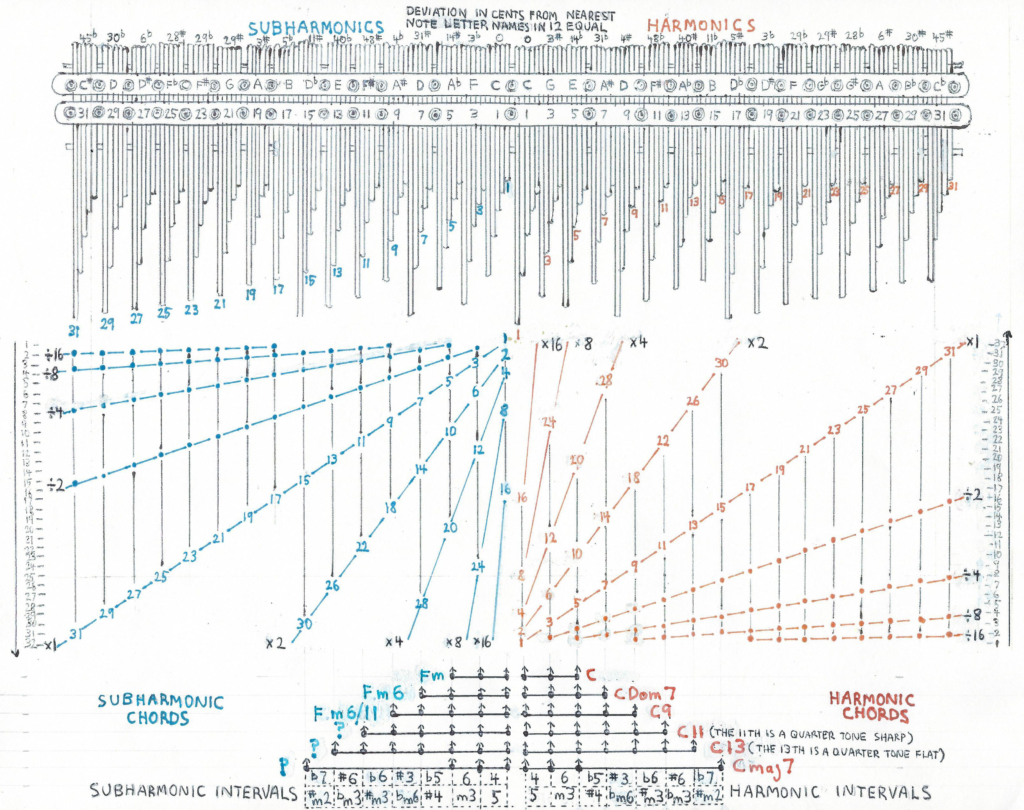
The Array
Bill’s focus has always been on creating new ideas. Realizing the limitations of the 12 tone (Halberstradt) keyboard, Bill wanted to access more octaves and other intervals (4ths, 5ths, 3rd,s, etc.) more ergonomically and came upon adapting the mbira (African finger piano) to play several octaves stacked up to be played with the stroke of a finger. Rows of 3/2’s (fifths) (right to left) became a field of pitches he called the “array”. The resulting sound has lots of resonance because of the reinforcement of the lower harmonics through sympathetic vibration.
Bill has been honing this idea for over four decades and has developed many Array instruments mostly in three categories, Harmonic, Melodic, and Timbraic. Harmonic Arrays include the mbira in various 12 tone and microtonal scales, the Array Organ (Nail Array), Psaltery (Harp), Array Guitar and Array Synthesizer (MBoard). The Chromatic Array Mbira uses octave rows in semitones right to left favoring melody rather than harmony. The Timbre Array uses octave rows with the fundamental in the middle with octave rows of the harmonic series to the right and subharmonic rows to the left. Bill has also created two percussion arrays, the Rhythm Array and the Rasp Array that fit into this category.
Bill’s ideas are much bigger than his instruments. He has templates of emotion, chemistry, rhythm and psychology that fit within the Array Cosmology. Consciousness is the fabric that ties Bill’s ideas together. The drawings in this exhibition represent the array of pure isomorphic tone fields, maps of the most consonant interval relationships and their visual and musical implications. This field supports endless diagrams of harmonic structures rendering them visually available.


About Bill Wesley
Bill Wesley is unique. He is a microtonal tuning theorist, Instrument Inventor, creator of multiple new arrangements for keyboard interfaces, a historian and a visual artist who’s work explores the most consonant and harmonious relationships. Sound always intrigued Bill and as a young man he took a course at the Naval Electronics Laboratory in San Diego to begin building electronic prototypes. His instruments have been played by Rye Cooter, Tatsu Yoshita, Sting, Imogen Heap, Taylor Swift and Trey Spruance. He currently makes a wide array of array instruments which can be purchased through his website at: ArrayMbira.com
Lexicographies by Cheryl Leonard
Sat, Aug 15 — Wed, Sep 30, 2020
Cheryl E. Leonard on Lexicographies
Since 2018 I have been developing asemic calligraphy based on patterns and shapes in wild landscapes for use in graphic music scores. Lexicographies displays works derived from the glacially-sculpted topography of Hardangerfjord in Norway, and coastal live oak trees in San Francisco’s Golden Gate Park. Included are “dictionary” pieces that demonstrate each calligraphic “language,” as well as work-in-progress graphic notation experiments.
My wilderness calligraphies are rooted in firsthand physical experiences. I study an environment by spending time within it – walking, scrambling, climbing, sitting, sleeping, watching, listening, touching, and documenting via photography and audio field recordings. Out of this boots-on-the-ground research I distill gestures, which I draw first in pencil, then transpose to brush and ink. “Characters” or “glyphs” emerge and I gather them into asemic collections. These are not traditional languages, as “characters” are not mapped to specific words, letters, or abstract or musical concepts, and there is no formal system for combining them into words, phrases, scales, melodies, or rhythms. Instead, because they are the result of many layers of translation, interpretation, and fabrication, these calligraphies and music generated by them, are necessarily abstract and improvisational. They are an invitation to consider aspects of the natural world that are beyond normal human scales of time, perception, and comprehension.
View Lexicographies
Natural-Object Musical Instruments
About Cheryl Leonard
Cheryl E. Leonard is a San Francisco-based composer, performer, and instrument builder whose works investigate sounds, structures, and objects from the natural world. Her projects cultivate stones, wood, water, ice, sand, shells, feathers, and bones as musical instruments, and feature one-of-a-kind sculptural instruments and field recordings from remote locales. Leonard is fascinated by subtle textures and intricacies of sounds, especially very quiet phenomena. She uses microphones to explore aural worlds within her sound sources, and develops compositions that highlight the unique voices she discovers. Her recent projects focus on climate change and extinction of species.
Leonard’s music has been performed worldwide and is available on multiple record labels. She has received grants from the National Science Foundation’s Antarctic Artists and Writers Program, New Music USA, American Composers Forum, American Music Center, ASCAP, Meet the Composer, the Eric Stokes Fund, and the NYSCA. Leonard’s commissions include works for SFMOMA, Kronos Quartet, Hope Mohr Dance’s Bridge Project, Illuminated Corridor, and the La Jolla Historical Society. She has been awarded residencies at Kunstnarhuset Messen, Djerassi, Oberpfälzer Künstlerhaus, the Arctic Circle, Villa Montalvo, and Engine 27. Leonard has contributed to several publications about music and sound art. Her instruments, installations, recordings and graphic scores have been exhibited in galleries and museums in the U.S. and abroad.
About Jon Raskin
Jon Raskin, a founding member of the Rova Saxophone Quartet is a improviser, composer, saxophonist and a player of a suitcase full of small electronics and recycled materials. He has been exploring alternative graphic methods for composing music for improvising musicians for almost 20 years and is keenly interested in of how visual art and music can interact.
The Innate by Alan Tower and Hans Houkes
Sat, Aug 1 — Mon, Aug 31, 2020
About the Innate
“We wanted to create a new instrument based on the Huaca above, a three-chambered vessel flute invented by Sharon Rowell in Berkeley,1980. As musicians, we worked for five years to crack the code for creating a timeless chordal wind instrument that would call anyone to play from the inside out by requiring no musical background, just the desire to create beauty. In addition, we wanted players to be able to produce a feeling of immersive envelopment for another as well as themselves. The Innate was born, which means inborn, unlearned.”
Instrument inventors Alan Tower, Hans Houkes, and C4NM curator Bart Hopkin met for a live online event featuring artist talks, demonstrations, and performances. Tower and Houkes innovative instruments “The Innate” are three-chambered flutes intentionally designed in a way that allows all levels of musicians, from novice to expert, to be able to have rich musical experiences both playing and listening. Watch here:
About the Artists:
Alan Tower is an instrument inventor and musician with 15 albums of original music. He is the co-founder of Resonance Group 501c3 & Green Music Network 501c3 with a goal of elevating the human spirit through sound as a force of nature.
Hans Houkes is a ceramic instrument builder, musician, experience design. He has a passion for creating impactful sound experiences for all ages. Houkes is based in the Netherlands.
Contact the artists, buy instruments, and learn more through Stonewhistle.com
“To gain your own voice, you have to forget about having it heard.”
– Allen Ginsberg
Shelter-in-Place Programming
Fri, Mar 13 — Sat, Aug 15, 2020
As a result of San Francisco’s shelter in place order, The Window Gallery is not currently holding physical exhibitions at our landmark space in the Center for New Music at the heart of San Francisco’s tenderloin.
Please join us for our virtual events celebrating the local and international instrument inventing community including conversations with our scheduled artists. To see our upcoming events please click here.

artwork by Trimpin
Atrium Display; Musicians Make: Food
Wed, Apr 1 — Fri, May 1, 2020
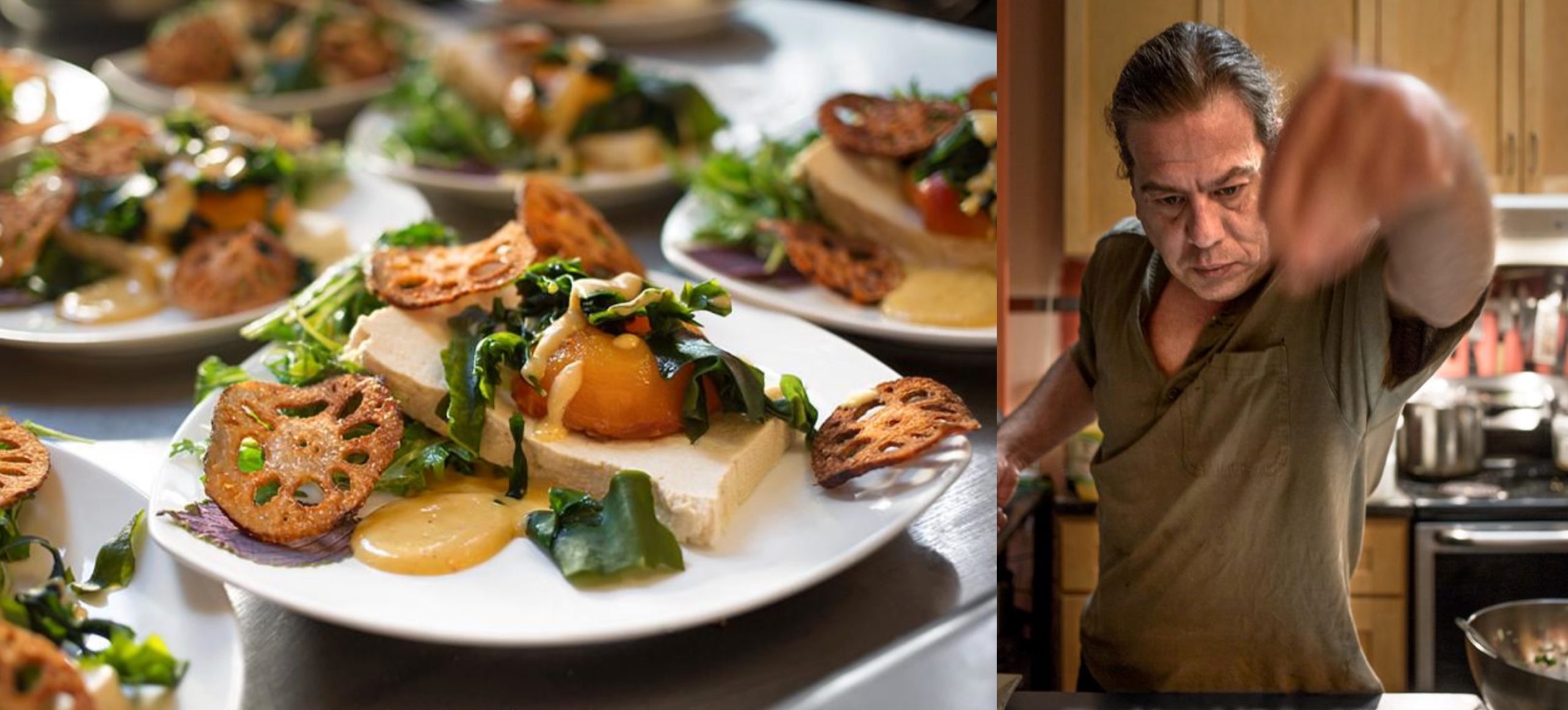
Curator Statement
Polymaths are often musicians and the talents and proclivities that make for great musicians quite often make for brilliant artists, engineers, mathematicians, activists, chefs, philosophers, poets, painters, cosmologists and gardeners. Society seeks to flatten these geniuses and too often these gifts are considered tangential rather than being celebrated as the facets on a single, complex jewel.
In this series of exhibitions curated by David Samas, we explore non-musical works of artistic and cultural value created by members of the community primarily known for their music. This latest exhibition, Musicians Make: Food features musician/chef Philip Gelb, and food photographer Hannah Kaminsky.
About the Artists
As a musician, Philip Gelb was a shakuhachi player, known for his work with new music and free improvisation. Due to dental issues and a lack of access to dental care, his flute playing career came to an unexpected end and thus started focusing on being a vegan chef. Now known for making everything fresh and from the finest ingredients, running a catering business and hosting an underground restaurant series in his loft in West Oakland. For over 14 years, his loft has been the site of gourmet meals combined with concerts by world-renowned musicians. Over 150 musicians from 18 countries have now performed on the series. He has published 2 books, “Notes from an Underground Restaurant: Improvisations Through Music and Food” and “Vegan Underground”.
Imaginative, dedicated, and passionate about all projects big and small, Hannah Kaminsky’s focus on food has brought sumptuous feasts into the homes of viewers across the globe. Breathing life into still images through vivid colors and sharp details, the end result always looks good enough to eat. Viewers can’t help but become drawn into the luscious, bold compositions, and invariably walk away hungry; the benchmark for a successful day’s work.
Hannah Kaminsky has developed an international following for her delicious recipes and mouthwatering food photography at the award-winning blog BitterSweetBlog.com. She is the author of Vegan à la Mode, Easy as Vegan Pie Sweet Vegan Treats, and many more cookbooks. Inspired by a flavor-first approach to creating new dishes while using and simple techniques, she works in Oakland developing recipes and capturing food imagery from morning to night.
Composing [De]Composition by J no.e Parker
Tue, Mar 3 — Mon, Apr 27, 2020
In lieu of a closing reception for Composing [De]Composition, we’re taking you on a virtual tour of our window gallery with artist J. no.e Parker and C4NM Project Manager D. Riley Nicholson. This online event also includes an artist interview with no.e and curator Bart Hopkin.
Artist Statement
Composing [De]Composition is a sonically-oriented BioArt research project that uses home compost as a rich site for creative exploration and sonic expression. This perceivably silent physical/biochemical activity is brought into the tangible range of human hearing via data sonification—the use of non-speech audio to convey information or perceptualize data. In this work, J no.e Parker parameter maps home compost temperature datasets collected by her in various parts of the world to sonic frequency and MIDI note numbers. This allows the changes in the compost’s heat over time to be the source of a range of sonic experiences.
About the Artist
A doctor of Digital Music Composition, Parker is a pioneer female Dj and live electronic musician, co-founding the San Francisco Bay Area’s SPaZ electronic music collective (1992), and the Autonomous Mutant Festival (1996), publishing her music and mixes as saKAna, Dj sunflowrfish, and as part of the electronic music duos GrooveStation, Psychotropic Playground, Planet Six and Actsyllabod.
Parker earned her B.S. in Textiles and Apparel Design from Cornell University, and an M.F.A. in Digital Art/New Media at University of California, Santa Cruz. While at UCSC, no.e developed Gamelan Plesetan, a live non-idiomatic improvisation project incorporating live electronic musicians, traditionally-trained gamelan musicians, motion capture video, and gamelan-controlled video programmed with Max/MSP/Jitter.
Parker received a Darmasiswa grant from the Indonesian Government to study Javanese/Balinese gamelan and Sundanese drumming at the Indonesian National Conservatory of Art in Yogyakarta, Java. no.e’s work has been exhibited, presented, performed and screened at the Qianyang Bamboo Museum (Fujian, China), the National Museum of Brazil, the National Library of Latvia, University of California Riverside’s Culver Arts Center, the DNA Lounge (San Francisco, USA), Bledog Art Space (Ubud, Bali) and the San Jose Institute for Contemporary Art (USA).
no.e has participated in art, video and sound festivals such as Soundgate: Sound Art Festival (Danish Museum of Modern Art, Alaborg, DN), the Surabaya Biennale Video Festival (Java, IND), Yogyakarta International Media Art Festival (Java, IND), Ubud Earth Day Festival (Bali, IND), and the Ubud Readers & Writers Festival (Bali, IND).
Parker has also received commissions to create and perform live electronic music for performance artists Beth Stephens and Annie Sprinkle’s Love Art Lab, as well as choreographers Crystal Sepulveda (Riverside, CA), Wendy Rogers (Berkeley, CA), Zubin Mohamad (Kuala Lumpur, Malaysia), and Rehane Abrahams (Capetown, South Africa). Other commissions include visual and sound environments for Theater Firefly (Bali, IND), and sculptor Keiji Ujiie (Japan/Bali). See her dance related page for further information and soundbites.
Loe-Fi-Delity by Aisha Loe
Tue, Mar 3 — Wed, Mar 25, 2020
Curator Statement
At first glance, Aisha Loe’s guitar pedals might not even look like guitar pedals. From period transistor radios to Atari controllers, the electronic organisms of Loe Sounds are often whimsically camouflaged in salvaged gear. Like hermit crabs, Loe’s handmade audio circuitry are given new homes within carefully selected, unorthodox enclosures. As duplicates are rarely made, each sonic curiosity adopts its own personality—a marriage of the circuit’s sound and its past life as a tactile, utilitarian object. A lifelong tinkerer and musician, Aisha’s creations have become staples in an impressive variety of setups including those of Mark Speer (Khruangbin), Clem McCreevy (Cherry Glazerr), and Bibi McGill (Beyoncé, P!nk, La Ley).
In Loe-Fi-Delity, we invite you to explore the sights and sounds of the unique Bay Area laboratory for yourselves. Please feel free to touch and play the instruments where indicated.
About the Artist
Aisha Loe is one half of Loe Sounds, a Queer Women Of Color-owned studio that specializes in hand-made, hand-painted guitar pedals and sound tools. In April 2020, Loe Sounds will be moving shop to Hudson Valley, New York after two years of production and experimentation in Oakland, California.
Aisha also produces music as “Loe”. You can find her on Instagram @loesounds, on Bandcamp @aishaloe, and on Soundcloud @iloe.
All works exhibited in this show are original pieces for sale. For more information, please contact the artist directly at aishabag23@gmail.com.
About the Curator
Kirk Pearson is the founder of Dogbotic, a Berkeley-based creative audio lab where creative-driven inquiry meets inquiry-driven creativity. A graduate of Oberlin Conservatory, Kirk has written music, built installations, and designed experiences for hundreds of films, museums, and new media projects. In 2017, Kirk was awarded a Thomas J. Watson Fellowship, through which they spent a year traveling the world composing works for experimental instruments.
Hacked Found Repurposed V3
Mon, Feb 3 — Fri, Feb 28, 2020
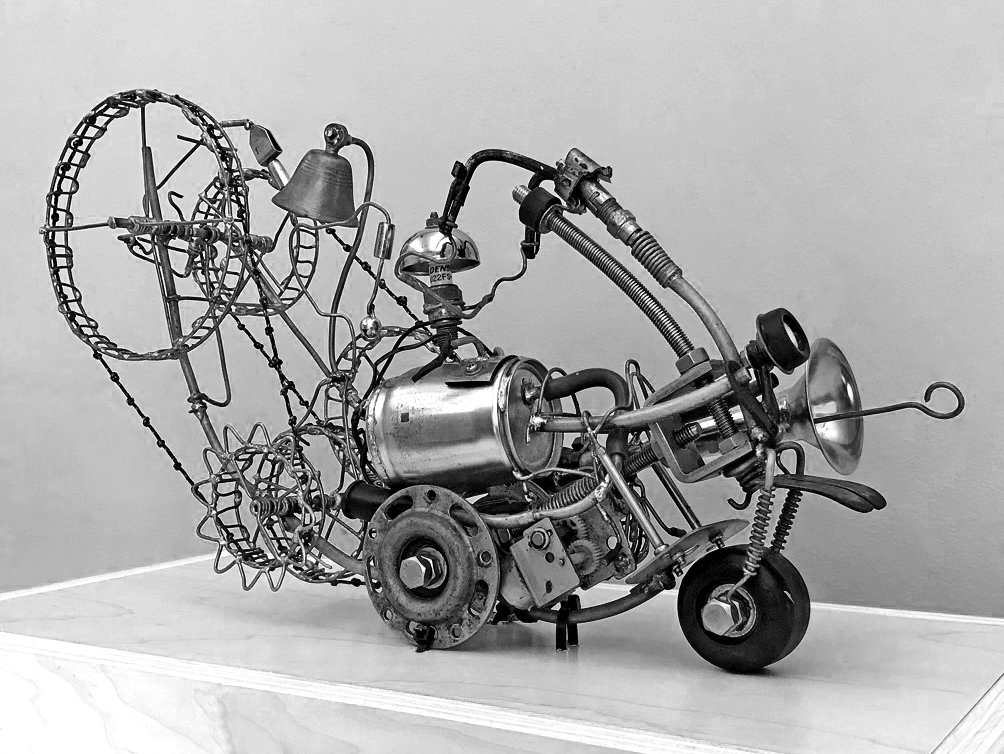
Artist Statement
Hacked-Found-Repurposed Vol. 3 is an exhibition of small-scale upcycled sound art pieces and invented instruments curated by instrument inventors Bryan Day and Kirk Pearson. The pieces on display highlight an ad-hoc approach to instrument design, using found objects to create both utilitarian and conceptual sound-art objects.
Artist Bios
Bryan Day started designing and building musical instruments in rural Iowa in the mid-1990s. Bryan has toured and has taught sound-invention workshops throughout the US, Southeast Asia, and across Europe and runs the experimental music record label Public Eyesore. He spends his days designing, building and fixing exhibits at the Exploratorium and Children’s Creativity Museum in San Francisco.
Kirk Pearson is the founder of Dogbotic, a Berkeley-based creative audio lab where creative-driven inquiry meets inquiry-driven creativity. A graduate of Oberlin Conservatory, Kirk has written music, built installations, and designed experiences for the New Museum, the American Museum of Natural History, Museum für Kommunikation Bern, and for hundreds of films, stage productions, and new media projects. In 2017, Kirk was awarded a Thomas J. Watson Fellowship, through which they spent a year traveling the world composing works for experimental instruments.
Clamorworks by Bryan Day
Tue, Jan 7 — Fri, Feb 28, 2020
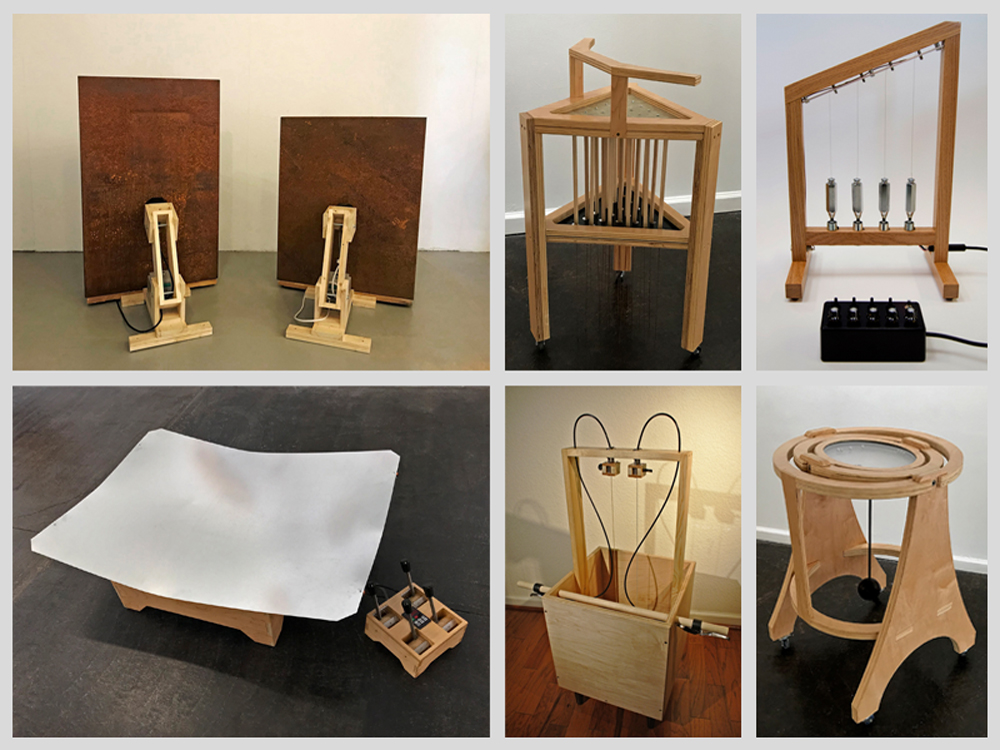
Artist Statement
With ‘Clamorworks’, I’ll be displaying a collection of amplified, acoustic and electromechanical pieces developed after I moved from the Midwest to California in 2012. Many of these pieces explore new methods of instrument performance, such as utilizing repetitive whole-body movements or mirroring everyday actions such as cooking or exercising. My objective is to explore methods of incorporating sound and performance into typically non-musical activities, blurring the lines between commonplace activities and personal expression. I also like making a mess with whatever is available.
Artist Bio
Bryan Day is a sonic adventurer, painter, and inventor of curious things based in the East Bay. Using scavenged electronics, repurposed mechanical components, and amplified materials that you might find in your garage or your great uncle’s office, he re-imagines them into constructivist sound sculptures. Day has performed, taught workshops, and built sound installations across Europe, Asia, and the Americas. He spends his days designing, building and fixing exhibits at the Exploratorium and Children’s Creativity Museum in San Francisco.
Atrium Display: Kaiser Electrical Instrument Co.
Thu, Jan 2 — Sun, Feb 2, 2020
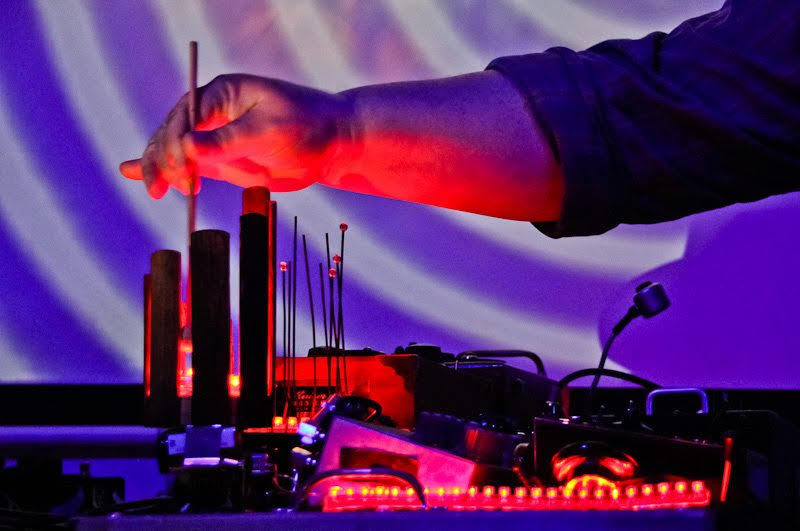
Artist Bio
Tim Kaiser is well known in the atmospheric experimental music scene for his blending of acousto-electric contraptions and Frankenstein electronics to create ethereal, layered drones. His sonic landscapes have been called “experiments in adventurous art” and “eclectic genius” by the likes of Make Magazine, Wired, the New Art Examiner, and the Associated Press. Mr. Kaiser was featured on the PBS program MakeTV and has headlined numerous experimental music festivals in the US.
For musical experimentation and all-around tinkering with Instruments, Tim Kaiser commands his creations with simple sweeps of the hands, willing sounds into existence. He has scored films, been on PBS as well as magazines, and has toured extensively. How he gets by airport security with his devices is anybody’s guess, but is handmade instruments are as alluring as the sounds they make. Kaiser has been a founding contributor and champion of the Weirdo Industrial Complex for 30 years.
GALLERY PAGE FOOTER
Fri, Jan 10 — Fri, Jan 10, 2020
GALLERY PAGE HEADER
Fri, Jan 10 — Fri, Jan 10, 2020
The Window Gallery presents the work of contemporary makers of unusual and newly invented musical instruments, including emerging artists as well as recognized pioneers. The emphasis is on originality in concept and design, recognizing the seminal role of the search for new sounds in the expansion of musical horizons. Equally essential to the exhibits are notions of beauty, craft, and humor.
The Window Gallery is curated by Bart Hopkin, David Samas, and Kirk Pearson. Located at 55 Taylor Street in San Francisco, the gallery is open to the public Monday through Friday, 9 am – 5 pm, and during performances.
Email the Gallery Manager for information, questions, comments or to propose an installation.
Support the Window Gallery’s one-of-a-kind exhibits by making a contribution to the cause:
Taro Hattori: Dragging the Right Chord
Thu, Nov 7, 2019 — Sun, Jan 5, 2020
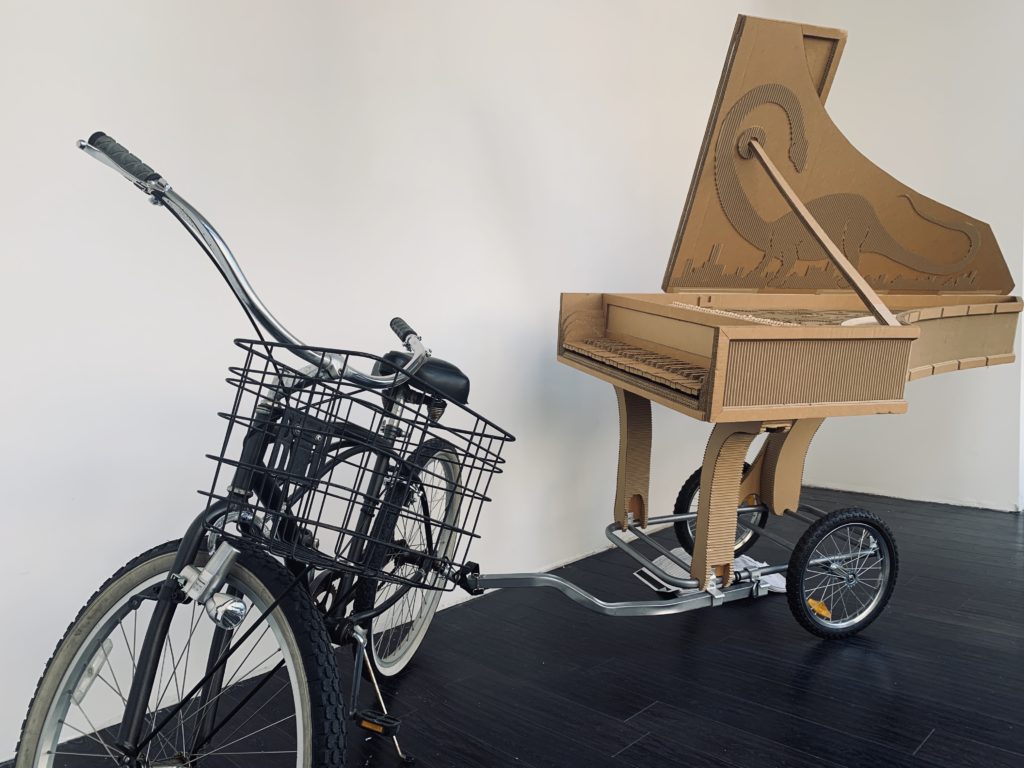
Artist Statement
Artist Bio
Errism: Qubais Reed Ghazala
Fri, Nov 1, 2019 — Sat, Jan 4, 2020
Errism: Qubais Reed Ghazala
Artist Statement
My work often involves reclamation. In the example of circuit-bending this process is obvious: electronics headed for the landfill are reclaimed, reassessed and re-purposed. Rebuilt. Trash becomes instrument; silence becomes sound.
Much of my photography, though not as obviously, involves the same. With a lens I collect these lost cars, abandoned trailers and roadside garbage. And in the magic world of mind I see them as sculpture –– line and emotion innate as rust. Photographically, they are reclaimed. In this, and other experimental photographic work, my use of infrared is common. This show also presents examples of dye migration and suminagashi experiments. Included in this show is the debut of a paper on the idea of errism as it relates to my work and the examples seen here.
While circuit-bending, dye migration and suminagashi are chance-rendered, I believe they are error-sourced, and that this is important.
Artist Bio
Qubais Reed Ghazala (Cincinnati, Ohio, 1953) was first instructed in painting, theatre, and classical piano as a young child (including preschool art courses at the nearby Cincinnati Art Academy, a school he would later attend as an adult).
At the age of five, Ghazala was exposed to his first experimental electronic music on the 45 RPM recording Omicron Visits Earth (by Rege Cordic and Company). Fascinated, Ghazala learned to drop the needle on the grooves containing the oscillator sound effects that began and ended both sides of the record. “I couldn’t get enough of it,” recalls Ghazala. That record is on his studio wall today.
The young Ghazala spent summers in New York’s Greenwich Village with his family. His mother, a public school teacher, photographer and artist, took him to the New York museums, including the MoMA where Ghazala attended a solar refraction exhibit impressing upon him the artistic power of light. He recalls these times as “scary-cool,” as he was allowed to roam the areas of the East Village, Chinatown, Washington Park, alone in the evenings (it would be here, at the Fusion Arts Gallery, 57 Stanton St., that Ghazala would first show his work as an adult in an exhibit with Shalom Neuman, Red Spot, Marc Sloan and others).
By the time Ghazala reached the age of twelve his interest had turned to experimental art (mazes, luminous painting, mirror assemblage, freezing liquids within expandable envelopes — gaining attention and winning awards in local exhibitions for his cubist sculptures and “Frank Lloyd Wright” house models –– he knew nothing about Wright or cubism).
Two years later, when Ghazala was fourteen, he would witness the sounds of a nine-volt mini-amplifier shorting-out in his desk drawer and find the sounds interesting. This event was highly influential, Ghazala would develop both instruments and theories based upon his conclusions, eventually naming his findings “circuit-bending” in technique, under the umbrella of what Ghazala terms errism.
Ghazala was soon expelled from Woodward Junior High School for refusing to dissect a living frog (to observe its beating heart); he happily abandoned formal schooling in favor of his interests, becoming self-taught in his fields. Quoting Ghazala, “I retired at fifteen and I’ve been happily working ever since.”
It was at that age, fifteen, in 1968, that Ghazala finished his first circuit-bent synthesizer, “ran away from home” and travelled with a group of vagabonds to Laguna Beach, California. There he lived out of their communal Frito Lay cookie truck, visited “The Haight,” hung out at The Doors beach house and body surfed in the Pacific until he ran out of cash and was arrested for vagrancy. Reed recalls finding himself jailed for being poor as, “a huge lesson in Americanism.”
Once out of prison, Ghazala returned to Ohio and his electronics with the culture-shock of California a positive force in the momentum of his art and music. Ironically, that same year Ghazala and his band would be attacked on stage for performing with Ghazala’s first circuit-bent synthesizer. Ghazala’s instrument would be destroyed in the brawl.
Ghazala would soon meet with Taj Mahal, Janis Joplin, drum for James Brown’s Charles Spurling, and witness the early performances of Thomas Owen Knight and Bitter Blood Street Theater, a psychedelic art troupe (Ghazala would later record a series of CDs with Owen and the band). It was during this period that Ghazala was exposed to Harry Partch, Penderecki, Cage, Subotnick, Xenakis and the Columbia – Princeton electronic music lab recordings. Reed would later meet with Penderecki and discuss their individual threnodies (Ghazala’s performed on his Vox Insecta insect song synthesizer).
Besides circuit-bending, Ghazala also pioneers work in photography (lens-less imaging with dye-migration materials; time exposure with cross-axis polarization and aperture shift; HDR infrared; found-object lensing), magnetic assemblage (kinetic timepieces, anti-gravity sculptures), magnetic tape instruments (stereo cassette loop, tape canvas, pocket Mellotron), and aeronautics (an operative flying saucer; various kites, aircraft, and solid fuel rockets). Ghazala is credited with inventing one of the first high-voltage plasma touch-globes presented to the public (early 1970’s).
Ghazala’s further experimental arts include electronic smoke and liquid/gel chambers, lenticular art, laser and neon chambers, film and computer animation, video documentary, 3-D drawing and photography, program bending, rubber stamps (as a sampling medium to alter), pyrotechnic sculpture, art and meteorologic mobiles and stabiles, and woodland art for only forest animals to ponder (thought-provoking solar system mobiles and interlocking keystone sculptures).
Much of Ghazala’s art revolves around chance –– instrument design, musical composition, visual art; in 2009 Ghazala was honored as a founding member of MAMA –– The Movement of Aleatoric Modern Artists.
Major instrument shows include Bent Fest (New York, at The Tank with MTV), Fusion Arts (New York, Paris) and Art Basel (Miami).
Ghazala is the author of numerous articles on electronics and experimental musical instruments (including the seminal 20-article circuit-bending series in Experimental Musical Instruments magazine, 1992–98). Ghazals’s book, “Circuit-Bending, Designing Your Own Alien Instruments,” (Wiley, 2005), the first book on circuit-bending, is considered the cornerstone of the movement and, now out of print, has become a recognized collector’s item.
Ghazala is one of the Web’s most influential cyber-professors –– anti-theory.com was the first circuit-bending site in cyberspace, the pebble that tripped the avalanche of sites/instruments/music/teaching to follow. Ghazala also teaches in person via public workshops and one-on-one apprenticeship programs.
Although Ghazala is primarily a music composer and instrument designer, he continues to work as sculptor, photographer, visual artist, author, and in his spare time pursues hobbies of theory-true designing/hacking, building toys, robots, and things that fly; kinetic electro-lumia; working in optical lens construction; practicing kitchen and deep woods cooking; designing/building home additions; canoeing; hunting mushrooms; studying entomology, mineralogy, and meteorology; star gazing; compiling a home library; befriending wild animals and rescuing lost pets, exploring natural incenses and resins, psychedelic and experimental music, unusual lighting, rare musical instruments, antique postcards, home-designed postcards, high-voltage antique medical devices, parlor and stage magic, ESP, unusual natural phenomena and the collecting of unidentifiable objects.
Ghazala has introduced numerous terms to the arts besides “circuit-bending.” Others include the coconut concept, clear illogic, the threshold of invention, errism, and BEAsape (standing for Bio-Electronic Audiosapian, the temporary “new” creature a musician becomes when body-contacting a bent instrument). Quoting Ghazala, “Neither instrument nor player stop at their ends anymore, biologically and electronically it is a new animal.”
Unlikely as it may sound, Ghazala has time-traveled as an adult, sung in unknown languages while asleep as a child, and communicated with spirits through a real-world angel. He has always studied, and seemingly mingled with, the mystic.
Ghazala gives public instrument demos, sponsors music and mushroom gatherings, bat and insect watches, agate hunts and unusual photography field trips. Ghazala’s discography (cassete, CD, vinyl) numbers over 60 releases. Ghazala explains the use of experimental sounds in musical composition, comparing it to the colors on a painter’s palette –– “Every sound, like every color, elicits an emotion. The rest is just construction.”
Ghazala’s work has been covered in much of the world’s major press (including, in the United States, the New York Times, the Wall Street Journal, the Washington Post, The Smithsonian, and WIRED); his work is kept in the permanent collections of The Museum of Modern Art, the Guggenheim, and the Whitney in New York City; he’s consultant for and his instruments have been designed for some of the planet’s best-known musicians including Peter Gabriel, Tom Waits, Towa Tei, Yann Tomita, Sri Chinmoy, the Rolling Stones, Blue Man Group, King Crimson, Kronos Quartet, Simon and Garfunkel, Peter Kember, Chris Cutler, Nine Inch Nails, Faust, Blur, and many others.
Ghazala’s circuit-bending technique is taught at MIT, Harvard and numerous colleges and high schools all over the world, circuit-bending workshops and concerts occur regularly at clubs, museums, galleries and Maker spaces. Reed ls considered to be one of the most influential working artists of the last three decades.
Ghazala is recognized as the father of circuit-bending and is credited with launching the first grassroots electronic art movement.
Guillermo Galindo: Cyber-totemic Objects and Sonic Mediators
Sat, Aug 31 — Thu, Oct 31, 2019
Cyber-totemic Objects and Sonic Mediators
Artist Statement
Artist Bio
Guillermo Galindo: Post-Mexican composer, sound/visual artist, and performer
Galindo’s broad interpretation of compositional concepts such as musical form, time perception, music notation, sonic archetypes and his use of non conventional sonic devices span through a wide spectrum of artistic works involving symphonic works, performance art, computer interaction, electro-acoustic music, opera, film, instrument building, installation and live improvisation. His acoustic compositions include two symphonies commissioned by the Mexico University Symphony Orchestra (UNAM), the Oakland Symphony Orchestra and Choir, and two operas.
In 2018, Galindo’s interactive string quartet commissioned by the Kronos Quartet as part of the Fifty for the Future project, was premiered at the San Francisco Jazz Festival. In 2016 Border Cantos, Galindo’s collaboration with photographer Richard Misrach addressing immigration issues through photography and sound culminated with an award winning book published by Aperture Foundation and several traveling exhibits from 2016 until 2021. Guillermo Galindo’s sonic devices and installations have been shown at the Phillips Collection DC (2019), Crystal Bridges Museum, Arkansas (2017) and ocumenta14 art biennale in Athens, Greece and Kassel, Germany (2017) , Pace Gallery in New York (2017) and will be shown at the ICA Boston (2019), and the Missoula Art Museum in Montana (2019). Cantor Museum in Stanford (2020).
Galindo has also performed at the CTM festival in Berlin, the Schirn Museum in Frankfurt and the Havana Art biennale. His work has appeared in NPR All things Considered, CIty Arts and Letures, CNN, NBC and the New York Times. Guillermo Galindo’s sonic piece Fountain of Tears/Fuente de Lagrimas will be eshown at the New York High Line from 2020-2021.
Atrium Display: Still Movie – Film Frames by David Michalak
Sun, Oct 20 — Thu, Oct 31, 2019
Atrium Display: Still Movie – Film Frames by David Michalak
Face of A Stranger (1977) is a restored feature film by San Francisco filmmaker and musician David Michalak. Prints of selected film frames are on exhibit at Center for New Music, corresponding with a special screening of the film and musical performance on Wednesday, October 23rd.
Artist Statement
While restoring Face of a Stranger (1977) from tiny super-8 film to a 2K file I noticed how the film’s chemistry had shifted causing an increase in grain and creating an occasional sepia tinted splash across the frames, highlighting the images. I tracked these affected images down, frame by frame within the 24 frames per second drama, finding single frames that symbolized and summarized an entire scene, or psychological state; a still movie. The altered chemistry serves the images with a kind of aged photographic wisdom extending them into a new realm.
Artist Bio
During his long creative life Michalak has been a photographer and graphic artist, a filmmaker of over 50 films, a recording engineer and musician – performing and recording with Ghost in the House, T.D. Skatchit, Dr. Bob, Reel Change and others. Showcases include: the Castro Theater in S.F., The Cannes Film Festival, The S.F. International Film Festival, Everson Art Museum and countless other minor venues. He has also produced film and music festivals of his own, including The Richard Waters New Music Festival and The Filmmakers Festival.
About the Film
While famed director Nicholas Ray worked on his “experimental” film with students at SUNY COLLEGE in Binghamton, N.Y., local upstart David Michalak worked on his own feature, paying tribute to shadowy German expressionism, silent movies and the serials of the 1920s.
Not a word is spoken in this tale of a kind-hearted man who turns to cruelty when his lover dies an unexpected tragic death. His sanity is challenged further when he meets a woman bearing a strong resemblance to his deceased partner . Expression and gesture covey the story. Michalak shot the film on location at a restored turn of the century house, a rock quarry (The Devil’s Punch Bowl) and in the lush forests of upstate New York with his film company Eye-Full Films.
 James Russell Lowell’s review from the premiere at Roberson Museum in 1977 is, in part, quoted here, calling the film:
James Russell Lowell’s review from the premiere at Roberson Museum in 1977 is, in part, quoted here, calling the film:
“remarkable….poetic and hypnotic…”
“David Michalak’s folkloric opus transports his audience into a world shared by UFA expressionists of the silent era yet it possesses a wonderful, uncanny immediacy – both poetic and hypnotic.”
The film is full of nightmares, dreams and visions of a love lost and features glowing performances by Billie-Marie as both the haughty Otillia and servant Anna.
“What a revelation it is to see an actress like Billie-Marie who truly, innately, comprehends the visual relevance of cinema! She endows her face – her every gesture – with emblematic meaning, conveying an almost unearthly quality. Michalak’s camera, script and direction allow us to see her as the ultimate trusting soul; accepting one fate after another, finding empathy only in a dancing dream-clown, who all-too-briefly enchants her.”
The films also stars: David Gardner as Gunnar, Gerald Michalak as Jarl and Michael Butler as Hynek who dances.
Atrium Display: Skatchplatters by Tom Nunn and Sudhu Tewari
Fri, Sep 20 — Sun, Oct 20, 2019
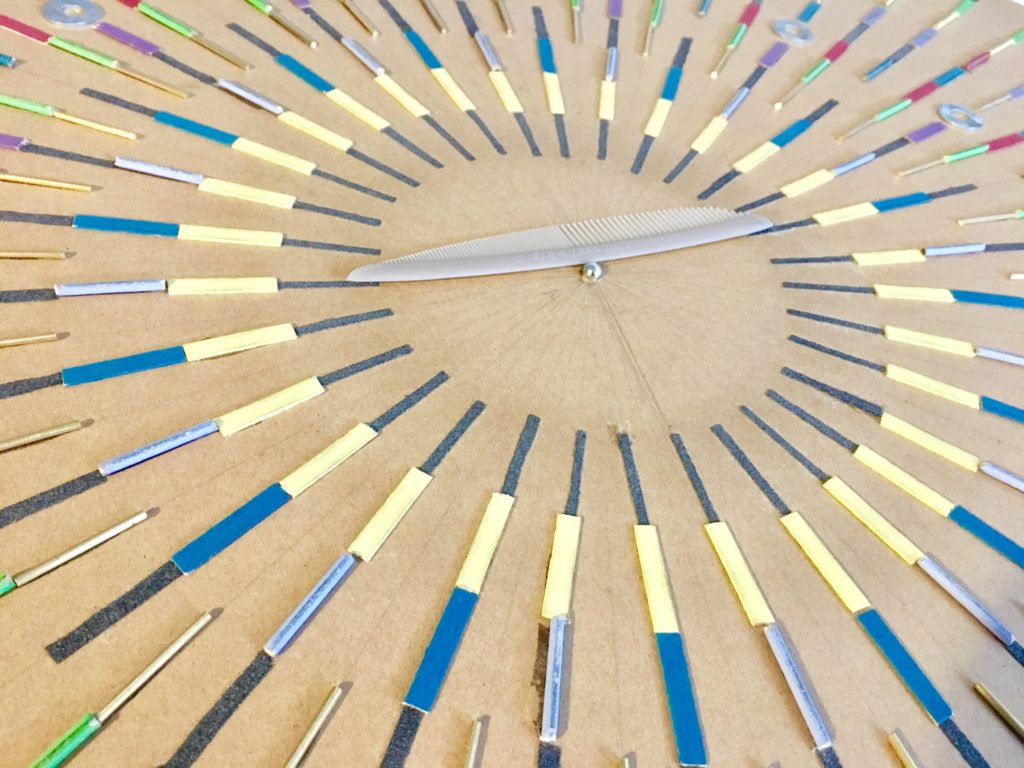
Atrium Display: Skatchplatters by Tom Nunn and Sudhu Tewari
Artist Statment
Skatchplatters (12” diameter), Skatchwheels (22” diameter) and Giant Skatchwheels (33” diameter) are circular cardboard plates onto which are glued various “devices” arranged in a 32-segment array. The devices include thin dowel, coffee stirrer sticks, bronze brazing rod, metal washers and non-skid self-adhesive surface material. These instruments have a center hole and are designed to be played on a turntable by “skatching” [sort of scraping] various kinds of plastic combs across the surface as the plate turns. The arrangements of devices create definite “tracks,” as on a record, and these tracks are generally 1.25” in width (i.e. the devices [except washers] are cut to a length of 1.25”). The Skatchplatters have narrower tracks and overlapping devices of different lengths, creating track widths of 1” or less. There are generally 4 or 5 tracks. Using 1.25” as a standard device length, the Skatchwheels have 8 tracks, and the Giant Skatchwheels have 10 or 11 tracks.
Skatchplatters (made using 12” cake bottoms) can be played on an ordinary record turntable. Such turntables usually have two speeds, 33 and 45 (rpm). One can also turn the Skatchplatter by hand with the motor off, varying the speed. Skatchwheels and Giant Skatchwheels require the removal of the record player’s tone arm and assembly because the plate extends over that area. Sudhu Tewari has adapted a record player turntable for live performance to allow a continuous range of speeds. He has also constructed special motorized turntables with variable speed control by pedal or computer program that can be used in performance or for installations such as this one.
Artist Bios
Tom Nunn has designed, built and performed with original musical instruments since 1976, having received a B.Mus. and M.A. in music composition from the University of Texas at Austin and S.U.N.Y. Stony Brook, and post-graduate work at U.C. San Diego. His instruments typically feature commonly available materials, are sculptural in appearance, utilize contact microphones for amplification, and are designed specifically for improvisation with elements of ambiguity, unpredictability and nonlinearity.
Tom has performed extensively throughout the San Francisco Bay Area for nearly 40 years, as well as in other parts of the U.S., Canada, Europe, and New Zealand, both as soloist and with other musicians. Tom has performed with various groups over the years and currently works with T.D. SKATCHIT, RTD3, GHOST IN THE HOUSE and MUSIC FOR HARD TIMES. In 1998, he completed writing and self-published WISDOM OF THE IMPULSE: ON THE NATURE OF MUSICAL FREE IMPROVISATION (now available through Frog Peak Press), a book that examines various aspects of this illusive art and presents a theoretical foundation for creative listening, analysis and discussion. Tom has also written a number of articles about the use of experimental instruments and improvisation in publications such as EXPERIMENTAL MUSICAL INSTRUMENTS, MUSICWORKS and LEONARDO.
Sudhu Tewari has been called a professional bricoleur, junkyard maven, and young audio-gadgeteer. Sudhu builds audio electronics, musical instruments, kinetic sculpture, interactive installations, wearable sound art, and sound sculpture. Highly educated at Mills College in electronic music, and the recent recipient of a PhD from UC Santa Cruz in Cultural Musicology, Tewari has been seen performing improvised music on the east and west coasts of the US, Europe, and Japan. Tewari’s visual and interactive art has been exhibited at Swarm Gallery, 21Grand, ProArts, FLOAT Gallery, the Oakland Museum of California, the Center for New Music, SFMOMA, Montalvo Arts Center, UC Santa Cruz, UC Berkely, the Tech Museum, the Exploratorium, Laboratoire Village Nomade, and PROGR. Sudhu Tewari has been teaching electronics and sound art to children and adults since 2009 and continues to build and perform with self-governing musical systems and self-built musical instruments.
Special Thanks to David Samas for collaboratively conceiving of these instruments with Ian Saxton and Bart Hopkin; to Barney Haynes for custom 3d printing and Daniel Yasmin for custom machined parts.
Atrium Display, Roxanne Nesbitt: Symbiotic Instruments
Thu, Aug 1 — Sat, Aug 31, 2019
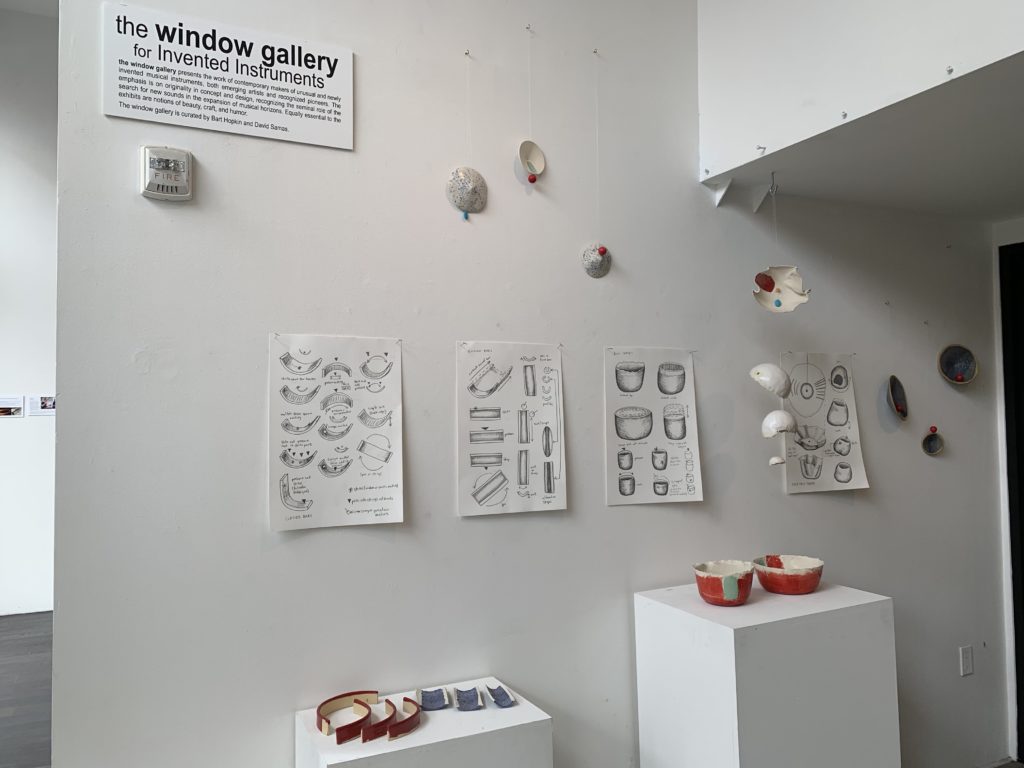
Atrium Display, Roxanne Nesbitt: Symbiotic Instruments
For my on-going project Symbiotic Instruments, I design and make sounding objects to expand the sound palette of traditional instruments. I have explored stretching strings over drums with percussive handmade bridges, and ceramic instruments played inside the grand piano. The ceramics alter the sound of the piano by muting the strings and highlighting harmonic nodes. They are also resonant percussion instruments unto themselves.
The work evolves and grows. Symbiotic Instruments started as a sonic investigation, fueled by a playful curiosity into the strange sound world of altering instruments. Now it means something more to me.
I am interested in juxtaposing the mass produced standardized, highly tuned instruments, with the intuitive work of the hand. With ceramics, this is also about bringing domestic-like objects, tools for “women’s work,” into my sound palette. By making my own instruments, I seek to divorce myself from macho, misogynistic attitudes, which still dominate avant-garde, experimental music and new instrument design.
After all, I was first impressed by ceramic sounds when cooking, cleaning, and washing dishes.
The drawings show techniques used to play the instruments and symbols I use in my scores when composing for these instruments. The symbols are part of on-going research and development of a performance lexicon. This research is indebted to drummer/ percussionist Ben Brown, and pianists Lisa Cay Miller and Cory Smythe.
Artist Bio
Trained as an architect and orchestral contrabassist, Roxanne Nesbitt is an interdisciplinary artist, investigating the space between sound and design. Her research includes contemporary classical composition, electroacoustic music, improvisation, experimental instrument design, sound installation and performance.
Recently, Roxanne has focused on her project, symbiotic instruments, where she designs, builds, and composes for “parasite-like” acoustic instruments that are played in or on existing traditional instruments. With the support of the Canada Council, Roxanne made 146 ceramic percussion instruments and composed five new pieces which were debuted, at a recent concert at the Western Front in Vancouver, Canada.
Roxanne collaborates with dancers and choreographers as a performer and composer. In January 2019, Roxanne composed a live electroacoustic score for the Biting School’s Suddenly Slaughter, presented at the PUSH festival. Roxanne also fronts her own band, Graftician as vocalist /noise maker. Recently, Graftician released the EP Mandarins, which explores the ephemerality of love and self through vivid samples, poignant lyrics, and creative orchestration. She is a member of the improvised duo, why choir alongside Juno-award winning drummer Ben Brown.
Roxanne is half-Trinidadian and residing on the unceded Coast Salish Territories aka Vancouver, Canada.
Johannes Bergmark: How Do You Invent Something?
Mon, Jul 1 — Tue, Aug 27, 2019
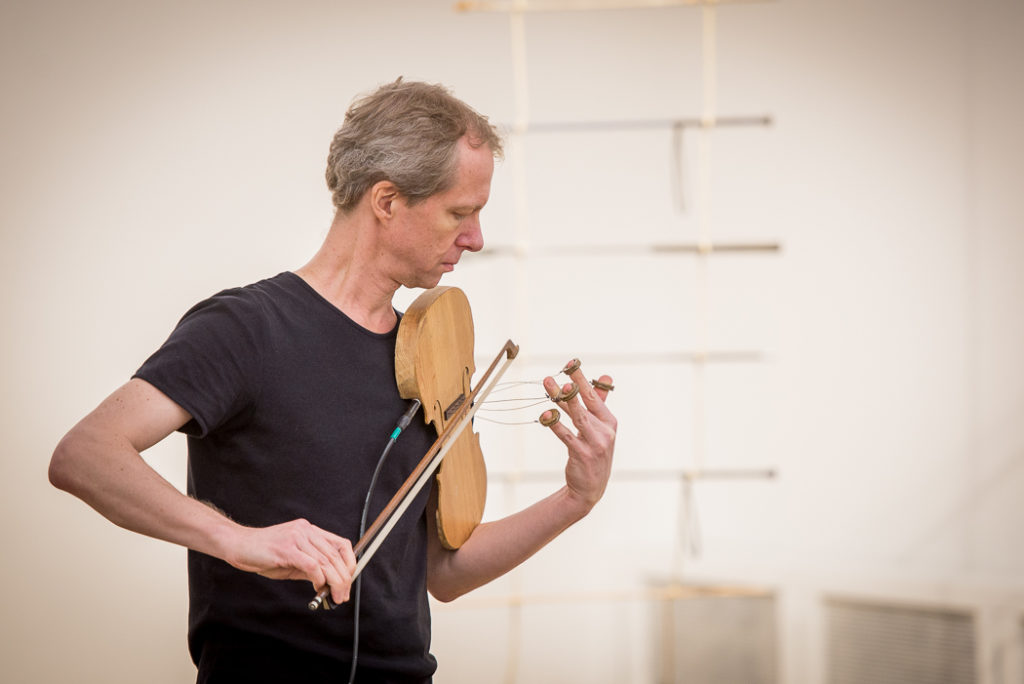
Johannes Bergmark: How Do You Invent Something?
Artist Statement
Meeting Hal Rammel in Chicago in 1987 was the decisive moment for me to open my eyes for experimental musical instrument (EMI) building, through his beautiful and imaginative work, generous friendship and the collaborations that we did. He also let me know about the inspiring network of inventors to be found in and around the magazine EMI, edited by Bart Hopkin. After some years, I also published an article about my work in there. To be invited to exhibit, some 30 years later, by Bart Hopkin, is like the journey has come to a full-circle and a dream come true. Although there is only space for some of my portable favorites, others will be displayed in photos and explanations.
The title refers to my noticing that every instrument I made has had a different kind of idea as a source. They are examples of dreams, whims, discoveries, chance occurrences, materials, playing methods etc. Funnily enough, never has the sound come first. A large part of the explanation for the multiplicity of sources of invention is an improvisatory practice and a surrealist, poetic attitude where playful, associative, analogic thinking comes before the goal-oriented approach that might follow.
I hope the exhibition will inspire both musicians and non-musicians, and hope that I too am inspired through the process of making it and meeting the people appearing at the exhibition.
Artist Bio
I am a multidisciplinary artist working mainly in the fields between free improvised music, experimental musical instruments making, sound poetry, text-sound composition, sound sculpture, sound installations, sound environments, workshops and lectures for all ages, and critical and poetic writing.
Since my education as a piano and harpsichord builder, which I graduated from with a Gesellenbrief in Germany 1996, I have been a freelance musician and artist as well as a piano technician. In 1999-2000 I studied at the Elektronmusikstudion in Stockholm in electro-acoustic music composition. I also have a background in butoh, theatre, and jesting.
At present (until May 2019), I am doing my master’s thesis which involves improvised music and an experimental musical instrument construction.
My main focus is in creating experimental musical instruments, or more precisely, poetic material interfaces for sound exploration and adventure. This also includes selected found objects that I use as instruments but which also become actors in a musical object theatre.
I have done several projects and interactions that involve available resources and found materials on sites that I come to more or less empty-handed.
Atrium Display, Musicians Make: Comic Strips
Mon, Jul 1 — Sun, Jul 28, 2019
Atrium Display, Musicians Make: Comic Strips
Polymaths are often musicians and the talents and proclivities that make for great musicians quite often make for brilliant artists, engineers, mathematicians, activists, chefs, philosophers, poets, painters, cosmologists and gardeners. Society seeks to simplify and pigeonhole these geniuses and so too often their broader gifts are considered tangential rather than integral, like facets of a single splendid jewel.
In this series of exhibitions we explore non-musical works of artistic and cultural value created by members of the community primarily known for their music. – David Samas, Curator
Artist Bio
Jason Berry is a sound and visual artist based in the San Francisco Bay Area. Since 1989, he has been the artistic director of the musical ensemble Vacuum Tree Head.
Fiction and Fables: Compositions Through Sonification
Thu, May 9 — Sun, Jun 30, 2019
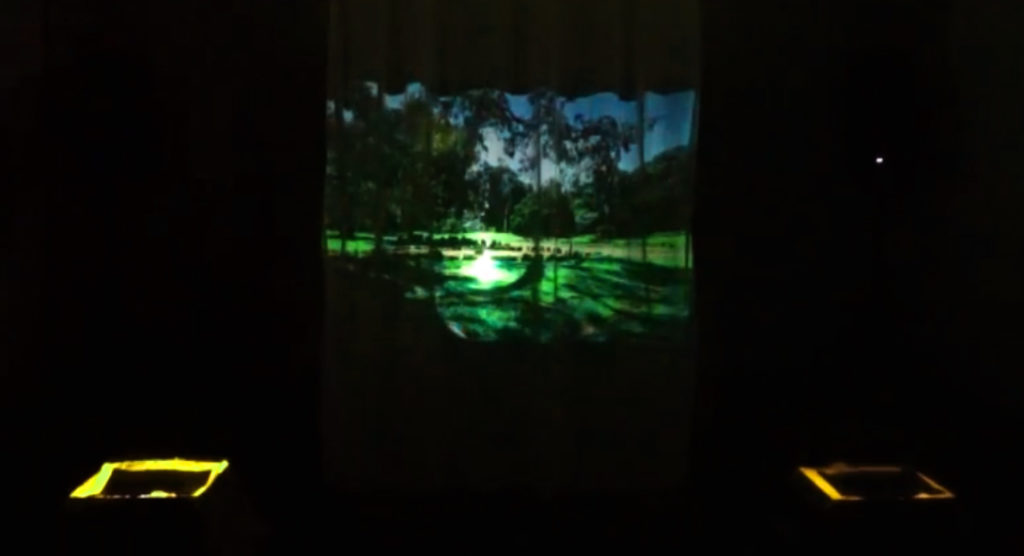
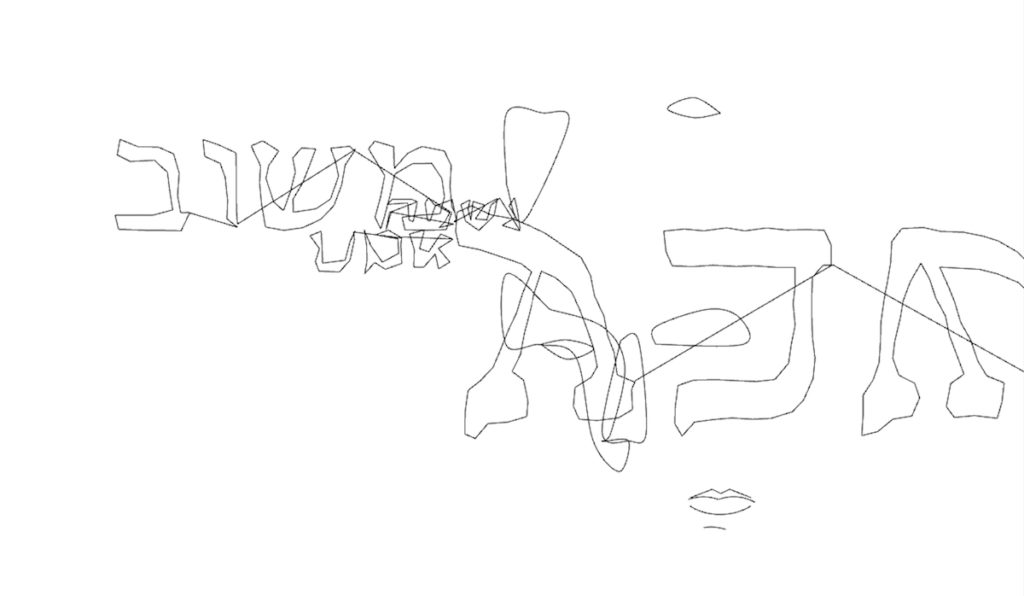
Fiction and Fables: Compositions Through Sonification
Curated by Eliza Phelan-Harder
Fiction and fables are a part of a long history of storytelling. Every culture has its own stories or narratives, which are shared as a means of learning, teaching, preservation of cultural histories or instilling moral values. Interpretation of tales are embedded through social practice and hold certain values. Our lives are narratively engrained, humans construct their existence and shape themselves from collective memories that are passed to them. This show extends itself to representing personal narratives, political commentary and expanding cultural standards. Fiction and Fables: Compositions through Sonification explores a multitude of storylines through sonic mediums.
About the Artists and Curator
Julia Fairbrother is an interdisciplinary artist whose work challenges the social, political and economic processes associated with the evolution of science and technology.
Giuliana Funkhouser combines digital code and imagery with analog stills and animations to produce story driven art installations.
Raven Kemp and JoseIgnacio Ramirez form their collective Turwv De Venado. This collective creates visualizations of indigenous stories and sonifying them.
Steph Kudisch is a genderfluid artist reinterpreting Jewish myth and tradition.
Michael LaRocco work as a writer, filmmaker, and sound artist is primarily concerned with shattering barriers, provoking dialogue, and presenting alternative narratives about social and political issues with a decidedly queer bent.
Amina Shah work explores the ideas of cultural identity referencing colonial history, diasporic experiences, and political landscapes.
Curated by Eliza Phelan-Harder who is an interdisciplinary artist working in sound through a deaf lens, photography, and installation art.
All artists and the curator have a connection to San Francisco Art Institute, from current students to alumni. This collaboration with the Center for New Music is to help demonstrate SFAI upcoming Sound program.
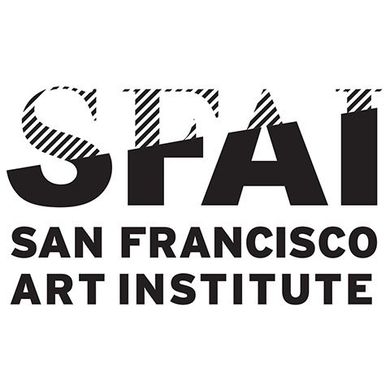
Atrium Display: Graphic Scores/Spores by Alan Courtis
Sat, Jun 1 — Sun, Jun 30, 2019

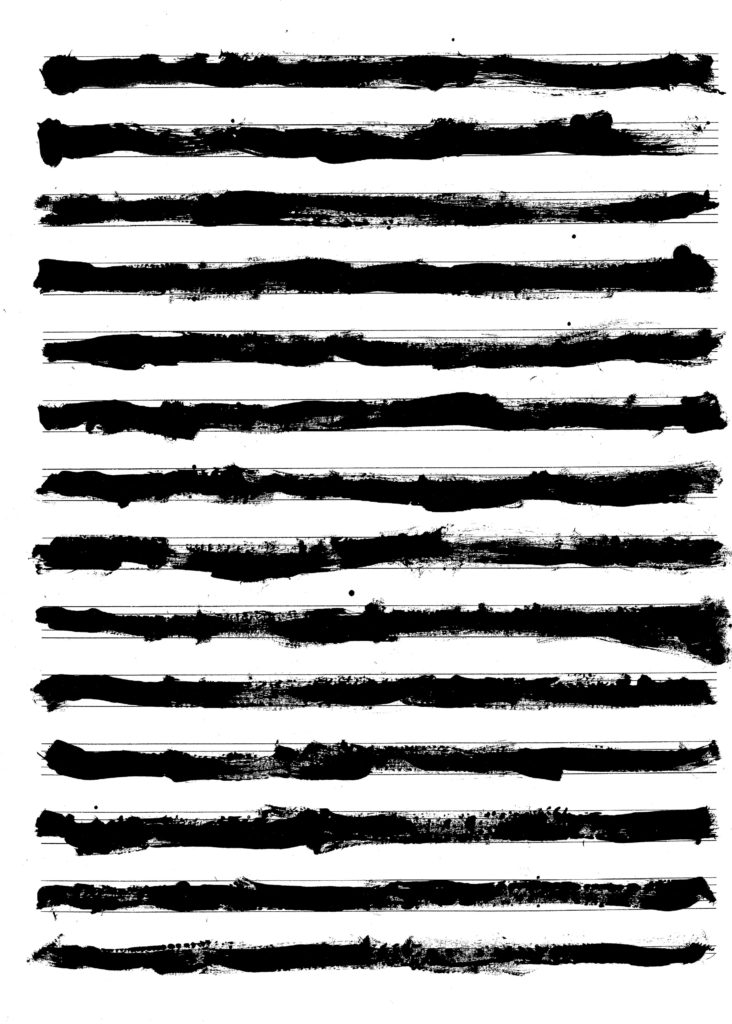
Atrium Display: Graphic Scores/Spores by Alan Courtis
This exhibition shows for the first time in USA graphic scores by Argentine composer Alan Courtis. It consists in a selection of graphic and conceptual pieces employing diverse techniques and strategies helping to connect the graphic and sound universes. Some of these scores work defining precise interpretation codes, some others leave all to the interpreter’s imagination. In between of both poles, we can find a wide spectrum of possibilities including: traditional notation, anomalous scripts and “imposible” writting. Most of these scores are unreleased except for few of them which were published on the specialized books like “Deep Listening Anthology Vol2” (Deep Listening Publications) or “Tonebook” (Inpatient Press). There are also some new compositions exhibited for the first time.
Recent Exhibitions:
Cruce. Madrid. Spain. 2019
Art & Space Cococara. Tokyo. Japan. 2018
BAfoto. Fuera de Foco/Fundación El Mirador. Buenos Aires. Argentina. 2018
Laboratorio Proa21. Buenos Aires. Argentina. 2018
Centro de Exposiciones Subte. Montevideo. Uruguay. 2018
Artist Bio
Alan Courtis was born in Buenos Aires in 1972. He has been working in the field of sound-art, electro-acoustic music, drone, noise, improvisation and composition. His written music has been played by ensembles from England, Thailand, Switzerland, Wales, Netherlands, Mexico, Canada, United States, Spain and SouthAmerica. He was commissioned by Phoenix Basel Ensemble (Switzerland), Český Rozhlas (Czech Republic) and was artist in residence at EMS (Stockholm), GRM (Paris), Cafe Oto (London), USF (Bergen), etc. He has more than 400 solo releases and collaborations on respected labels. Courtis has toured internationally extensively, and has collaborated with musicians like: Pauline Oliveros, Phill Niblock, Keiji Haino, Merzbow, Lee Ranaldo, Jim O’Rourke, David Toop, and numerous others. His music always has strong experimental sense and usually based on high-skilled techniques of prepared sound, tape manipulations, processing of field recordings, live electronics, objects, cymbals, synthesizers, computer tools, playing traditional (both acoustic and electric) instruments as well as self-built, strange and unusual instruments (eg. unstringed guitar). Courtis has made music for films/videos by Jaime Davidovich, Claudio Caldini, Greg Pope, Hang Jun Lee, Sergio Subero, Pablo Mazzollo, Guillermo Ueno, etc. He has also coordinated a many music workshops internationally.
Atrium Display: Leonardo at 500; Homage and Excuse by Larnie Fox
Wed, May 1 — Fri, May 31, 2019


Atrium Display: Leonardo at 500; Homage and Excuse by Larnie Fox
Homage
Leonardo da Vinci was an early holistic scientific thinker. He didn’t recognize the boundaries between art and science. He didn’t recognize the boundaries between scientific disciplines. Quite the contrary, he brought everything he knew to bear on every problem he dealt with ~ and he dealt with many problems in many fields.
As Fritjof Capra points out in his book The Science of Leonardo, Leonardo’s science was synthetic as opposed to analytic. Our culture’s left-brained science ~ and general view of the world ~ looks at our environs and ourselves as mechanisms that can be broken down into their component parts and thus comprehended. What this world view does not take into account is that by splitting living systems into component parts, the systems are then killed, or made available for killing in order to understand and then utilize them. We see the tragic results of this kind of reductionist thinking manifested in our world in too many ways. Leonardo’s holistic view of the world represents an antidote to that kind of reductive thinking. It is unfortunate that he and his heirs made small efforts to publish his work. Had they done so, his influence may well have eclipsed that of Galileo and Newton.
There are lessons to be drawn from Leonardo’s work that are increasingly relevant today: There are deep connections between them microcosm and the macrocosm. The earth, and likely the cosmos is a living system. Rigorously following one’s own interests and inclinations may be more productive than falling in line with the demands of the hierarchy. Rational and spiritual thought are not mutually exclusive. Close observation, unbiased investigation and radical curiosity may save us.
Excuse
Two and a half years ago curator David Samas flattered me by asking if I would like to do a show on the occasion of the 500th anniversary of Leonardo’s death (May 2, 2019). I think he asked me because he’d seen some studies for ornithopters and other contraptions that I had made in my notebooks, slightly reminiscent of Leonardo‘s. He also knew that, like Leonardo, I designed musical instruments.
Around the same time, my wife Bodil and I were honored with a residency at the Montalvo Arts Center. When we were there, I began re-evaluating the studies, sketches, and ideas in my notebooks. I began seeing them as art, not just as a preparation for art making. I noticed a qualitative difference in studies for projects, as opposed to renderings of the projects after the fact. The studies were much fresher and authentic. In order to make them more solid, more like “real art“, I begin keeping my notes on wooden panels supplied by Ruszel Woodworks. (Thanks Jack!). Later I collaged actual notebook pages onto wooden panels after copying them for replacement in my notebooks. I also started doing studies on larger panels, like my Artist’s Coffee Table. I began to use such panels to build new instruments or sculptures, or other items, such as toilet paper roll holders.
In spite of the fact that I lack a significant percentage of the the master’s skills, intelligence and energy I still identify with him. Like Leonardo I keep notebooks, paint, make sculptures, design musical instruments, have an interest in spiritual geometry, leave many projects unfinished, don’t recognize the boundaries between art and science, don’t like being told what to do, skip from medium to medium, and while I’m working on one project my mind is often elsewhere.
For the past couple of years I have used this upcoming show as an excuse to immerse myself in the master’s history and work. I spent time in the library, I read books, I looked at tons of images and stood in front of some of his best work at the Louvre. I looked at my notebooks and studies in a new light. I encouraged my own curiosity.
I hope this exhibition encourages your curiosity.
Larnie Fox
3/31/19
Larnie Fox is a visual and sound artist known for monumental bamboo sculpture, sound installations, performances and painting. His kinetic/sound sculptures and new instruments have been shown in numerous one-person and group shows and performances in the SF Bay Area and nationally. He is a founding member of 23five, a non-profit to promote sound art, directed the Crank Ensemble who performed on hand-cranked instruments he built, and currently is performing with the new music group Contraption Quartet. He holds an MFA in Painting from the University of Utah and is the former Executive Director of Arts Benicia and former Director of the Children’s Fine Art Program at the Palo Alto Art Center. He lives, works and collaborates with his wife Bodil in Benicia.
Bells
Fri, Mar 1 — Tue, Apr 30, 2019
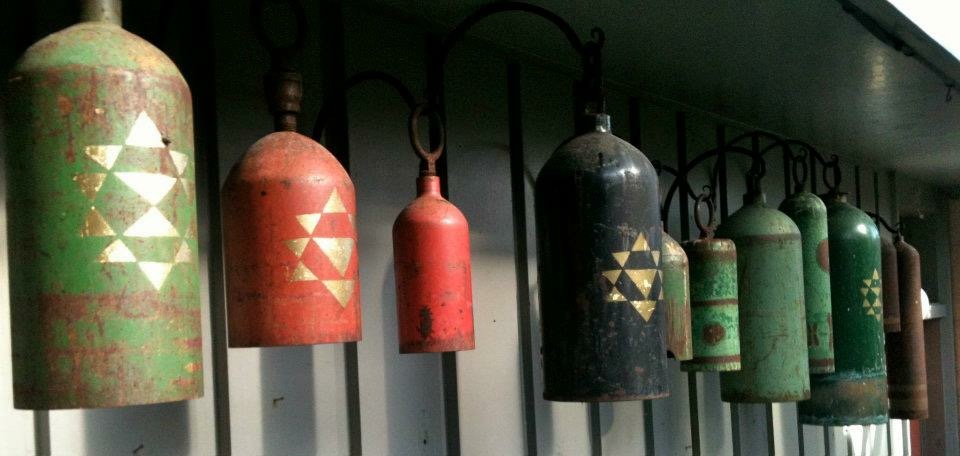

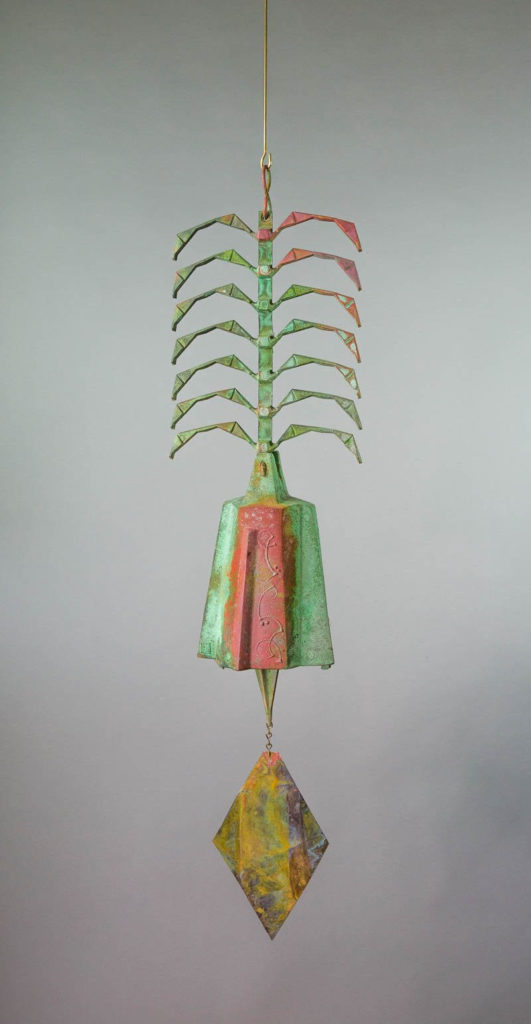
Bells are as old as time, marking its stately passage with roots in ancient Asia, Europe and Africa over 4000 years ago. Casting bells is often a ritual affair, whether in clay, crystal or bronze; even the act of playing a bell has ceremonial overtones, often reminding us to be present.
Acoustically, bells are characterized by modes of vibration having a node at the top or center, and more active vibration toward the rim. Bells are often rich in inharmonic overtones, summation tones, and beating patterns which entrain brainwaves. Historically, these overtones were tuned by artfully weighting nodes through varying their mass, while many contemporary commercial bells are machine lathed. The bells exhibited here have been all been masterfully cast, or found and repurposed.
Nick Diphillipo’s now life long interest in the profession of metal casting accompanying a passion for sound and music found a natural union in bell creation. An early interest in architecture led him to Paolo Soleri’s experimental urban project Arcosanti in Arizona. The project was partially funded by the manufacture of bronze wind bells at a foundry on site. This led to a sideways career switch from buildings to metal casting; eventually managing the foundry there and embarking on an exploration of bell design.
Nick spent last few decades learning and practicing the metal casting craft and developing techniques and designs in bell making. He is currently the Foundry Dept. Head at The Crucible in Oakland Ca. where, among other things, he teaches an annual class in bell making and is the casting director at Artworks Foundry in Berkeley Ca.
Brenda Hutchinson is a composer and sound artist whose work is based on the cultivation and encouragement of openness in her own life and in those she works with. Through her work with large-scale experiments in socially based improvisations and interactions, Brenda has developed a body of work based on a perspective about interacting with the public and non-artists through personal, reciprocal engagement with listening and sounding.
Tay Gersbach is an Artist, Musician and Educator living in El Cerrito, CA. As a graduate of California College of the Arts (Individualized, BFA 2015) she studied bridging the gaps between art and music through Sculpture, Community Art, and Sound. Taylor teaches Wood Shop at Aurora School, and private instruction in drawing/painting, prop shop, printmaking, ceramics, ukulele, songwriting and voice. When she is not teaching, you would find her Directing the monthly event, Bay Area Arts Mixer (BAAM), performing with her band Tay and the JangLahDahs, and engineering music and music videos as JangleTown Productions.
Bart Hopkin is maker of acoustic musical instruments and a student of musical instruments worldwide. From 1985 to 1999, he edited the quarterly journal Experimental Musical Instruments. The journal served as an essential resource and clearing house in an otherwise scattered but lively and growing field. During those year and in the years since, Bart has written over a dozen books on instruments and their construction. In recent years, Bart has focused more than ever on the making of one-of-a-kind musical instruments, assembling a collection of well over a hundred unique types (to see them, visit www.barthopkin.com). In his work as an instrument maker, Bart’s primary interest has been in exploring diverse acoustic systems. His Savart’s Wheel, a tuned, motor-driven scraper with a range of over two chromatic octaves, is one of the most irritating musical instruments ever devised.
Paolo Soleri (21 June 1919 – 9 April 2013) was an Italian architect, designer and inventor of the wind bell with features a sail on the clapper. He established the educational Cosanti Foundation and Arcosanti: an idealogical social sculpture blending art, ecology, architecture and social models. He finally won a National Design Award in 2006.
For 50 years, the Paolo Soleri Studios have produced a wide range of bronze and aluminum sculptural pieces renowned the world over. The bronze and aluminum foundry at both Cosanti and Arcosanti typically pour two to three heats, a hundred pounds of bronze a day, with an average of 50 bells a heat. Sand casting, lost Styrofoam and lost wax techniques are used to create large mobile-like bell assemblages. Custom pieces with both patina and burnished finishes are sought after by collectors and adorn public and private buildings, residences and art galleries around the world.
GRAMMY wining vocalist David Samas is a polymath composer, conceptual artist, instrument inventor, curator, poet, painter, shaman and permacultualist native to San Francisco. He has a BFA in Conceptual Art from the SF Art Institute, and is a certified hypnotist, sound healer and Reiki master. He has performed commissions at the SF Asian Art Museum, Berkeley Art Museum, Oakland Museum of California, SF Spiral Dance, Stanford’s Bing Hall and CCRMA, Grace Cathedral, the Exploritorium, The Lab, Safehouse for the Arts, Cal Shakes and the the Tenderloin National Forest.
He is director of Pet the Tiger, a Bay Area instrument inventors collective and curates the Window Gallery for invented Instruments at the Center for New Music SF. He is the founder and primary composer for of the Harmonic Series Gamelan and also performs in Gamelan Encinal, both in Just Intonation. He was curator for the Meridian Gallery’s Composers in Performance Series and the Turquoise Yantra Grotto and has been festival director for Thingamajigs and MicroFest North. David gives back to his communities through acoustic activism, the preservation of rare art and instruments and by teaching physics and math through instrument building in the Oakland School District.
Atrium Display: Free Improvised Paintings of Live Improvised Music
Mon, Apr 1 — Tue, Apr 30, 2019
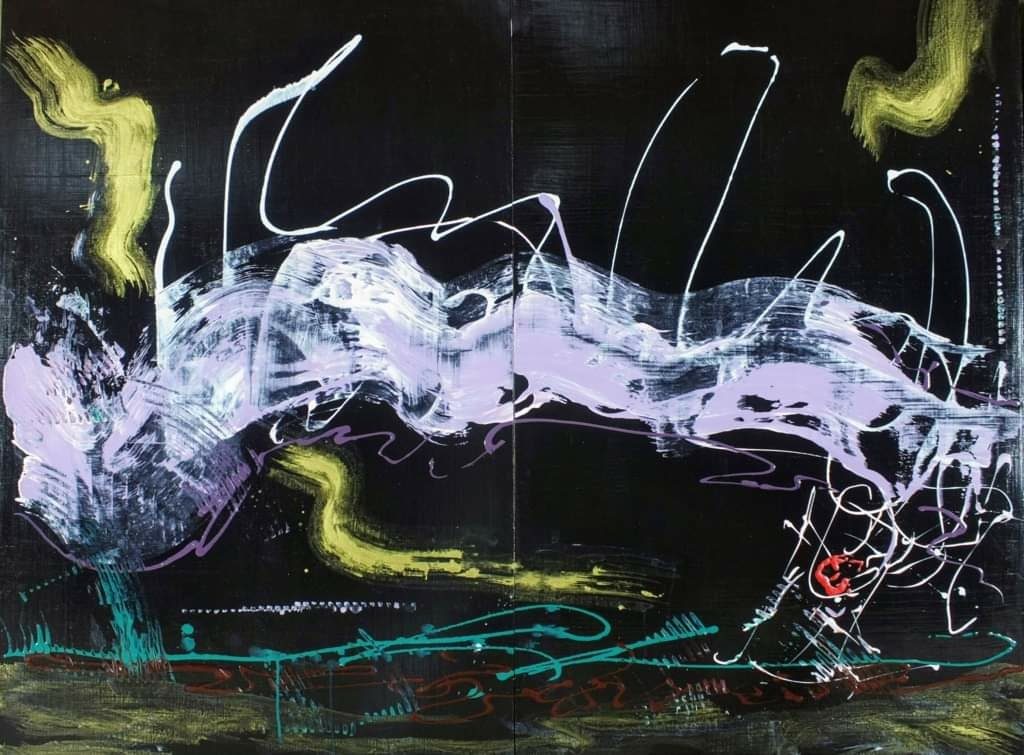
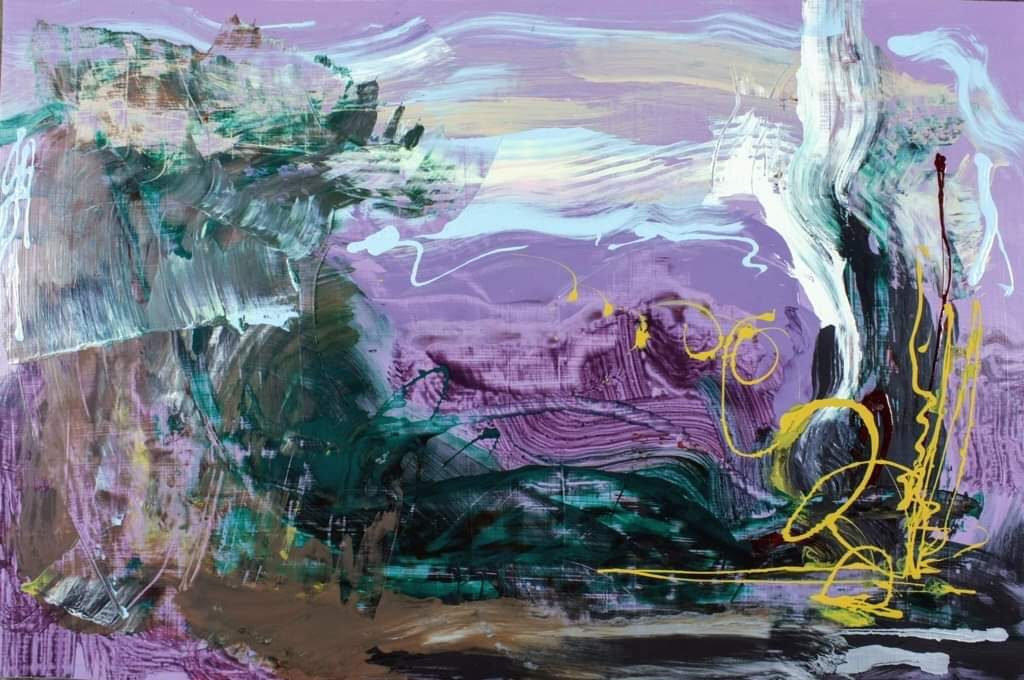
Atrium Display: Free Improvised Paintings of Live Improvised Music by Ethan Cranke
In April of 2018, Ethan came to the Center for New Music to paint the sounds of Gino Robair, Tom Dimuzio, Tim Perkis, and David Samas. Their ecstatic improvising was captured here in bold, gestural acrylics. Many people are familiar with the idea of improvising from a visual score, but it is less commonly know that abstract painters often live compose paintings to the music that inspires them. Performing together, all the elements live on stage, is what makes this sort of collaboration rare and satisfying.
-David Samas, Curator
Having been a professional painter for over twenty years, Ethan Cranke continues to challenge himself within his daily art practice via a plurality of approaches and methods, the results of which have currently led him down the path of abstraction. Although Ethan is in no way new to the abstract, having originally made his way into art school as an abstract painter, he has been painting landscapes almost exclusively over the last five years, and is very excited to be rediscovering the musicality of his mark making.
Artist Statement
I have always looked at my palette as a keyboard/fretboard/etc. Having received my first electric guitar and amplifier at age five, plunked my first piano keys much earlier, and having spent many years singing with my sister and mother (a trained classical musician and choral singer), learning harmony, pitch, key, etc., the relationship between my approach to a keyboard and my palette has always been quite simpatico. Rhythm, harmony, and key are always foremost in my mind. So, to combine a performance of my mark making skills and the sound making skills of my fellow performers seems like a perfect fit.
Atrium Display: Hacked-Found-Repurposed Vol. 2
Fri, Mar 1 — Sun, Mar 31, 2019
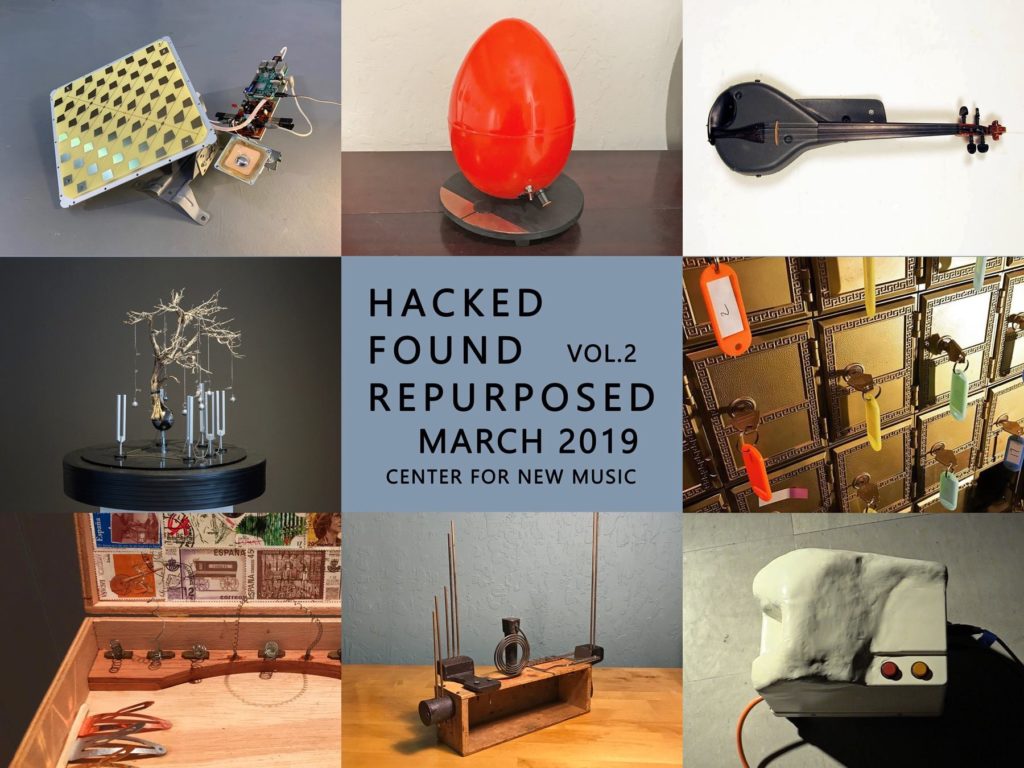
Atrium Display: Hacked-Found-
Curated by Bryan Day
Hacked-Found-Repurposed Vol. 2 is an exhibition of upcycled sound art pieces and invented instruments. The pieces on display highlight an ad-hoc approach to instrument design, using found objects to create both utilitarian and conceptual sound-art objects. On display are works by Tore Boe, Tad Ermitano, Blake Hargreaves, Ellen Juhlin, Frank Pahl, Anja Ulfeldt, Ken Butler, Jay Kreimer, Don Hanson, Michael Gendreau, Dan Ake, Pål Asle Pettersen, Tay Gersbach and John Weiss.
Bryan Day started designing and building musical instruments in rural Iowa in the mid-1990s. Bryan has toured and has taught sound-invention workshops throughout the US, southeast Asia and across Europe and runs the experimental music record label Public Eyesore. He spends his days designing, building and fixing exhibits at the Children’s Creativity Museum and Exploratorium in San Francisco.
Atrium Display: Musicians Make Garments
Mon, Feb 4 — Mon, Mar 4, 2019
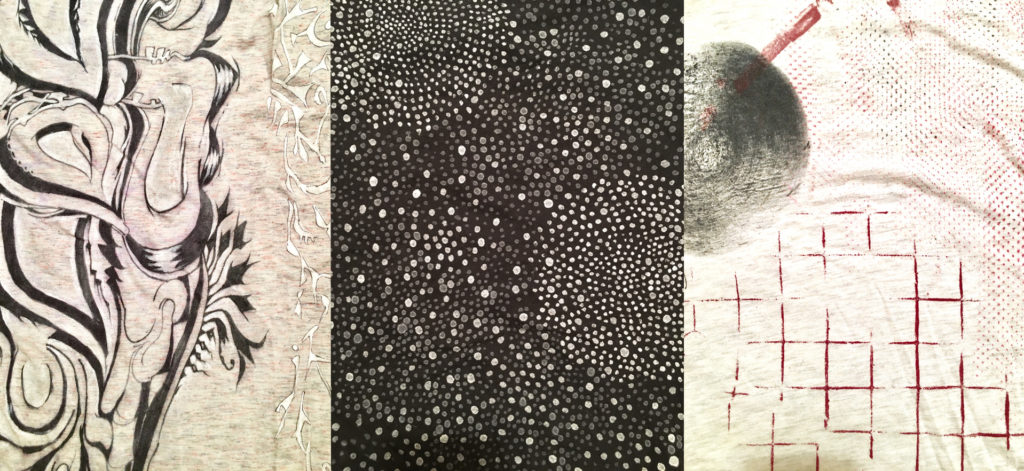
Atrium Display: Musicians Make Garments
Polymaths are often musicians and the talents and proclivities that make for great musicians quite often make for brilliant artists, engineers, mathematicians, activists, chefs, philosophers, poets, painters, cosmologists and gardeners. Society seeks to flatten these geniuses and so too often these gifts are considered tangential rather than being celebrated as the facets on a single, complex jewel.
In this series of exhibitions we will explore non-musical works of artistic and cultural value created by members of the community primarily known for their music.
In 2018, curator David Samas commissioned five musicians to make hand painted shirts he could wear to openings and receptions. Katarina Countiss, Bob Marsh, Bryan Day, Monte Thrasher, and Mauro Ffortissimo created these unique garments each using their own visual vocabulary.
Feel free to check out some of their music on YouTube. For sales contact gallery@CenterForNewMusic.com.
Katarina Countiss is a multimedia artist based in Oakland, CA. She creates ASMR videos and enjoys exploring color and texture through light, ink, fabric and paint.
Bob Marsh is a well seasoned improviser whose work has involved shaping sounds words images ideas. Since his arrival on the west coast, multi-instrumentalist and composer Marsh has been busy with several projects. He currently leads or directs String Theory, a string ensemble focusing on textures and microtonics; the Che Guevarra Memorial Marching (and Stationary) Accordion Band, structured and free improv for six to fifteen accordions; Robot Martians, electronics and processed voice; the Out of the Blue Chamber Ensemble, a mixture of reeds and strings; Opera Viva, voiced physical theater; the Quintessentials, a quintet specializing in interpreting graphic compositions based on alterations to the Michelin Road Guide to France; and the Illuminated Orchestra, structured improves for large ensemble. Bob Marsh tours frequently with his long term partner saxophonist Jack Wright.
Bryan Day is a improviser, instrument inventor, illustrator and installation artist based in Richmond, CA. His work involves combining elements of the natural and man-made world using field recordings, custom audio generation software and homemade instruments. Day?s work explores the parallels between the patterns and systems in nature to those in contemporary society. Day has toured throughout the US, Europe, Japan, Korea, Argentina and Mexico, performing both solo as Sistrum and Eloine and in the Shelf Life and Seeded Plain ensembles.
Monte Thrasher grew up among the prop shops, animators, sculptors and set painters of Burbank California. Craft awakens the senses and and leads to art. A contributor to now-legendary Experimental Musical Instrument magazine, Thrasher has worked in sound sculpture since the early 80s. A critic/aesthetician as well as instrument builder, He is seeking the breakthrough that will deliver this orphan art form to the mass audience it deserves. Thrasher studied sound sculpture under Bill and Mary Buchen at SFSU, designed for motion pictures, TV and film (Star Trek the Next Generation, Steve Martin’s LA Story, Starship Troopers). He has received two certificates of merit from the City of Los Angeles for work as a muralist, fell into toy and collectables design and wrote a patent for a marvelous new material that’s as fun and versatile as fluorescent color.
Mauro ffortisimo, Argentinean/Italian/American, grew up in Argentina, where interest in art and music lead him to study classical piano and visual arts. He emigrated to California in 1981 to further his artistic explorations, taking classes in print making, sculpture and painting at San Mateo College, Art Institute, and Berkeley Extension. Mauro is a founding member of “849 Folsom Music”, a 13 member music and spoken word performance troop that brought vital energy to the San Francisco “South Market” artist underground scene in the pre-dot com years of the late 80’s. As a founding member of the Enso Art Collective and the Miles Davis Memorial Hall, Mauro has been investigating sounds with the deconstruction of pianos, becoming more able to expand the 12-tone scale.
Après Baschet by Marti Ruiz
Thu, Jan 10 — Thu, Feb 28, 2019
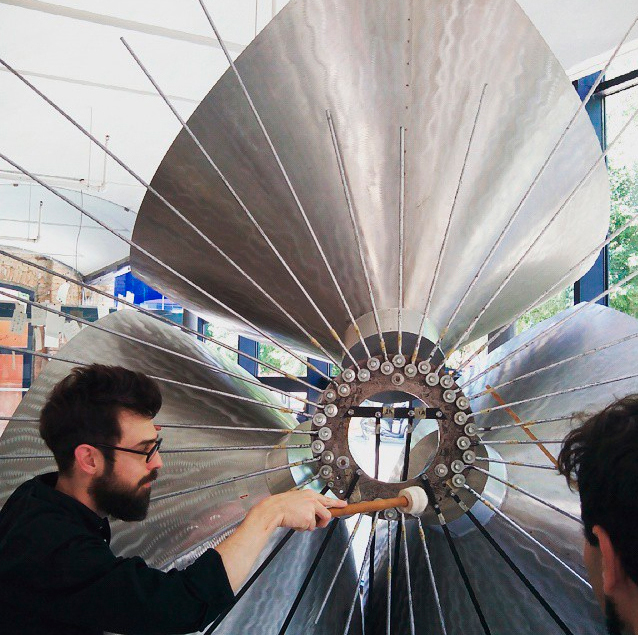
François and Bernard Baschet, working in France in the second half of the 20th century, are best known for their Cristal Baschet, an extraordinarily refined and successful musical instrument of water, glass and steel. The Cristal is but one member of the extensive and varied instrumentarium the Baschets created while simultaneously developing a cohesive system of applied acoustics. Taken together, the instruments and the acoustical system applied to sound sculpture represent a fertile corpus that allows engagement in sound exploration with no need for particular skill, as a way to engage in aesthetic exploration. In the Baschet view, sound is a powerful tool for a playful, tolerant society, in which diversity can be celebrated. François Baschet devoted himself to teaching and sharing his acoustic and engineering discoveries, offering building workshops to a variety of people, from the children at the NY School for the Deaf to young unemployed or Spanish “offenders.”
Taller Baschet continues this work under the guidance of Martí Ruiz. Since his close collaboration with François, Martí has been evolving the theory, discovering new configurations and new sound devices, and demonstrating that the Baschet principles can be applied to contemporary sounding ideas and capabilities. He calls this approach Après-Baschet — derived works honoring this lineage. www.tallerbaschet.cat
Martí Ruiz, born in 1982, is a sound and visual artist, musician, professor and researcher at the Barcelona University’s Fine Arts Faculty. He has a BFA in music language and modern guitar from Taller de Músics, where he earned a Master’s Degree in Art and Environment. After focusing on soundscape for some years, Martí transitioned to applied acoustics with a social approach. He wrote his PhD dissertation on applied acoustic systems in Baschet Sound Sculpture.
He is co-founder and coordinator of the Baschet Sound Sculpture Workshop at UB with François Baschet, and since 2010 has been devoted to the preservation and restoration of Baschet pieces. He has worked to encourage public interaction in museums, festivals and educational institutions in Paris, Moscow, Beijing, Munich, Czech Republic, Mexico DF, Los Angeles, Osaka, Kyoto, Tokyo and now San Francisco.
Among the many new Après-Baschet instruments and sound sculptures Martí has developed from the Baschet theory are his directional tuning forks called Kouri-No-sen, and the Clavinimbus, a full acoustic tuning-fork keyboard amplified with balloons featuring a volume-tremolo pedal. In 1995 he co-founded Hamsterloco, an independent experimental electronic netlabel, and the band Híbrida, Nen i Cavall –www.nenicavall.cat, releasing music under the name of Katatsumuri since 2001. Martí is also a member of Gamelan Penempaan Guntur (Forge of Thunders), and the Gong Kebyar ensemble at the Museum of Music of Barcelona.
Atrium Display: Hacked-Found-Repurposed
Thu, Jan 3 — Sun, Feb 3, 2019
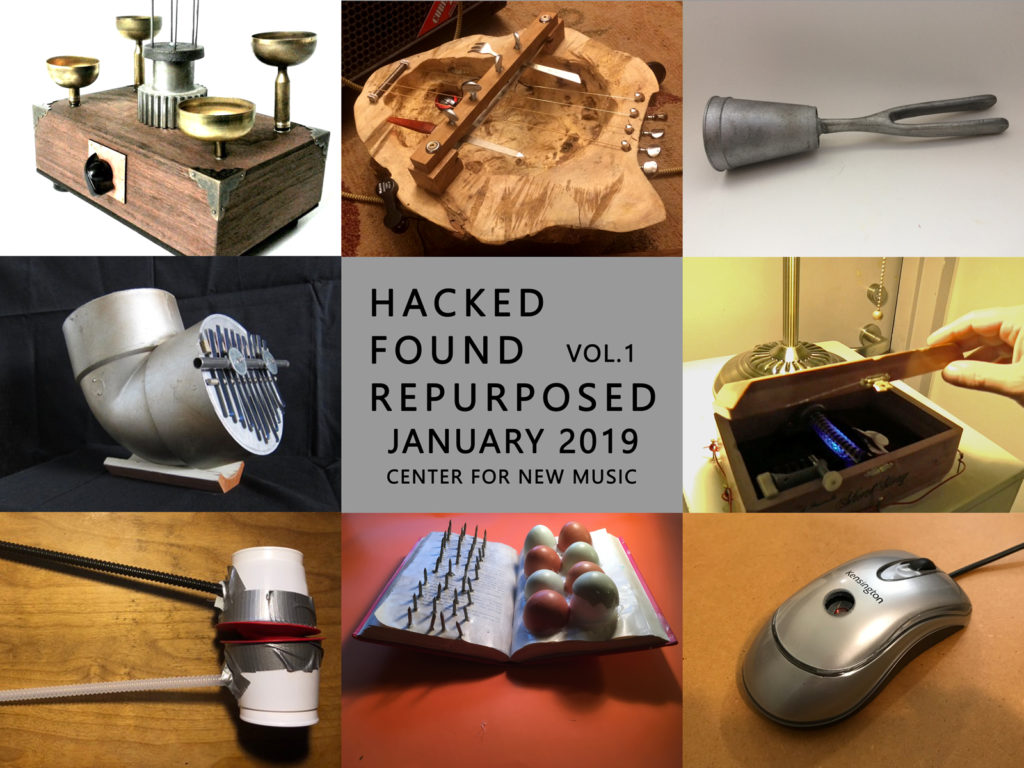
Atrium Display: Hacked-Found-Repurposed by Bryan Day
Electrogenesis: Ivor Darreg & the First Keyboard Synth Drawings from 1936-38
Fri, Dec 7, 2018 — Thu, Jan 3, 2019
Atrium Display: Electrogenesis, Ivor Darreg & the First Keyboard Synth Drawings from 1936-38
Ivor Darreg (1917-1994) Invented the keyboard synthesizer in 1936 as a 19 year old. It was the first instrument of its kind in the world.
An iconoclastic genius, composer, tuning theorist and instrument inventor, he created the “Electric Keyboard Oboe,” “Drum Synth,” “Orgatron,” and “Thyrotron” inspired by Leon Theramin. His synth systems were microtonal, exploring both just intonation and small equal temperaments like 19ET and 22ET.
On display are drawings for several electronic instruments from the late 30s, including the iconic “Electric Keyboard Oboe.” The 4 drawings on the far right are from a patent paper he wrote in 1937 with the first circuit designs for original musical instruments in english. Some of these circuits were realized in his early electronic instrument experiments, while others remain solely conceptual.
Drawings on loan from the Interval Foundation
Jonathan Glasier, Director
Kathleen Smith, Archivist
Don Buchla: Instruments for Electronic Expression
Thu, Nov 1 — Sun, Dec 30, 2018
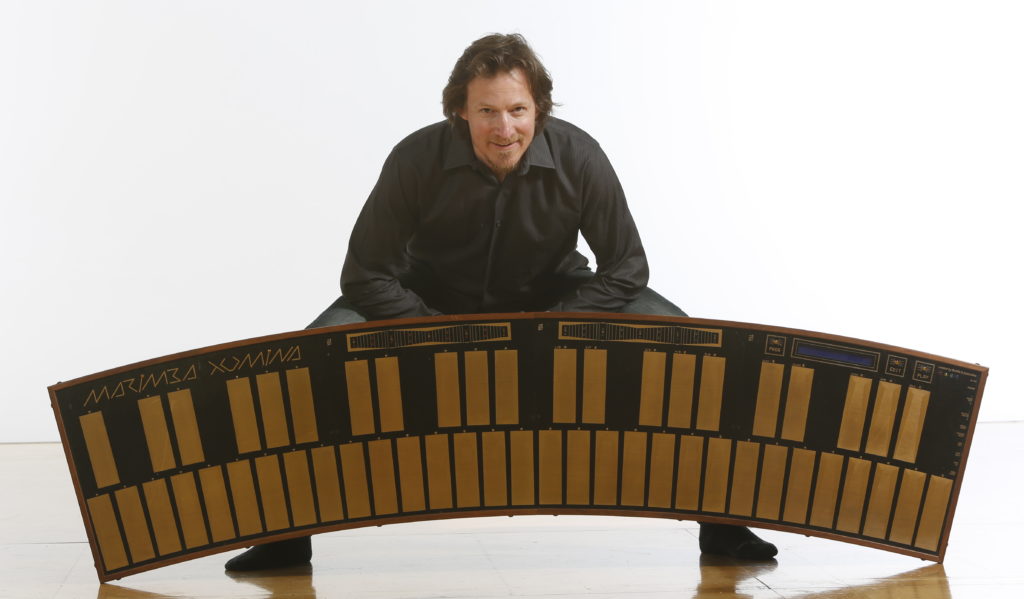
Don Buchla: Instruments for Electronic Expression
Curated by Joel Davel
“In my many years working for Don Buchla, I had the pleasure of witnessing his drive to create innovative musical controllers. While many Buchla fanatics hail his modular synthesis designs, Don interest in them was often more about how a creative interface might inspire new composition. I first met Don when he introduced Thunder at Mills College in 1990. I had already experienced composing on his modular system and in particular his set up for computer control of it — a system that he installed at Northing Illinois University. But now Don was moving towards making live (portable) controllers that were in sync with my own needs as a performer/composer. By 1995 I was able to get deep enough into helping those innovations along to become the circuit board designer and the alpha tester for all the new ideas. I hope that by presenting works of Don’s that focus on those years from 1989 to the end of this life, and being allowed to interact with them, gallery visitors might get a glimpse of the Don I knew much more than any recording or talk could. “ -Joel Davel
Don Buchla (1937-2016)
Educated in physics, physiology, and music, Don Buchla’s multi-faceted creativity was applied to fields as diverse as space biophysics research, musical instrument design, and multi-media composition. A UC-Berkeley alumnus, he spent the majority of his life as a resident of Berkeley, enjoying both the experimental and academic stimulation it offered. Much of his work was centered on the refinement of communication channels between man and machine, notably the invention of mobility aids for the visually handicapped, the development of instrumentation for bio-feedback and physiological telemetry, and the design of interactive electronic musical instruments and performance-oriented music languages.
With encouragement from Morton Subotnik in 1963, Don began to focus his efforts more on electronic musical instrument design. That led to many collaborations with musicians, composers, and researchers over the years in addition to performing with and co-founding such groups as the Electric Weasel Ensemble, and the Muse and the Fuse. From 1989 to 2004 — while other commercial sound resources flooded the market — Don focused on developing several exotic controllers that provide expressive alternatives to traditional musical input devices including Thunder, Lightning II, Wind, Rain, Marimba Lumina, and the Piano Bar. In his final years he revisited the 200 series—the”electric music box” series that made him a legend in the 1970’s—by creating the 200e series modular.
Joel Davel worked with Don Buchla for over 20 years in many roles–his primary task being the PCB designer for all of Buchla’s post-1995 designs including the Marimba Lumina, Lightning III, Moog Piano Bar, and all of the 200e series. Davel also performed alongside Don Buchla. Reviewing an event featuring Bob Moog and Don Buchla the Wall Street Journal wrote: “percussionist Joel Davel blew everyone away with his virtuosic improvisation on the Marimba Lumina, an electronic invention that emulates and extends the vocabulary of conventional mallet instruments, and the [Buchla] Lightning, played by waving wireless wands in space.”
Davel’s closest musical partnership is with Paul Dresher as part of the Dresher/Davel Invented Instrument Duo, Electro-Acoustic Band, and Double Duo quartet—an international touring group. Davel has recording credits on marimba and electronics with groups led by electronic-diva Amy X Neuburg, violinist Kaila Flexer, and guitarist Jack West among others. He is Inspired by movement and storytelling and has enjoyed work with The California Shakespeare Theater, West Edge Opera, South Coast Repertory and composing and performing live for over six dNaga dance productions.
Now with Buchla USA, Joel works in his role as lead engineer to keep Don’s creative vision and designs alive.
Davel holds Bachelor of Music from Northern Illinois University and MFA from Mills College.
Brian Lucas: Gaze Emanations
Mon, Oct 1 — Thu, Nov 1, 2018
Atrium Display: Brian Lucas, Gaze Emanations
Artist Statement
My paintings and drawings speculate on the visual similarities between micro- and macrocosmic worlds and the liminal spaces between their supposedly opposite extremes. The biomorphic growths, nodes, and nebulae on display reflect my interest in organic processes: they are at once cosmic and microbial, quantum and expansive. I have evolved ed this personal visual grammar consistently over the last twenty years.
Artist Bio
Brian Lucas’s exhibitions include: Defasaje Polícrono (Airesis, Guadalajara); Dark Star: Abstraction and Cosmos (Planthouse, New York); Divine Invasions (Krowswork Gallery, Oakland); Terra Incognita (Art@Archer, Oakland), and Naked Metaphysics (The Emerald Tablet, San Francisco). His book, Eclipse Babel, was co-published by Ensemble Editions and Bootstrap Press in 2015. He plays in the bands Dire Wolves and Angel Archer.
Inventions from The Maze and The Machine
Sat, Sep 15 — Mon, Oct 29, 2018
Inventions from The Maze and The Machine:
Instruments by Daniel Schmidt for the Paul Dresher Ensemble
Featuring inventions by Daniel Schmidt in collaboration with Paul Dresher
Paul Dresher and Daniel Schmidt have collaborated on invented instruments since the mid-1970s. Their initial inventions were for American Gamelan and were often in dialogue with composer Lou Harrison and his partner Bill Colvig. Their current inventions fall into two general categories. The first includes visually beautiful and easily played instruments/sound sculptures suitable for general audiences, including children. These instruments generally have one – or at most a few – means of producing sound. The inventions on display here are of this type.
The inventions in the second group are complex, electro-acoustic instruments that require substantial practice and in experienced hands can express a vast range of musical textures and emotional content. Although general audiences have experimented with them, these instruments are designed for professional performances of concert and theatrical music by Paul Dresher and his collaborators, particularly with percussionist Steven Schick and Dresher’s long-time collaborator, Joel Davel, in the Dresher-Davel Invented Instrument Duo. This group can be heard in concert on June 7 & 8, 2019 at ODC Theater in San Francisco.
Arist Bios
Paul Dresher is a multi-talented composer who is uniquely able to weave contemporary classical, pop, minimalist, and South and Southeast Asian musical styles together into his own distinctive personal style. He creates in a myriad of different genres, including experimental theater, contemporary opera, acoustic and electronic chamber music, orchestral compositions, dance scores, and musical instrument invention.
His solo percussion work Schick Machine (2009), was created for percussionist Steven Schick and performed on a set huge invented musical instruments and sound sculptures and his latest creation is Sound Maze (2015), a hands-on sound installation of twelve large-scale invented musical instruments and sound sculptures that is touring widely in the United States and internationally to both performing arts and interactive museum institutions. Extensive information about Dresher’s work can be found at www.dresherensemble.org and examples of works with invented instruments can be found by searching for Paul Dresher or Dresher Ensemble at YouTube.
Daniel Schmidt is a musical instrument inventor, composer and music educator. His inventions have been exhibited at the Exploratorium in San Francisco, Akademie der Kunst in Berlin, the San Francisco Art Institute, New Langton Arts, EXPO ‘86 in Vancouver, Dartington College in England, and the Cornish Institute in Seattle. In addition he has built musical instruments for
John Cage with the Boston Symphony, John Adams and the San Francisco Symphony, and worked closely with composer and inventor Lou Harrison on a number of projects. Daniel is well known for his contribution to creating the genre known as American Gamelan, broadening the range and timbral palette of traditional Indonesian designs and making the instruments more well-suited to the western compositional approach. He has long been a leader in field of American Gamelan & Javanese music, and in that capacity has directed performances or had residencies at the Cabrillo Music Festival, the Oakland Museum, the Exploratorium, New Music America in San Francisco and Los Angeles, UC Berkeley, California Institute of the Arts, and the Berliner Kunstler Program (DAAD).
His work with Paul Dresher has brought about two significant new instruments, the Quadrachord and the Hurdy Grande. They have also developed instruments for specific use in two large theatrical productions – Sound Stage (2001) and Schick Machine (2009) as well as for The Sound Maze (2015-18), a hands-on interactive installation work that has regularly toured the United States since its premiere in 2015.
Liftoff, A Series of Songbirds by Nicholas Kanozik
Thu, Sep 6 — Mon, Oct 1, 2018
Atrium Display: Liftoff, A Series of Songbirds by Nicholas Kanozik
“It’s probable that in the artistic hierarchy, birds are the greatest musicians existing on our planet … Birds have extraordinary virtuosity no tenor or coloratura soprano could ever equal, for they possess a peculiar vocal organ, a “syrinx,” which allows them to perform rolls and very small intervals, and to sing extremely fast.
Composers on Music― Olivier Messiaen
Artist Statement
Liftoff presents birds in an environment of new music graphic scores. Within these works you will find quarter tone demarcations, spatially oriented content, irregular use of standard notations and lots of color. The work plays with abstraction in attempts to visually project the extraordinary singing abilities of birds; as the visual content becomes representational – from music scores to bird forms – musically, each work becomes more abstract – from traditionally notated melodies to spiraling assortments of symbols. Throughout, hue, value, contour, shape, texture and form all connect with musical elements. Look closely to witness a transmuting narrative depicting articulations into songbirds.
Artist Bio
Nick Kanozik is an educator, clarinetist, pianist, visual artist, conductor, and composer who Chairs the Instrumental Music Department at Oakland School for the Arts (OSA), a 6th – 12th grade arts charter school located within the historic Fox Theater building in downtown Oakland. He conducts the OSA Chamber Orchestra and teaches composition, chamber music, and music history.
Nick Kanozik graduated with a Bachelors and Masters of Music Composition at the University of North Texas and Mills College respectively. Among many exceptional teachers, he studied composition with Pauline Oliveros and Fred Frith, improvisation with Roscoe Mitchell founder of The Art Ensemble of Chicago, computer music and intermedia with Laetitia Sonami and David Bithell, orchestration with Guggenheim and Fulbright Scholar Dr. Cindy McTee, and book art with Julie Chen, president of the College Book Art Association.
He has been fortunate to perform in a variety of ensembles from symphony orchestras, classical and new music chamber groups, jazz combos, Indonesian gamelans, to electronic and dance collaborations. Notably, he’s conducted Gustavo Dudamel’s Youth Orchestra of Los Angeles, collaborated with Mason Bates for works premiered on Nick’s re-invented light organ, he worked directly with Pauline Oliveros for the premier of Tower Ring at Ann Hamilton’s double helical staircase, and come Sept 2018, he will make his conducting debut at Zellerbach Hall leading 190 musicians.
Kanozik’s compositions have been performed by the Eclipse String Quartet, the University of North Texas Chamber Orchestra, the OSA Chamber Orchestra, the Mills Contemporary Performance Ensemble, Gamelan X, and Roscoe Mitchell’s Improvisation Workshop.
Visual Harmony: The Interval Rotors of Siemen Terpstra & Interval Diagrams by Yuri Landman
Thu, Aug 9 — Fri, Sep 7, 2018
Atrium Display, Visual Harmony: The Interval Rotors of Siemen Terpstra & Interval Diagrams by Yuri Landman
The Interval Rotors of Siemen Terpstra
These rotors are tools used to simplify harmonic analysis of musical scores in unusual temperaments. They allow one to quickly calculate any pattern (type of harmony, set of intervals) to any pitch or function. Siemen Terpstra made examples for the tuning systems that he uses most (i.e. 12-et, 31-et, 53-et) but the approach can be adapted to any system. Even though the intent is strictly practical, he designs them to be pleasing to look at, to embody aesthetic values, while the connective geometry indicates thirds, fourths or fifths from any given tonic in a given pitch set.
Siemen Terpstra was born in 1948 in the Netherlands. As a baby he immigrated to Canada and grew up in Ontario. In 1970 after attending university he moved to the west coast. Having dual citizenship he returned to the Netherlands in 1993. He now lives in Amsterdam.
Terpstra came from an artistic family; his father painted seascapes and his mother sang and directed choirs. As a teenager artistic interests dominated but when he grew older musical matters came to the fore. He developed a keen interest in musical intonation during the 1960’s but his active research in the field covers the 1970’s to the 90’s. Having a high aptitude in mathematics, he explores many avenues and developed his own models to clarify issues. As a teenager he wanted to be an architect, but then as an adult the architecture of resonance systems proved more fascinating. Subjects that came in for special attention include: monochord arithmetic, alternative just intonations, multiple divisions, irregular temperaments and new instrumental resources. Having a long-time interest in musical conceptions of order, he thoroughly explored the interplay between music and ancient philosophy, cultural history and possible futures.
Interval Diagrams by Yuri Landman
As a former graphic designer, Yuri wanted to make a visual diagram to clarify intervals, like the periodic table clarifies chemistry. He developed a color code for the harmonic series where the denominator is the dominant factor of the sound composition (re: string lengths; in frequencies: it’s the numerator). The color legend on diagrams explains number-color relation. In his words:
The Third Bridge
Adding a third bridge in the middle of the strings of a harp creates a multiphonic timbre consisting of the vibration of the left string part, the right string part and their shared harmonic. To illustrate this I came up with a symbol consisting of a circle (the denominator of the fraction), and three squares rotated 45°. The left square mentions the key of the left string part, the right square the right string part and the upper square is the shared harmonic (1/denominator). The cluster of the three mentioned keys all together are the composition of the multiphonic.
Utonality & Otonality
From White Consonance to Dark Dissonance, both diagrams feature more subtile colors; both start with white for the fundamental. Then the octave is again white and the 3rd overtone or undertone has a soft color. The fourth overtone or undertone is again an octave and white. I continue that process with darker colors for each newly appearing overtone or undertone in an octave interval. This is a binary coloring method used in cellular automata. Notice that the two systems are symmetrical though inverted; the remainder of one indicates the other and this is also evident in the tonality diamonds.
Yuri Landman (1973) is a musician and an inventor of musical instruments. Based on prepared guitar techniques, he built his first instrument in 2001 to solve the inaccuracy of instant preparations. He has build experimental for acts such as Sonic Youth, dEUS, Melt-Banana, Rhys Chatham, Ex-Easter Island Head, Half Japanese, Kaki King.
In the past seven years he has given over 100 DIY-instrument building workshops in Europe and the US at music festivals, music academies, art academies, concert venues and art spaces. In 2012 Yuri Landman and Bart Hopkin published Nice Noise, a book about string preparations and extended techniques for guitar. In the same year he started his band Bismuth with Arnold van de Velde followed by an album in 2014 Bismuth.
Institutes such as MIM (Phoenix), Muziekgebouw aan ’t IJ, WORM, Extrapool, Sonoscopia own collections of his instruments. Articles about his work have appeared in Pitchfork, The Guardian, CNN, Libération, El País, Frankfurter Algemeine, and many others.
Margaret Noble: Resonating Objects
Thu, Jul 12 — Sun, Sep 2, 2018
Margaret Noble: Resonating Objects
Opening Reception: Thursday July 12, 6pm
Artist Statement
I create interactive, multi-sensory sculptures and installations layered in sound and gesture. I design these works with recycled objects, raw materials, and circuitry. I use tactile controls to integrate light, electro-acoustic sounds, and field recordings into my projects. This practice enables users to animate objects and to be animated by my sculptures and installations. The materials I integrate have their own unique narratives but they accrue new meanings when combined. Through this hybrid medium, my work explores human and material relationships modulated by technology. I want each experience I create to become personal for the user. Instead of viewing the works, I would like audiences to inhabit the works.
A note on my content; I fear and love technology through a complex relationship I have with it in living, teaching, and making art. Furthermore, my experience of growing up on welfare often boils over in my work as I frequently explore social hierarchies and escapism. I engage with all of these ideas by looking at public and private histories. For example, in my sculpture “I Long to be Free from Longing”, I present a collection of intimate sounds embedded in an empty case with the invitation to covet things that aren’t there. In my music box sculptures: “What Was, What Is, What Is Not Yet ” and “A Score for Conversation” I use various sound patterns controlled by interactive paper loops to explore the impact of trauma and misguided communications. In my pieces: “What Lies Beneath” and “Head in the Sand” I offer audiences a chance to explore social anxiety through light, sound, and containment. For all works, I am interested in creating personal moments in public places. For me, this is theatrical work. The experiences of these works are constantly evolving due to the particularity of various venues and the nature of an audience’s participation.
About the Artist
Born in Texas and raised in California, Margaret Noble’s experimental artworks have been exhibited nationally and internationally. Her interdisciplinary work resides at the intersection of sound, sculpture, and performance. She holds a BA in Philosophy from the University of California, San Diego and an MFA in Sound Art from the School of the Art Institute of Chicago.
Noble’s work is influenced by the beat-driven dance culture of southern California which flourished during the 1980’s and later led her to perform as an electronic music DJ in the underground club community of Chicago. In 2004, she branched out from the dance floor into experimental sound art for new audiences which intersected the electronic sound scene and the visual arts community. During this transition, Margaret created sound works for collaborative projects in video, dance and object theatre. Her artistic works have now evolved into sculpture and installation influenced by interests in memory, history, narrative, and identity. Noble’s work has been featured on KPBS, PRI, Art Ltd Magazine, Art Forum, San Francisco Weekly and the Washington Post. She was awarded the International Governor’s Grant, the Hayward Prize and the Creative Catalyst Fellowship. Her artistic residencies include the MAK Museum in Vienna and the Salzburg Academy of Fine Art. She has had several solo exhibitions including the Museum of Contemporary Art San Diego, Ohrenhoch der Geräuschladen Sound Gallery in Berlin, and Mute Gallery in Portugal.
Hammer, Ink & Key: Scores and Sculptures by Mauro ffortissimo
Thu, Jun 7 — Tue, Jul 31, 2018
Atrium Display: Hammer, Ink & Key: Scores and Sculptures by Mauro ffortissimo
Opening Reception and Concert July 22, 5pm
Mauro’s work is complex and varied, ranging from hand painted scores which express the immediacy and humanness of intention while relying prominently on chance operation; to prepared, burning, planted and “liberated” pianos; to Flower Piano, a massive social event with a 12 ring piano music-circus installed annually at the San Francisco Botanical Gardens.
The Scores feature carefully painted staff lines juxtaposed by a chaotic splatter of notes whose liquidity is reflected in the watery sounds of the “Liberated Piano”. The use of player piano rolls as the foundation of a visual score creates a kind of conceptual synesthesia for the viewer. His scores blend serious musical practice and contemporary painting, displaying both education and humor.
Mauro’s “Liberated Piano” is an instrument whose keys and hammers have been removed presenting the performer with unimpeded access to the strings with mallets, filament bows and stroked, rosined rods. Ffortissimo gives a second life to these complex and beautiful musical instruments that are otherwise destined to the dump and creates assemblage sculptures using the piano’s parts: wood, strings, hammers & screws.
Flower Piano happens each summer (7/5-7/16/2018) at the SF Botanical Gardens and is sponsored by Sunset Piano, Mauro’s collaboration with Dean Mermell. Over a dozen grand pianos are installed at the spectacular 55 acre garden for everyone to play, with performances by brilliant local musicians scheduled on weekends and is free to SF residents with ID. NightGarden Piano (7/12, 13, & 14), is a mystical evening with music of every genre, food and drinks, and all beautifully light.
About the Artist
Mauro ffortisimo (b. 1962-), Argentinean/Italian/American, Grew up in Argentina, where interest in art and music lead him to study classical piano and visual arts. He emigrated to California in 1981 to further his artistic explorations, taking classes in print making, sculpture and painting at San Mateo College, Art Institute, and Berkeley Extension. Mauro is a founding member of “849 Folsom Music”, a 13 member music and spoken word performance troop that brought vital energy to the San Francisco “South Market” artist underground scene in the pre-dot com years of the late 80’s.
As a founding member of the Enso Art Collective and the Miles Davis Memorial Hall, Mauro has been investigating sounds with the deconstruction of pianos, becoming more able to expand the 12-tone scale. He does not subscribe to the romantic notion of a solitary artist, a suffering individual, hidden in a state of despair, creating work that only few can appreciate; instead Mauro travels the world, looking to the mundane, the sacred and the original with the same eyes, and listening to the music of diverse cultures, bringing it all home to work with it’s particular way of assimilation making art and music available to the community. When not traveling, Mauro lives in Half Moon Bay, California, where, with wife/artist Carrie Hollister and nine cats, runs the Enso Yoga Studio and Art Center.
Space is the Plate
Mon, May 7 — Fri, Jun 29, 2018
Space is the Plate: Shifting Resonances in Contemporary Instrument Design
Works by: Tom Nunn, Richard Waters, Neil Feather, Fred “Spaceman” Long, Brooks Hubbert III, Bart Hopkin, & Brothers’ Quarrel (Saxton/Samas) after Harry Bertoia
Many musical instruments employ soundboards – that is, thin boards, plates, sheets or diaphragms designed to provide a surface for radiating vibrations into the surrounding air. Inevitably these sound-radiating surfaces have their own internal resonances that color the sound even as they project it. If the radiator is made of sheet metal, and the metal sheet flexes, this causes variations in its predominant resonances, which in turn causes ongoing fluctuations in the tone quality. A similar fluctuation in resonance can be created by water moving on the surface of the metal. For further variability and complexity, the resonances of the sheet metal may simultaneously feed back into the initial vibration source to alter its behavior. Depending on the instrument, the effect may be subtly enchanting, or roaringly energetic. Several contemporary instrument makers have made use of these shifting resonance effects, and this exhibit highlights some of their instruments.
About the Artists
Richard Waters: The Waterphone evolved in 1968 from a humble can with tines to the bolted prototype seen here, and into the contrabass Waterphone on display. In these instruments, the initial vibration from a metal rod or tongue feeds into a metal vessel, where it is modulated by moving water on the surface of the flat bottom. After Waters’ death in 2013 his work was carried on by Brooks Hubbert III, who has continued the evolution of the instrument, creating the Cymapan through independent studies in a therapeutic context for people with autism and PTSD. The water allows the sound waves to be observed in cymatic displays.
Tom Nunn: Through the 70’s Nunn and Waters explored the sonic universe by brazing bronze rods to sheet metal creating unusual inharmonic percussion instruments. The Crustacean (1977) represents the pinnacle of Nunn’s explorations from that period while City Park was created in 2016. Nunn is an inventor, performer and author of Wisdom of the Impulse, a treatise on free improvisation. He continues to innovate from his SF garage studio where he hosts local avant performers for a series at “the Nunnery”.
Neil Feather: The Nondo is a string instrument which uses a flexible sheet of mild steel as both as a resonator and as a bow to keep tension on the strings which varies with flex. An iron bar acts as a floating slide and a variety of techniques are then used to activate the stings. Inventor and musician, Neil Feather has been a key player in Baltimore’s vibrant music and art community and a founding member of the Red Room Collective and the High Zero Foundation.
Fred “Spaceman” Long: Oakland-based “26th century troubadour” Fred Long has created a family of instruments “for the future” using a mix of rigid and flexible metal components including springs and sheet metal. In addition to modulating the tone acoustically, flexing may allow further modulation by altering the positions of pickups relative to the sounding bodies.
Bart Hopkin: Aquaalt and Wobble Steel Guitar are stringed instruments which use the sheet steel as both a resonator and a filter, one through the rocking of water and the other through flexing the plate.Instrument inventing guru and publisher of the infamous Experimental Musical Instruments journal, Hopkin continues to invent from his Marin workshop, performing locally with Pet the Tiger Inventors Collective.
Brothers’ Quarrel after Harry Bertoia: though totally unlike his Sonambiants, Bertoia’s cast bronze split gongs hang from above, are smooth, round, and explore the hybrid of gongs, tuning forks and split plate gongs called the “Umpan” or Cloud Plate which dates back 2600 years. Here we also see an evolution of these traditions by David Samas which, in keeping wight he theme of using new technologies as they develop, was water jet cut on a computer-controlled system, then painted with patina by hand.
Special thanks to Tom Nunn for the loan of the Waterphones, and to Sally Davis for the loan of the can with tines; to Neil Feather for the Nondo Plans, and to Ian Saxton who cut the split gong and fabricated the Nondo.
Tonal Access: the Ratio Keyboard Designs of Harry Partch
Fri, Apr 6 — Fri, Jun 1, 2018
Atrium Display: Tonal Access, the Evolution of the Keyboard
Part I: The Ratio Keyboard Designs of Harry Partch
Harry Partch (1901-1974) was an American composer, music theorist, and instrument inventor. He composed in just intonation, and was one of the first 20th-century composers in the West to work systematically with microtonal scales. His instruments were created in these tunings for performance of his compositions.
These two diagrams, “Ratio Keyboard Design” 2 & 3, show a 40 note to the octave, color coded, just intonation tuning system array for an eight octave organ designed in 1932. Partch, who was often homeless, lived for a time with the Glasier family and would mail himself drawings to copyright them, leaving them behind, unopened. Jonathan Glasier, publisher and archivist at Interval first published these in the winter of 1986 in Interval volume V, #3 after receiving them from Bertha Knisley, one of Partch’s patrons, after her death, in a sealed envelope dated 8/10/33.
Special thanks to Jonathan Glasier of Interval Journal, from whom these drawings are on loan; to Ian Saxton for realizing the keyboard as a multi touch app in 2015; and to the Internet Archives, for digitizing and hosting these and other vital documents in new music history in partnership with Interval.
The Universal Music of Dr. UM: Works by Darrell DeVore
Fri, Mar 9 — Mon, Apr 30, 2018
About the Artist
Darrell DeVore (1939-2005), also known as Dr. UM, was a musician, instrument maker, graphic artist, wordsmith, philosophizer, and an inspiring and uplifting presence for all who came in contact with him.
Darrell grew up in St. Joseph, Missouri. He taught himself jazz piano and as a young man made a place for himself in the Kansas City jazz scene. In 1967 he moved to California. He found the jazz scene here a bit less fertile; dipped a toe but not much more in San Francisco’s psychedelic rock scene (including a stint with The Charlatans); and then gradually set about creating a musical world for himself that was more uniquely his own. The music became freer, more exploratory, and more rooted in a peculiarly DeVorean philosophical and spiritual perspective. He became, for a time, a fluteman (his word) – making, playing and selling bamboo flutes on streets, in parks, and wherever else the passing people might enjoy them. In addition, he began turning out a range of other musical sound makers. None of them were high-tech; many were made of gourd or bamboo, but he also made good use of scrap metal and Styrofoam. All of them reflected an abiding interest not only in the notes of music, but in sound itself. He connected with an evolving array of like-minded allies (again, his word) in free-music assemblages including Pygmy Unit, Moire Pulse, Lingua Quartet, and others. He also continued with his own idiosyncratic and visionary jazz practice, focused on piano. And it wasn’t music alone that engaged him: Darrell’s inner and outer perspectives manifested themselves in page upon page of prose in a rather beautiful handwriting that was somehow both unfussy and elegant, and in a very personal graphic style which looks sometimes like biological forms, sometimes like coded messages from another world.
All this seemed to come from a philosophical outlook that flowed through and informed everything he did. This perspective was expansive and free; not easily described. It had an animist quality in recognizing the spirits within things and places. It had a deep feeling for a human nature that abides outside the influence of civilizing forces. It reflected a great faith in the power of sound and, most importantly, of listening, to point to essential truths and ways of being in the world.
Eventually Darrell settled in Petaluma, where for many years he practiced Sound Magic with children in the Petaluma School District. His later years were spent mostly in Studio UM*, the rambling chicken shack in the midst of an unmown field on the outskirts where he built and played. Within it and around it there appeared an evolving array of bamboo structures and accumulated sound objects. Music people from the Bay Area and beyond made the pilgrimage to join in music sessions and take in the world that had been created there. People wanted to be part of it because Darrell had a profound impact on those around him. Different people no doubt were drawn to different facets of it, but central for most, I think, was this: Darrell had a deeply transformational way of dismissing the unimportant stuff, and opening the space for what is essential about music, about listening, and about being alive.
In this exhibit we have gathered a sampling of DeVore instruments, graphics and writings. Our thanks for instrument loans and generous assistance go to Oma DeVore, Trane DeVore, Cain DeVore and Cecily Axt; George Brooks, Will Combs, Sally Davis, Kim Epifano, Karen Ezekiel, Rasa Gustaitis, Emily Klion, Gary Knowlton, Mike Knowlton, Kevin Lambert, Tom Nunn, Steve Shain, Sara Winge, and Jim Zeno.
~~~~~~~~
*In the DeVore lexicon, UM stood for Universal Music.
Ken Butler: Hybrid Visions
Thu, Feb 1 — Sat, Mar 31, 2018
Atrium Display: Ken Butler, Hybrid Visions
Artist Statement
Contemporary urban life is a bewildering collage of multiple images, ideas, sounds, and objects in a constant state of flux as information overload becomes the touchstone of our age. As we move from the mechanical to the electronic, this churning mass chews up and spits out material with re-assigned priorities and updates. The resulting detritus is a living corpse – a random and chaotic body of juxtaposed and deconstructed items and associations. From this storehouse of forsaken objects and hardware I, the urban bricoleur, further dismantle and reassemble the consumer society into assemblages in the form of musical instrument/objects, then coax them to sing for their supper.
Biography
His works have been reviewed in The New York Times, The Village Voice, Artforum, Smithsonian, and Sculpture Magazine and have been featured on PBS, CNN, MTV, and NBC, including a live appearance on The Tonight Show. Awards include fellowships from the Oregon Arts Commission, the New York Foundation for the Arts, the National Endowment for the Arts, and the Pollack/Krasner Foundation. He won first prize in the 2016 international Guthman Musical Instrument Competition at Georgia Tech University.
Butler has performed with John Zorn, Laurie Anderson, David Van Tieghem, Butch Morris, The Soldier String Quartet, Matt Darriau’s Paradox Trio, The Tonight Show Band, and The Master Gnawa musicians of Morocco. His CD, Voices of Anxious Objects is on Tzadik records. Works by Ken Butler are represented in public and private collections in Portland, Seattle, Vail, Los Angeles, Toronto, Montreal, Washington, Paris, Tel Aviv, and New York City including the permanent collection of The Metropolitan Museum of Art. He resides in Brooklyn, New York.
Created primarily from consumer detritus with a patina of use, the hybrid instruments express a poetic spirit of re-invention and hyper-utility as new associations momentarily create a striking and re-animated cultural identity for forsaken objects. String instruments become body, tool, weapon, toy, machine, phallus, creature, fetish, sculpture, icon, symbol, and voice. Pianos become cybernetic and symbolic architecture. Anxious objects speak in tongues.
Collages
Collages and other flatworks, made principally from altered photos of the artist’s hybrid musical instrument sculptures, further re-configure and amplify the head-neck-body ergo-iconography of string instruments, pushing it into the realm of abstraction and color-field painting. The hands-on physicality of these works echoes the improvisational sensibilities of making live music and creates a reliquary of silent sound shapes that reflect this transition from found object to body to instrument to abstract icon and architecture. Proportion, balance, harmony, texture, scale, tension, release, dynamics, and resonance aptly apply to numerous art forms.
Drawings
In addition to the collages and assemlages, a series of complex and detailed pencil drawings from 2004-05 illustrate envisioned and often elaborate audio-visual sculptures and installations that further extend the formal dialogue of art forms and the transformative deconstruction of musical instruments into surreal realms of high and low technology and invention. Bicycles, pianos, projectors, musical chairs, exotic racing cars, and dinosaurs are subjected to transformation and re-construction.
Banjofrogs and Humanitars: Instruments and Art by Fred Carlson
Mon, Jan 1 — Wed, Feb 28, 2018
About the Artist
Innovative California luthier Fred Carlson got his start in rural Vermont, where as a teenager in the early 1970s he worked with artist Ken Riportella, a maker of musical sculptures. In 1975 Fred studied guitar-building with acclaimed lutherie teacher Charles Fox. Throughout the ‘70s and ‘80s Fred built and repaired stringed instruments professionally in a collective craft and woodworking studio that was run by members of the communal farm where he lived for some 20 years. In 1984, Fred’s violin-building partner, Suzy Norris, inspired him with her use of sympathetic strings to develop the Sympitar, a guitar with internal resonating strings. In 1985 Fred showed a prototype of the Sympitar to guitarist/composer Alex de Grassi, who still performs and records with one of the early Sympitars that his feedback helped evolve. Moving to California in 1989, Fred has continued to expand the aesthetic and functional boundaries of the guitar with instruments like the Harp-Sympitar, the Barikoto and the Banjalarpe, original designs that are acoustically and aesthetically adventurous while maintaining the important functional qualities of fine musical instruments, and honoring the traditions of the craft.
Artist Statement
As a teenager some 45 years ago, I got involved in making musical instruments because I wanted to make myself a banjo. I was living in commune in rural Vermont, filled with woodworkers and musicians. A woman there played old-time 5-string banjo, and I desperately wanted to learn how to do that. We built all our own houses there, and there were some very skilled cabinet makers that I got to rub shoulders with. It occurred to me that I could probably build a banjo if I had some help. I was attending a very small, alternative high school program at the time, and I asked the director if he could find someone to help me build a banjo. That led me to working for several years with a wonderful artist/sculptor, Ken Riportella, who was making Appalachian dulcimers in wild, sculpted shapes. I did eventually make myself a little wooden banjo that I traveled everywhere with, learning to play old mountain tunes and songs. I sewed a case for it out of an old raincoat I got from the Catholic Daughters Rummage Sale, an annual event in Montpelier, Vermont, that was run by octagenarian identical twin ladies who wore matching plaid outfits. That was about as good as a rummage sale gets, and those were happy, innocent days in my life.
I got distracted, then, by guitar making, and by becoming a “professional” luthier, something I studied and practised seriously for many years. But, my natural tendancy has always been toward creativity; I gravitated towards unusual shapes and gradually my work got more assymetrical, farther away from traditional guitar making. I always wanted to use color, and to have the wood be more plastic than it is, to be able to get shapes that don’t come easy with a chisel.
In a parallel thread of my life, I was doing a lot of theater performance, and got interested in mask-making, strongly influenced by the work of Peter Schumann, of Vermont’s Bread and Puppet Theater. At some point, I began to get the urge to combine the mask-making with the instrument building; it seemed that a large mask might make a really great resonating shell (back) for a stringed instrument.
Over the years, as I got more involved in making more and more complicated variations on multi-string harp guitar things for clients, I made an occasional foray into the mask-as-a-back idea. It was fun, and I began to develop a paper-and-glue laminate material that had the right consistency to make a reasonable resonator.
It has been only in the last couple of years that I’ve gotten back into banjo building, and have discovered that this papier-mache material is well suited for making a banjo shell/back. The original ancestors of our modern banjo came from Africa, and were basically gourds with skin stretched over them. I tried growing gourds…the climate where I now live in coastal California isn’t right. But I realized I could make my own gourd substitute using my papier-mache material, and have control over shape, color and so on.
So, I’ve been reinventing the ancient, African gourd banjo using recycled Safeway paper grocery bags and Titebond glue. One thing that draws me to the banjo is an amazing fact of its existence: it came to us through so much suffering, a people forced into slavery and servitude for centuries, and somehow the instrument is universally associated with joy. My most recent work has been in trying to manifest that joy into the sculpture of the instrument.
Robby Gilson: Shimmer
Fri, Jan 5 — Mon, Feb 5, 2018
atrium display: Shimmer
Shimmer is a work of visual art created for a work of music.
Shimmer is a collaboration between architect/visual artist Robby Gilson and composer D. Riley Nicholson. Each drawing is a distillation of the projected artwork that accompanies the five self-contained movements of the piano and electronics composition Shimmer. Characterized by large and small rectangular blocks the negative space reminds the listener to be attentive to the space between notes. The variance in texture and density of the graphite create intimacy inviting the viewer to take a closer look. In contrast, the gradient of dark to light mimics the swell of energy found in the more complex moments of Shimmer. Through the projection of fundamental geometric forms, stripped of symbols and signs, each movement asks the spectator to remove themselves from the context of daily life and experience pure sound and light. The full piano, electronics, and visual projections production of Shimmer will premiere at the Center for New Music on January 28th, 2018.
Artist Bio:
Robby Gilson is an architect and visual artist. He uses fields, points, lines, and volumes to express the hidden flows and movement of bodies, light, and other natural forces in space. Concerned with boundaries imposed upon our experience of the world, a consistent feature of Robert’s work is the crop. Robby’s collaboration with Post:Ballet on Field the Present Shifts gave him the opportunity to study movement and apply those lessons to the practice of his visual art and architecture. His work was nominated for an Isabel Duncan Award, Outstanding Achievement in Visual Design. Other work includes an Indonesian skyscraper that blends socioeconomic groups (Kampunkota), an energy efficient “tiny house” (Chip), and an illustrated dystopian vision of the future (Quarantena). Robby has exhibited work at the Land of Tomorrow Gallery, 111 Minna Gallery, The National Building Museum, and Venice Architecture Biennale. He was nominated for the Julius Shulman Emerging Talent Award and received the AIA Henry Adams Award, the Ray Kappe Award, and the K-Rob Memorial Delineation Award. Robby studied at the Southern California Institute of Architecture and currently works at Macy Architecture in San Francisco.
Terry Berlier: Resounding Desire Lines
Mon, Oct 9 — Sun, Dec 31, 2017
Artist Statement
I am an interdisciplinary artist working with sculpture, kinetics, interactivity and sound to focus on the environment, ideas of nonplace/place and queer practice. My work emphasizes the essential role played by history, social relations, cultural memories and environmental conditions in the creation of our identities. Using humor, I provide tools for recovering and reanimating our faltering connections with self, nature and society. Networks are not just webs of digital synapses, but they are the underlying conditions of our life in the world. The interweaving of movement and sound is a metaphor for harmonious or dissonant interactions within human communities. The work addresses’ the fragility of our ties to a natural world whose long standing rhythms are being disrupted by industry and human intervention. I use humorous metaphors for human cooperation with machines that require coordinated joint effort to operate properly.
About the Artist
“Terry Berlier makes conceptual art of unusual intelligence, humor and sensitivity to the impact of materials.”—Kenneth Baker, SF Chronicle
Terry Berlier is an interdisciplinary artist who works primarily with sculpture and expanded media. Her work is kinetic, interactive and/or sound based and focuses on everyday objects, the environment, ideas of nonplace/place and queer practice.
Berlier has exhibited in solo and group shows both nationally and internationally including the Contemporary Jewish Museum of San Francisco, Catherine Clark Gallery, Southern Exposure, San Jose Institute of Contemporary Art, Thomas Welton Stanford Art Gallery at Stanford University, Montalvo Arts Center, Weston Art Gallery, Babel Gallery in Norway, Richard L. Nelson Gallery, Center for Contemporary Art in Sacramento, Kala Art Institute Gallery, San Francisco Arts Commission Gallery, Natural Balance in Girona Spain and FemArt Mostra D’Art De Dones in Barcelona Spain. She has received numerous residencies and grants including the Center for Cultural Innovation Grant, the Zellerbach Foundation Berkeley, Artist in Residence at Montalvo Arts Center, Arts Council Silicon Valley Artist Fellowship, Michelle R. Clayman Institute for Gender Research Fellow at Stanford University, Recology San Francisco, Hungarian Multicultural Center in Budapest Hungary, Exploratorium: Museum of Science, Art and Human Perception in San Francisco, California Council for Humanities California Stories Fund and the Millay Colony for Artists. Her work has been reviewed in the BBC News Magazine, San Francisco Chronicle and in the book ‘Seeing Gertrude Stein’ published by University of California Press. Her work is in several collections including the Progressive Corporation in Cleveland Ohio, Kala Art Institute in Berkeley California and Bildwechsel Archive in Berlin Germany.
She received a Masters in Fine Arts in Studio Art from University of California, Davis and a Bachelors of Fine Arts from Miami University in Oxford, Ohio. Terry Berlier is an Associate Professor and Director of the Sculpture Lab in the Department of Art and Art History at Stanford University where she has taught since 2007.
Zoophoneum: The Sonified Wilderness
Wed, Nov 1 — Sun, Dec 31, 2017
Atrium Display- Zoophoneum: The Sonified Wilderness
The Zoophoneum began its conceptual life in 2015 when artist and curator David Samas was co-curating his first exhibition of imaginary instruments with the Museum of Imaginary Musical Instruments; an exhibition which included illustrator and sound sculptor Monte Thrasher. Samas’s unique focus on biological sources reflects his deep and abiding respect for the natural world and the earthlings who share it. This instrument was conceived to give voices to our sylvan neighbors, whether they be animal, mineral or vegetable; not to force them into some human idea of music, but to discover their own endemic soundscapes. While it might be possible to “realize” many of the concepts in Zoophoneum, to do so would violate Samas’ ethical standards as a vegan; believing firmly, as he does, that all life is precious and that no being should have its autonomy reduced to a prop in some arrogant fancy; and that we are all persons, human and non-human alike.
Here you can see 6 plates from this instrument illustrated by Monte Thrasher:
Bowed Timbre: bowing branches is a known technique but what if we could allow the whole tree to resonate?
Dawn Keyboard: a method for live sampling birdsong with sunlight.
Animalia: a ziggurat of critters making the sounds they make best.
Rabbit Leslie: neutral buoyancy balloons used to spacialize sound output from the Zoophoneum.
Sonicillin: a rare mold which incapacitates its host with ecstatic musical hallucinations.
Parrot Dictionary: a chatty flock of the earths most evolved living samplers which can construct poly-lingual words or pure vocal sounds.
Monte Thrasher grew up among the prop shops, animators, sculptors and set painters of Burbank California. Craft awakens the senses and and leads to art. A contributor to now-legendary Experimental Musical Instrument magazine, Thrasher has worked in sound sculpture since the early 80s. A critic/aesthetician as well as instrument builder, He is seeking the breakthrough that will deliver this orphan art form to the mass audience it deserves.
Thrasher studied sound sculpture under Bill and Mary Buchen at SFSU, designed for motion pictures, TV and film (Star Trek the Next Generation, Steve Martin’s LA Story, Starship Troopers). He has received two certificates of merit from the City of Los Angeles for work as a muralist, fell into toy and collectables design and wrote a patent for a marvelous new material that’s as fun and versatile as fluorescent color. His art influences include Bela Bartok, R. Buckminster Fuller, Bob Crumb’s ZAP artists, the Baschet brothers, Brian Eno and the Surrealists.
David Samas is a composer, curator, conceptual artist, instrument inventor, and social sculptor. A queer, native San Franciscan from a mixed immigrant roots, David got his a BFA from the SF Art Institute in conceptual art in 2000 and studied poetics at the New College of California. He performed with the SF Boys Chorus, SF Opera and SF Symphony (receiving a GRAMMY, 1994 for best classical recording). His paintings hang in the Di Rosa collection and showed at the Diego Rivera and Canessa Galleries. He has performed at the Exploritorium, Grace Cathedral, YBCA, Cal Shakes, Bing Hall, the Asian Art Museum, CCRMA, the SF Conservatory of Flowers and the Center for New Music where he also curates the Window Gallery for Invented Instruments with Bart Hopkin. He was Artistic Director of the Turquoise Yantra Grotto from 2011-2016, a house concert series for free improv and ethno-modernism and curator for season 16 of Meridian’s Composers in Performance. He gives back to his communities by teaching inventing workshops through Thingamajigs (Oakland), where he is director of community outreach.
Phil Dadson: shiver me timbres
Thu, Sep 7 — Tue, Oct 31, 2017
“shiver me timbres” – solos and collaborations with a multi-voiced instrument by Phil Dadson.
During his 2016 summer residency at Headlands Centre for the Arts (Sausalito), New Zealand based artist/musician & instrument builder Phil Dadson converted an old, wooden ex-US Military store – building 961, into a sonic play-space, an expansive instrument with multiple voices that he worked in and performed on.
Dadson’s exhibition presents a range of the instruments and sonic objects he devised during the residency, including the ‘rocker-gamelan (an adapted rocking chair), the ‘rung-ladder’, wall and floor wires, wall rods and a set of his invented instruments – the Gloop spring-string-drum, song/stones, gliss-flutes and one of his tribute instruments, the BartHarmonic, dedicated to Bart Hopkin. Video/audio documentation of his solo performances with wall-wires, floor-wires, wall-rods, rocker etc is exhibited in the window along with visual-music graphics by Dadson and a poster co-designed with Berlin based artist-friend Gwenaël Rattke (also a Headland’s resident during summer ’16), screen printed in Berlin by Rattke especially for the show.
(Headlands Residency courtesy of the James Wallace Arts Trust & Fulbright NZ).
About the Artist
Phil Dadson; sound & intermedia artist with a transdisciplinary practice including solo performances and exhibitions; building experimental instruments, video/sound installation, music composition & graphic scores, sound sculptures, sound-stories and improvisations with invented instruments; Founder of New Zealand’s most original rhythm/performance group, From Scratch. Following membership of the foundation group for Scratch Orchestra (London, 1969, with Cornelius Cardew, Michael Parsons & others), founded Scratch Orchestra (NZ), and later From Scratch (1974) – known internationally for its funky rhythms & cross-rmedia performances on original instruments. Co-authored The From Scratch Rhythm Workbook with Don McGlashan, published by Heineman USA – a hands-on manual of rhythm teaching games, exercises & invented instruments, derived via the from scratch experience.
Co-authored Slap tubes & Plosive Aerophones with Bart Hopkin, EMI 2007.
Awarded NZ Arts Foundation Artist Laureate 2001. Antarctic Artist fellowship 2003. ONZM 2005. Sanskriti Residency award 2007. 9Dragon Heads collective, Venice Biennale 2015, Wallace/Fulbright Headlands Residency award 2016.
Represented by Trish Clark Gallery, Auckland.
The Imaginary Instruments of Dr. Seuss
Thu, Sep 7 — Tue, Oct 31, 2017
The Imaginary Instruments of Dr. Seuss
The collected works of the legendary Dr Seuss (Ted Geisel) played a significant formulating role in my psyche is a child, as it did for much of my generation, as it does for my children to whom I still read these books. Ted taught us the alphabet, anatomy, ethics, empathy, and most importantly, imagination.
For Ted, music was an integral part of life. This is evidenced throughout his books by the presentation of imaginary music often accompanied by illustrations of his imaginary musical instruments.
Ivor Darreg: All Equal Divisions
Mon, May 1 — Wed, Aug 30, 2017

All Equal Divisions is an exhibition of the work of Ivor Darreg who will have turned 100 on May 5, 2017. Megalyra instruments and original tuning charts from the Ivor Darreg Archives in San Diego are exhibited near the just intonation charts by Lou Harrison.
About the Artist
Ivor Darreg (1917-1994) was interested in both just intonations (tuning systems based on whole number frequencies ratios) and equal temperaments (tunings based on an even division of a pitch interval, such as the octave). He was fascinated by the unique aesthetic effect–the characteristic “mood”– created by each tuning. The charts included in this exhibit are representative of his thorough approach to comparative tuning system visualization. As an instrument maker he created another sort of tuning graphic in his Megalyras. These were two- or four-sided string instruments, playable with a slide, with the slide locations for various tunings laid out in full color along the necks.
Original tuning charts courtesy of Jonathan Glasier, curator of Sonic Arts Gallery in San Diego.
MicroFest North: Parsing the Octave, Dennis Aman
Wed, Jul 5 — Sun, Aug 27, 2017
This second gallery exhibit of MicroFest North presents the work of Dennis Aman and his furthering the work of Ivor Darreg in small equal temperaments.
“For the past few years, I have been building a set of instruments that will allow the duo The Living Earth Show (Guitarist Travis Andrews and percussionist Andy Meyerson) to perform on equal divisions of the octave 1 – 24. (Our common Western tuning system is 12 Equal Divisions of the octave) For the guitars, this means replacing frets in precisely the wrong place, but for the percussion instruments, this means tuning bars of wood or metal to specific notes that sit between the cracks of the piano’s agreed upon pitch. Along the way, some instruments have suggested avenues for other instruments. Using a proximity sensor for a Theremin in the shape of Sputnik lead towards engineer Kristof Aldenderfer and I building an instrument that could be worn by a dancer. And a Jellophone, using the body’s electrical resistance to trigger notes has led to instruments in the shape of anything that can fit into a mold. And while I prefer the purely acoustic sounds that come from wood or metal, it’s hard to resist the creative opportunities that electronic prototyping kits like the Arduino and the Teensy afford. For example, working on the Go-Kart’s optical gears suggested making a replica of Leon Theremin’s 1931 Rhythmicon, seen by some as the world’s first drum machine. With such a variety of tools and manufacturing methods available, surely one of the biggest challenges is focusing on a single project.” -Dennis Aman
About the Artist
Dennis Aman, a native of the San Francisco Bay Area, studied Electronic Music at San Francisco State with Richard Festinger and Composition privately with Dan Becker. He was a chorister with the San Francisco Symphony Chorus, and is currently a member of the Cornelius Cardew Choir. His compositions have been performed in Lithuania, Ukraine, Japan and most recently at the “Eclectic Salon” at Villa Aurora in Los Angeles.
In addition to writing and performing, Aman is a producer and co-host of “Music From Other Minds,” a weekly new music radio show on KALW 91.7 FM in San Francisco. He is passionate about modifying and building new acoustic instruments. Aman is currently completing a commission for Electric Guitar and Percussion duo, “The Living Earth Show.” This extended work consists of 24 Preludes and Fugues in Equal Divisions of the Octave [1 through 24], as well as the building of microtonal instruments required to realize the piece.
Lou Harrison & Bill Colvig: Iconoclast Centennials
Mon, May 1 — Fri, Jun 30, 2017
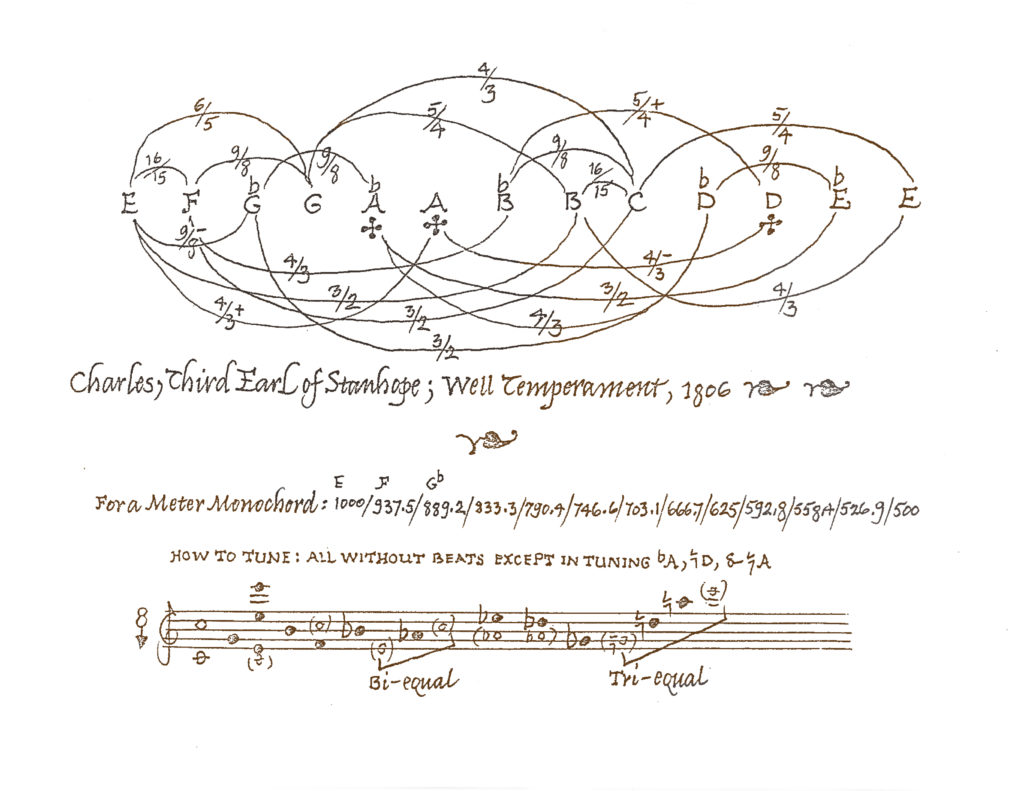
Iconoclast Centennials is a historical exhibition of invented instruments created by Bill Colvig, including original Lou Harrison just intonation tuning diagrams. On display will be rare original mimeos of tuning diagrams for Harrison’s just intonation zither as well as Colvig’s gamelan-like Tubaphone for Bill Alves, Coffee Can and Steel Pipe Sarons, Triangular Kanong and Bonang Pannerous; as well as a rasp, Clock Chime Guitar, Jangles and the Harmonic Series Instrument.
May 14, 2017 marks the 100th anniversary of the birth of the composer Lou Harrison. This year likewise marks the birthday centennial of Lou’s partner and musical collaborator Bill Colvig, born a hundred years ago on March 13.
In this exhibit, we celebrate their shared centennial with a collection of some of their most interesting and representative instruments. Lou Harrison’s interest in percussion, Indonesian gamelan and just intonation were already in place when he met Bill Colvig in 1967. These interests were further developed by diving deeper into the world of musical instrument making, and as a craftsman, engineer, musician and highly inventive thinker, Bill was eminently suited as a collaborator for such an excursion. Together—with Bill as the lead fabricator—the two embarked on a decades-long exploration of the timbral and tonal possibilities of instrument design. Best known are the instrument sets they created for performances of Lou’s compositions inspired by Indonesian gamelan, in the first stirrings of what came to be known as the American Gamelan movement. In addition to the gamelan-inspired instruments, they built a variety of instruments for exploration and analysis of just tunings and the harmonic series. Along the way they made a diversity of other oddities and one-offs. The instruments reflected Bill’s characteristic style of craftsmanship—imaginative yet functional—and Lou’s personal ornamental and decorative sense. All were tuned to the carefully conceived just scales upon which Lou built his music.
We are grateful for the assistance, suggestions, information and instrument loans offered by Larry Polansky, Willie Winant, David Bernstein and the Mills College Department of Music, Charles Hanson, University of Santa Cruz Library Special Collections, and Steed Cowart.
William (Bill) Colvig (March 13, 1917 – March 1, 2000) was an electrician and amateur musician who was composer Lou Harrison’s partner for 33 years, whom he met in San Francisco in 1967. Colvig helped design and construct the American gamelan used in works such as the puppet opera Young Caeser (1971), La Koro Sutro (1972), and the Suite for Violin and American Gamelan (1974). His influence as an instrument inventor drove Harrison’s explorations of tuning and timbre, and inspired generations of instrument inventors, helping to create a nexus for invention in the SF Bay Area.
Lou Harrison’s (1917-2003) music is characterized always by exquisite sonorities. Central to his pursuit of this quality was his concern with the particular tunings in which his works were to be realized. He did not seek exotic or revolutionary tunings so much as he searched for whatever tunings would be most right, most natural, most beautiful for the work at hand. Among other things, he had a particular interest in historical tunings—tunings developed before the dominance of 12-equal. It happens that Lou Harrison had a way with an ink pen as well (his calligraphy was beautiful), and this can be seen in the charts seen here representing early European temperaments.
Lou Harrison Archive MS132, University of California at Santa Cruz Special Collections
Pacific Resonance
Thu, Mar 2 — Fri, Apr 28, 2017
Artist Talk and Demonstration
Thursday, March 9, 2017, 6 to 8 PM
Join the artist for a free opening reception! Talk and demonstration will begin at 7 PM.

Sonic Windows is a series of immersive sound environments that feature binaural recordings of underwater landscapes from the Pacific Ocean – Wellington, New Zealand, Pier 39 San Francisco and Monterey Bay. The human ear is tuned for air and therefore not equipped to perceive distance and orientation underwater. Using a pair of spaced microphones, the artists were able to create an underwater stereo experience that is otherwise unattainable for the human ear. Inspired by the sailor’s ditty box, the listening stations were created from reclaimed boat timber.
Quiver is a metal sound sculpture that utilizes vibration transducers, contact microphones and touch sensors to explore material resonances and interdependent, nuanced control of sound.
Artist Statement
My work is built out of four main influences: Computer Music, New Musical Instrument Design, DIY Maker culture, and a deep relationship with the natural world, particularly the ocean.
Increasingly, I am looking for ways to reintegrate the natural acoustic resonances of the materials that make up traditional instruments – wood, metal, etc – into the instruments that we create to control computer music.
About the Artist
 Sasha Leitman is a composer, artist, teacher and inventor.
Sasha Leitman is a composer, artist, teacher and inventor.
Raised on the Central Coast of California, she began studying music and guitar at aged 11. Originally focused on composition, she also was an obsessive builder and tinkerer. Sound art and musical instrument design allow her to combine her musical interests with knowledge of electronics, woodworking, metal work, fabrication and computers.
She has spent the last ten years teaching and managing the Max Lab prototyping facilities at Stanford Unviersity’s Center for Computer Research in Music and Acoustics. In July, she will move to Wellington, NZ to begin work on an engineering PhD exploring the design of computer music controllers inspired by the nuanced control of acoustic instruments.
CMT Creates Music
Thu, Jan 12 — Tue, Feb 28, 2017
Artist Talk and Demonstration
Thursday, January 12, 2017, 6 to 8 PM
Join the artist for a free opening reception! Talk and demonstration will begin at 7 PM.
Artist Statement
CMT Creates Music is an art project led by Tim Phillips to create awareness for Charcot Marie Tooth disease (CMT) through the creation and performance of experimental musical instruments. It is a unique collaboration between artists, musicians and experience with Charcot Marie Tooth disease.
The project facilitates the creation of new musical instruments by people with little to no previous experience of making them, but are highly skilled in other fields such as electrical engineering, filmmaking, bike racing, printmaking, teaching, to name a few. There are ten instruments so far, the results are diverse and unexpected, each bringing a new design process and new ways and needs to collaborate. These instruments have had a tendency to be large, so we have chosen three to exhibit in the Window Gallery, the Stringtotter, the Chime Forest and the Bubble Organ.
 |
Stringtotter By Nao Nakazawa (Filmmaker & Violinist) The Stringtotter is the result of a violinist who has too much fun at the park. A long two string bass is mounted to the topside of a teeter totter, requiring two people to play it as they ride the instrument; one plucking or bowing rhythm, one changing pitch. The string bass sounds are then amplified through an effects pedal, the variables of which are adjusted by the motion of the seesaw, meaning the sound changes depending on the position of the performers. |
 |
Chime Forest By Sam Hernandez (Solar Engineer & Trombonist) The Chime Forest is a patient electricians instrument, with careful repetition in its construction, the sound of a corralled wild force is the reward. The instrument consists of 18 glass vases, each with an electric motor suspended above it that can be raised and lowered by the performer. The motors have various things attached to the ends that throw the rotation off balance and make the motors jiggle. When the motors are lowered, they collide with the vases, making a tone. Since the motors are unbalanced, they bounce off the vases and then collide again, creating a fairly regular but unpredictable rhythm. Combining multiple motors creates evolving polyrhythms that are equally driven by happenstance as the performer. |
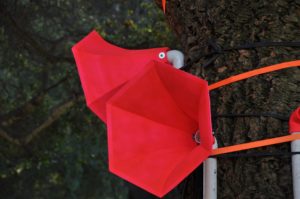 |
Bubble Organ By Tim Phillips (Museum Designer, Accordionist, Sound Artist) The Bubble Organ was created due to a fascination of bubbling tones and an effort to manually control them just enough to play music. The result is a wind instrument that has a system of manual bellows allowing the performer to blow bubbles into a variety of acoustic chambers filled with water. Each chamber plays differently pitched bubbling tones that can be either individual bursts or long drones that are acoustically amplified for the listener through exponential horns. |
Online, ‘CMT Creates Music’ has used this unusual instrument making process to introduce people to the disease CMT. Conception of these instruments has been documented in a blog alongside personal experiences from people living with CMT, every post is half instrument design, half CMT experience. The two dialogues have fed enthusiasm for each other, taking turns to generate energy and discussion. The result is a project that was envisaged to be a month long and has now been running for nearly seven years with over 30 collaborators!
For more information visit cmtcreatesmusic.blogspot.com
What is CMT?
A big problem with CMT is that people don’t know about it, even though it affect 1 in 2500 people in the US alone. This means that a huge number of people that have it are misdiagnosed and so suffer more than they need to.
CMT is short for Charcot Marie Tooth. It is a neurological disorder that causes damage to the peripheral nerves; a peripheral neuropathy. In very general terms, the connection between the brain and both muscles and sensory organs is damaged. For example, if someone touches a CMT patients foot, the foot senses it, but the message never gets to the brain, so they don’t feel it. CMT patients slowly lose normal use of the feet/legs and hands/arms as nerves to the extremities degenerate.
An international team of researchers, backed by the CMTA, have had a breakthrough in finding a cure and are currently working through the trial procedure. This project raises both money and awareness to support that cause.
Please tell someone else about CMT.
Thank you,
Tim
About the Artist
Tim Phillips is an English sound artist, musician and inventor based in Oakland, CA. His work looks at making people curious about sounds and rhythms, while using participation and collaboration to encourage interdisciplinary and unexpected outcomes.
Tim received a BA and MA in architecture from Sheffield University, England and has worked on public architecture and installations throughout Great Britain and France. He is currently a senior designer at an Oakland-based design studio, Gyroscope, Inc., designing interactive exhibits and artworks for museums and public spaces across the US.
Tim has CMT, so this project is close to his heart. It has become remarkable thanks to a community of generous collaborators that continue to open it in new directions.
Collaborating artists on CMT Creates Music
Charlie Gurke (Bartz Box)
Claire Phillips (Sound Swing)
HJ Mooij (Tinkler)
Maria Mortati (You Can Ring My Bells)
Meghann Welsh (Texture Harp)
Nao Nakazawa (Stringtotter)
Sam Hernandez (Chime Forest)
Will Longstreth (Musicycle)
Krystyna Bobrowski, Sliding Sonorities
Thu, Nov 10, 2016 — Wed, Jan 4, 2017
Artist Talk and Demonstration
Thursday, November 10, 2016, 6 to 8 PM
Join the artist for a free opening reception! Talk and demonstration will begin at 7 PM and will feature a performance of In Two Directions, for piano and electronics, 1998, with pianist Jennifer Peringer.
About Sliding Sonorities
The exhibit Sliding Sonorities explores the sonic manifestations of the physical motion of sliding in two original musical instruments by Krystyna Bobrowski, Gliss Glass and the Sliding Speaker Instrument. While the instruments may be played individually, the design of the exhibit encourages musical interaction, collaboration and cooperation among visitors.
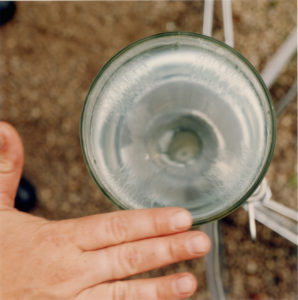
Krystyna Bobrowski
Gliss Glass is an original instrument consisting of a series of custom glass vessels of various sizes, filled with water, interconnected by a system of tubes and valves. Though much larger than a wineglass, the instrument is played in much the same way, by running a wet finger or hand around the rim. The glass vessels are lightly amplified to pick up subtle squeaks, sloshes and scrapes.
The musician controls the water level and flow through the instrument by manipulating the valves and vessel heights. As water drains or fills a glass vessel, the frequency rises or falls respectively. By making use of the basic principle of hydraulic equilibrium, the instrument creates naturally slow, shifting glissandos.
Gliss Glass was created by Krystyna Bobrowski during a residency at the Akademie Schloss Solitude in Stuttgart, Germany, 1997-98, and debuted by Bel Canto at the Internationale Ferienkurse für Neue Musik, Darmstadt, 1998.
Sliding Speaker Instrument
Krystyna Bobrowski
The Sliding Speaker Instrument consists of a loudspeaker tied to a string inside a five-foot long acrylic tube mounted in a modified cymbal stand. The loudspeaker acts as a moveable stop for the tube, in effect changing the tube’s length and resonance. As the musician slides the speaker up and down the tube, she slides through the harmonic resonances of the drone-like audio material being played. The Sliding Speaker Instrument was created by Krystyna Bobrowski and was debuted at the San Francisco Electronic Music Festival, 2004.

Between Resonance
Gordon Shrigley
ink and graphite on paper, 94 x 71 cm, 1998
Exhibited courtesy of Image Music Text Gallery, London
The graphic score Between Resonance grew out of a collaboration with the composer Krystyna Bobrowski, during our time as artists’ in residence at the Academy Schloss Solitude in Stuttgart, Germany in 1998.
The drawn score is an attempt to find a graphic language to reflect the unique nature of the glass vessels Krystyna had invented and also the various ways each player’s hands interact with the instruments to make sound for the composition ‘Oceans in a box’.
Through reading the various symbols and hues on the drawings, a clear instruction of how to play is communicated through a process of direct translation via the accompanying key and also what might be considered as ‘semiotic filtration’, by which the drawing merely suggests the tone of the performance simply by the character of the various lines on the picture plane.
Gordon Shrigley, 2016.
Artist Statement
I make work based on my direct experience with sound and acoustic phenomena. Through installations, instrument building, composition, and improvisation, I invite people to actively share this experience in a cooperative way. Communication, social interaction and cooperation are all part of music making and community making in general; yet, they are often unspoken and unseen. What is the sound of cooperation?
Physics and acoustic phenomena inform my work. I use the acoustic principle of resonance to create a physical filter sweep in the Sliding Speaker Instrument; the physics of hydraulic equilibrium to create slow, shifting glissandos in the instrument Gliss Glass. These effects could be created easily with electronics alone; however, I choose to use the inherent limits of physical materials. With electronics I can make a glissando of any speed; with a vessel of water the glissando can only move as quickly as the water can drain. Choosing to work with physical limits creates a natural form and develops an intuitive understanding of the phenomenon behind them.
About the Artist
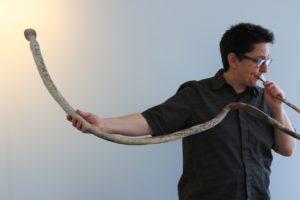
In addition to performing her own work, she has performed and recorded the pieces of other composers including David Behrman, Anthony Braxton, John Cage, Alvin Curran, Lou Harrison, Larry Polansky, Wendy Reid and Christian Wolff. She has performed a number of times with the Merce Cunningham Dance Company and continues to collaborate with musicians in the Bay Area improvised music community. She performs and collaborates extensively with the improvisation ensemble Vorticella: Erin Espeland, Brenda Hutchinson and Karen Stackpole.
Bobrowski received her M.F.A. in Electronic Music and Recording Media from Mills College and her B.A. in Computers and Music from Dartmouth College where she first met and studied with Christian Wolff. She lives in Oakland, CA and teaches at the College of San Mateo (CSM) where she instituted the CSM Electronic Music Program. She has been an artist-in-residence at the Exploratorium, San Francisco, CA, Headlands Center for the Arts, Marin, CA and the Akademie Schloss Solitude, Stuttgart, Germany. Her scores are available through Frog Peak Music, a composers’ collective.
Susan Rawcliffe: Music in Clay
Thu, Sep 8 — Mon, Oct 31, 2016
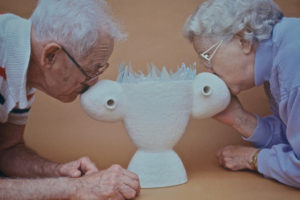
|
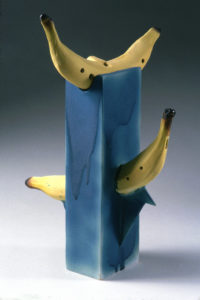
|

|
ARTIST TALK AND DEMONSTRATION
Thursday, September 8, 2016, 6 to 8 PM
Join the artist for a free opening reception! Talk and demonstration will begin at 7 PM.
Artist Statement
I make, play and research clay musical instruments: flutes, pipes, ocarinas, whistles, trumpets, didjeridus, and sound sculptures. Wanting to build a better flute, I began my research into the sounds and forms of archaic ceremonial flutes from prehispanic meso-American cultures, including the West Mexican, Olmec, Mayan, and Aztec. Making acoustical studies and then learning to play them unites a Western sensibility with ancient sounds, and can teach the next step for flute construction. Through reinvesting my insights, these flutes may evolve into new instruments that then inspire with their wonderful scale patterns and evocative timbres.
By cultivating peculiar acoustic systems, I can generate peculiar and sometimes extraordinary sounds. I love subtle up close differences between sounds, the interaction of breath & sound, and feeling sound in my body. Some are raw, like animals, like grief; others evoke human voices singing or crying; sometimes, strange tones buzz inside each head.
Many of my flutes and sound sculptures have highly unconventional shapes. I enjoy considering their appearance, how the air flows, and how each fits into hands and mouths. Sometimes I create a social sculpture with multiple flutes and whistles, suggesting opportunities for unique & potentially intimate interactions between sounds and between friends.
About the Artist
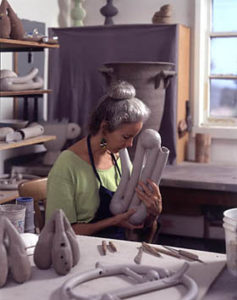 In 2011, a Cultural Exchange International grant from the Department of Cultural Affairs, Los Angeles, enabled Susan Rawcliffe to play, measure & photograph over 300 prehispanic West-Mexican clay flutes from the Crossley-Holland Collection at the University of Wales, Bangor, UK. Past grants include several from the Department of Cultural Affairs, City of Los Angeles; a McKnight Visiting Composer's grant from the American Composers Forum; and the National Endowment for the Arts.
In 2011, a Cultural Exchange International grant from the Department of Cultural Affairs, Los Angeles, enabled Susan Rawcliffe to play, measure & photograph over 300 prehispanic West-Mexican clay flutes from the Crossley-Holland Collection at the University of Wales, Bangor, UK. Past grants include several from the Department of Cultural Affairs, City of Los Angeles; a McKnight Visiting Composer's grant from the American Composers Forum; and the National Endowment for the Arts.
Past performances include: on and off Broadway, NYC; the Los Angeles Theater Center; the Museum Of Contemporary Art, Los Angeles; the Museum of Neon Art, LA; and international festivals such as the Edinburgh Arts Festival, Scotland; Pipeline, Berlin, Germany; AudioArts, Krakow, Poland; and Sound Art, St. John, Canada.
Exhibitions include: the American Museum of Ceramic Art, Pomona, CA; Yerba Buena, San Francisco; Clay Studio, Philadelphia, PA; Winter Gardens, NYC; California Craft Museum, SF; the Renwick Gallery, Wash. DC; and P.S. #1, NYC.
Lectures include: the Smithsonian, Washington DC; the Metropolitan Museum, NYC; the Wats:on Festival for Interdisciplinary Artists at Carnegie Mellon University, Pittsburgh, PA; the Acoustical Societies of America, Mexico & Iberoamerica; the American Association for the Advancement of Sciences; the Los Angeles County Museum of Art; and the International Study Group on Musical Archaeology, Germany.
Published works include both four scholarly musical archaeology articles on my research into prehispanic instruments, as well as many articles on my work as an artist creating & playing ceramic flutes, pipes, ocarinas, whistles, trumpets, didjeridus and sound sculptures.
For more information, visit artawakening.com/soundworks.
Imaginary Mechanical Instruments
Thu, Jul 28 — Fri, Sep 2, 2016

Imaginary Mechanical Instruments
Historical and Contemporary Prints
FREE Reception July 32, 26pm
at the Center for New Music
53.7 Taylor Street, San Francisco
with selected realizations and multi-touch applications by Ian Saxton
(Actual Free Reception August 26, 7pm, 55 Taylor Street, SF)
With images dating from 1618-1995, the variety of pure inventive genius on display includes excellent reproductions of JJ Grandville, Robert Fludd, and Johann Gottlob Kruger. Images from Experimental Musical Instruments Journal including Cloud 8 Archives by Hal Ramel contribute more contemporary works of fictional acoustic fantasy.
In a time of unprecedented activity and innovation in sound technology, a museum of imaginary musical instruments may seem unbearably twee. What could these phantasms have to do with the real instrumentarium that expands dizzyingly around us every day?
We believe that these artifacts matter now more than ever, when our world is held so powerfully in the thrall of real technologies and the often deterministic rhetoric that accompanies them. Imaginary instruments are relevant not as a form of escapism or unhinged fantasy, but precisely because they highlight the permeable boundaries between the actual and the possible. Just as, according to Jung, everything that appears in a dream represents an aspect of the dreamer’s psyche, all that the human mind dreams up is a commentary on the mundane realm we inhabit. To conceive of a counterfactual technology—whether impossible or merely impractical—is to make a statement about the empirical world, to shed light into the shadows of the real, and to proclaim the possibility of things being otherwise.
Although imaginary instruments have a history probably as long as that of human technology itself, they share with the aesthetics of modernism and the avant-garde a certain visionary impetus. Like the best new music, they issue a challenge to convention and posit the existence of alternative ways of hearing, thinking, feeling, and being. With this special exhibit, we share some of the most outlandish, delightful and intricate imaginary musical instruments from the last 400 years; may they inspire many more.
Guest Curators:
Deirdre Loughridge and Thomas Patteson
Museum of Imaginary Musical Instruments
Larnie Fox: Cranks and Other Noisemakers
Thu, Jul 7 — Wed, Aug 31, 2016
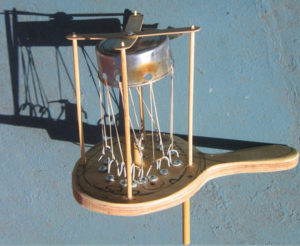 |
ARTIST TALK AND DEMONSTRATION
Thursday, July 7, 2016, 6 to 8 PM
Join the artist for a free opening reception! Talk and demonstration will begin at 7 PM.
Artist Statement
I like to make things that other people think are “cool”. I like other people to make things that I think are “cool”.
I think the choice of “rules” is crucial for a work of art. I strive to be conscious of the “rules” that I am working with. A few of the “rules” of the pieces in front of you are as follows:
1. The piece must produce sound.
2. The piece must function as visual art.
3. The piece must be made primarily from recycled materials.
4. The piece must be made utilizing relatively low-tech techniques.
There is something about good art that strives to transcend categories that are later imposed on it. I value integrity and originality, in my work, and in the work of others.
About the Artist
 Larnie Fox is a visual and sound artist known for paintings, monumental bamboo sculpture, sound art, sound installations and performances. His kinetic/sound sculpture and paintings have been shown in one-person shows at The Lab, The Richmond Art Center and The Randall Museum, and in numerous group shows and performances. He directs the Crank Ensemble, a fourteen-member group that performs on hand-cranked instruments built by Larnie. He was commissioned to create and burn a 20 ft. bamboo and muslin windmill at Burning Man, and there he made and flew a bamboo airplane with his wife Bodil. Other collaborations with Bodil have included set design and construction for Theatre of Yugen’s “Cycle Plays” at Theatre Artaud (now Z Space), a giant kinetic dragonfly for the DuPage Museum near Chicago, and “Time Sensitive Materials” at Cricket Engine in Oakland, CA.
Larnie Fox is a visual and sound artist known for paintings, monumental bamboo sculpture, sound art, sound installations and performances. His kinetic/sound sculpture and paintings have been shown in one-person shows at The Lab, The Richmond Art Center and The Randall Museum, and in numerous group shows and performances. He directs the Crank Ensemble, a fourteen-member group that performs on hand-cranked instruments built by Larnie. He was commissioned to create and burn a 20 ft. bamboo and muslin windmill at Burning Man, and there he made and flew a bamboo airplane with his wife Bodil. Other collaborations with Bodil have included set design and construction for Theatre of Yugen’s “Cycle Plays” at Theatre Artaud (now Z Space), a giant kinetic dragonfly for the DuPage Museum near Chicago, and “Time Sensitive Materials” at Cricket Engine in Oakland, CA.
Fox is also an arts consultant currently representing the Estate of the painter Jon Schueler. He formerly was Executive Director of Arts Benicia and Director of the Children’s Fine Art Program for the City of Palo Alto at the Palo Alto Art Center. He has taught drawing, art appreciation and color design at Weber State College, Ogden, Utah, and drawing at the Community University in Bozeman, Montana. He is a founding member of 23five, a Bay Area non-profit that promotes sound art. He holds an M.F.A. in Painting and Drawing from the University of Utah, and a BA in Painting and Drawing from Slippery Rock University, Pennsylvania, and lives, works and collaborates with his wife Bodil in Benicia, CA. He and Bodil are past resident artists at the Montalvo Art Center’s Lucas Artists Residency Program in Saratoga, CA.
Kraut Kontrol by Trimpin
Tue, May 10 — Thu, Jun 30, 2016
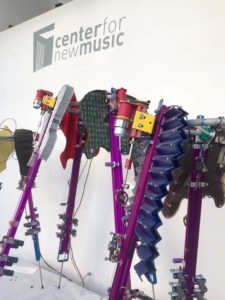
|

|
SPECIAL PREVIEW & ARTIST TALK
Sunday, May 8, 5-7 PM
Join the artist for a free opening reception! Talk and demonstration will begin at 6 PM.
Trimpin will rebuild and install Kraut Kontrol, a unique sculptural instrument that has not been viewed since its premiere installation at the Orange County Museum of Art in 2001.
About the Artist
A sound sculptor, composer, engineer, and inventor, Trimpin has been called “one of the awesome musical geniuses of the early 21st century.” A specialist in interfacing computers with traditional instruments, he has developed ways of playing everything from giant marimbas to stacks of electric guitars via computer. Trimpin has been hailed in New York’s Village Voice as “a genius at circuitry and machinery as well as acoustics and musical structure [who] manufactures orchestras that play themselves.”
Born in southwestern Germany near the Black Forest, Trimpin spent several years living and studying in Berlin, working as a set designer and meeting up with artists from both Germany and the United States. He relocated to the States in 1979.
In 1997, Trimpin received both a MacArthur “Genius” Award and a Guggenheim Fellowship for his creative investigations of acoustic music in spatial relationship. In 2005-2007, museums and galleries throughout the Pacific Northwest mounted an extensive retrospective of Trimpin’s work; the New Yorker magazine profiled him; and local press hailed him as “a composer / sound artists / engineer / god.”
Yet Trimpin shuns the hype of the art world. To date, he has never been represented by a gallery or a dealer, and has never allowed recordings of his work to be commercially released.
Bosky Jangle – Instruments by Bart Hopkin
Thu, Mar 3 — Mon, May 2, 2016
ARTIST TALK AND DEMONSTRATION
Thursday, March 3, 6-8 PM
Join the artist for a free opening reception! Talk and demonstration will begin at 7 PM.
Artist Statement
Bosky Jangle is a foresty-feeling kinetic soundspace. In the past few years I’ve made several semi-self-playing instruments – musical instruments which, once set in motion, continue to sound of their own accord for some time, leaving the player free to layer in sounds from other sources. Bosky Jangle follows from this. Within the forest, you can give one of the bell tree branches a nudge to put it in motion, letting it dance about and ring for a bit. Soon you may randomly add in another bell-branch or two to bring in some new tonal color. After listening to the resulting blend for a time, perhaps you’ll add another branch to take the cumulative soundscape in some slightly different tonal direction. When you’ve arrived at an appealing mélange of ongoing bell tones, you can turn to one of the other instruments of the forest to improvise and melodize freely over the bells, occasionally pausing to alter the texture and tonality by activating new branches and bringing in fresh bell tones. Some of the nicest forest sounds come as the motions of the bells slowly die down, leaving ever more open textures as they settle into quietude.
About the Artist
Bart Hopkin is a musical instrument designer and maker; publisher, author and teacher on topics relating to musical instruments. From 1985 – 1999 he edited and published the journal Experimental Musical Instruments, focusing on unusual instruments with an emphasis on inventive contemporary work, primarily acoustic. During those years and since, he has published numerous books on diverse topics in instrument design and construction, as well as books and audio CDs presenting the work of contemporary instrument makers worldwide. In recent years he has served as co-curator for the Window Gallery exhibit space at Center for New Music in San Francisco. As an instrument maker, his work focuses on innovative application of acoustic principles to create both conventionally tuned instruments and more exotic sound sources.
Oliver DiCicco – The Magnetic Series
Fri, Jan 1 — Mon, Feb 29, 2016
Artist Talk and Demonstration
Thursday, January 7, 6 – 8 PM
OLIVER DICICCO ARTIST STATEMENT
My work is about the intersections of disciplines. The point where music, sculpture, mechanics and engineering meet, is an intriguing place for me. I try to create pieces that work on these many levels. My interest in music and sound comes from my many years as an audio engineer and musician. My passion for building and tinkering comes from an early childhood spent in my father’s workshop.
Inspired by the work of Harry Partch, I began building musical instrument sculpture in the late 80’s. That process led to the instruments that would become the Mobius Operandi ensemble. The group progressed from concerts to large inter-disciplinary performances. The performance pieces became the genesis for my work in kinetic sound sculpture. As the scope of the performances grew, the kinetic sculpture became an integral part of the pieces, with dancers, actors and musicians interacting with them.
My latest work explores my fascination with magnetic fields and feedback loops. I find the harmonic resonances and the visual movement of vibrating rods almost hypnotic, the random nature of the sound and the shifting interaction of the resonating frequencies, compelling. I’m drawn to the aesthetic of old analog and tube equipment, and have tried to capture the flavor of that era in the visual elements of the pieces.
PENTODE, utilizes shifting magnetic fields to create a feedback loop in the lengths of guitar strings suspended above electromagnets. The strings are positioned near electromagnetic pickups, the sound from the pickups is routed to an amplifier, the output of which feeds a speaker as well as the electromagnets. At the end of each string is a magnet which is repelled or attracted by the changing field in the electromagnets, causing the strings to resonate in a feedback mode.
OTYPE field effect, works on a similar principal to PENTODE. The piece is interactive, turning the large knob on the top of the base, will change the gain of the feedback, affecting the vibration of the rods, and the spinning of the rubber rings.
WAITING FOR THE BIG ONE uses electromagnets which are turned on an off sequentially by means of an optical switch. As the magnets are energized they attract and repel a magnet located in the base of the pendulum, this causes the pendulum to swing and gain momentum. The rocker arms below the magnets are repelled each time the magnet is on, which in turn causes vibrations in the metal rods at the end of the arms. The vibrations are amplified and fed to a pair of speakers. As the rods touch the rotating strings located below them, upper harmonics are created. The piece reminds me of a seismograph, hence the name.
Sudhu Tewari: Tune for Minimal Smoke II
Sun, Nov 1 — Thu, Dec 31, 2015
Artist’s bio:
Sudhu Tewari has been called a professional bricoleur, junkyard maven and young audio-gadgeteer. Sudhu builds electronic audio devices, electro-acoustic musical instruments, kinetic sculpture, interactive installations, wearable sound art, mechanical televisions, physical models of astrophysical phenomena, and sound sculpture. Highly educated at Mills College in electronic music, Tewari has been seen performing improvised music on the east and west coasts of the US, Europe, and Japan. In 2006 Sudhu was selected to be the Artist in Residence program at the Recology in San Francisco. Since then, Tewari’s visual and interactive art has been exhibited at many galleries and museums in the Bay Area and a few in Europe. Tewari is currently a PhD candidate at UC Santa Cruz in the Cultural Musicology program. Sudhu also teaches youth and adult classes at the Crucible in Oakland and has recently been working with young adults to create interactive, kinetic, and musical public art works.
Artist’s statement:
I build non-traditional, experimental instruments. “Experimental” means the instruments themselves are experiments based on the question “what happens if I do this?” or “what if _______?” Innovation and experimentation are far more important to me than creating beautifully finished instruments. I’d rather have a pile of prototypes (on a pile of protoypes), suprises that present a plethora of options for future work.
I enjoy being surprised by music. After many years of playing improvised music I lost interest in my own playing, finding it harder and harder to surprise myself. One solution had been to continually build new “peripheral” instruments which could be plugged into my main instrument: a metal stereo receiver chassis to which were affixed a variety of sound making devices, amplified with contact microphones, electret microphones and electro acoustic pickups, which at various times has been named SHOZYG (Hugh Davies), Electro-acoustic Percussion Box (Tom Nunn), or heavily modified readymade (Fred Frith). Some of these peripherals, acoustic, electro-acoustic and electronic, and new experiments will be displayed in this show.
Another solution is to build self-governing/playing instruments so that I could turn them on, watch, listen, and occasionally be surprised. Thanks to the commission from Music for People and Thingamajigs I am able to return to building/experimenting with a large-scale self-governing instrument, my Prepared Player Piano Pinball system (PPPPs). PPPPs consists of several electronically controlled “interpretors”, devices that perform a simple function which is, often counter to the purpose of other interpretors, creating web of complex interactivity based on the simplest reactive behaviours. Since the system is built from individual “modules” it is infinitely expandable (inspired by Jean Tingueley) and provides me with a lifelong project into which I can integrate all of the pieces of my substantial collection of useful (suefule) junk. What will be presented in November at the Center for New Music represents merely an iteration of a much larger (future) work that will never be complete.
Yet another solution is to create instruments for others to play, a means of extracting, vicariously, the pleasure of new experiences from others. Additionally, these non-traditional instruments are free of traditional expectations. “But, I don’t know how to play that instrument.” is not a hindrance/obstacle to people (musicians) who walk in off the street and play my instruments.
Finding that most people (unlike myself) are visually biased, my sculptural and kinetic instruments attempt to draw the viewer in to a sound world by providing engaging visual elements as “bait”. Other pieces react to a human’s presence in ways that are not immediately (if ever) apparent, requesting humans to spend time with them without understanding “what’s going on.”
In writing a dissertation on the work of Tom Nunn, instrument builder extraordinaire, I’ve been inspired to steal elements (physical and conceptual) from his instruments to try out in new ways. These elements appear in all my newly created work, along with elements inspired by Jean Tingueley, Hugh Davies, Fred Frith, Bart Hopkin, and Peter Whitehead, amongst others.
Above all, my instruments and devices are meant to be FUN!
Less tuxedos, conductor batons, compositional hierarchies, ruffled sleeves, serious Classical music, more free-for-all, bare feet in the grass, toothbrushes cleaning the street, pianos playing nothing, hippie bullshit vibrating together.
Sung Kim: Failures, Prototypes, and Works In Progress
Fri, Sep 4 — Fri, Oct 30, 2015
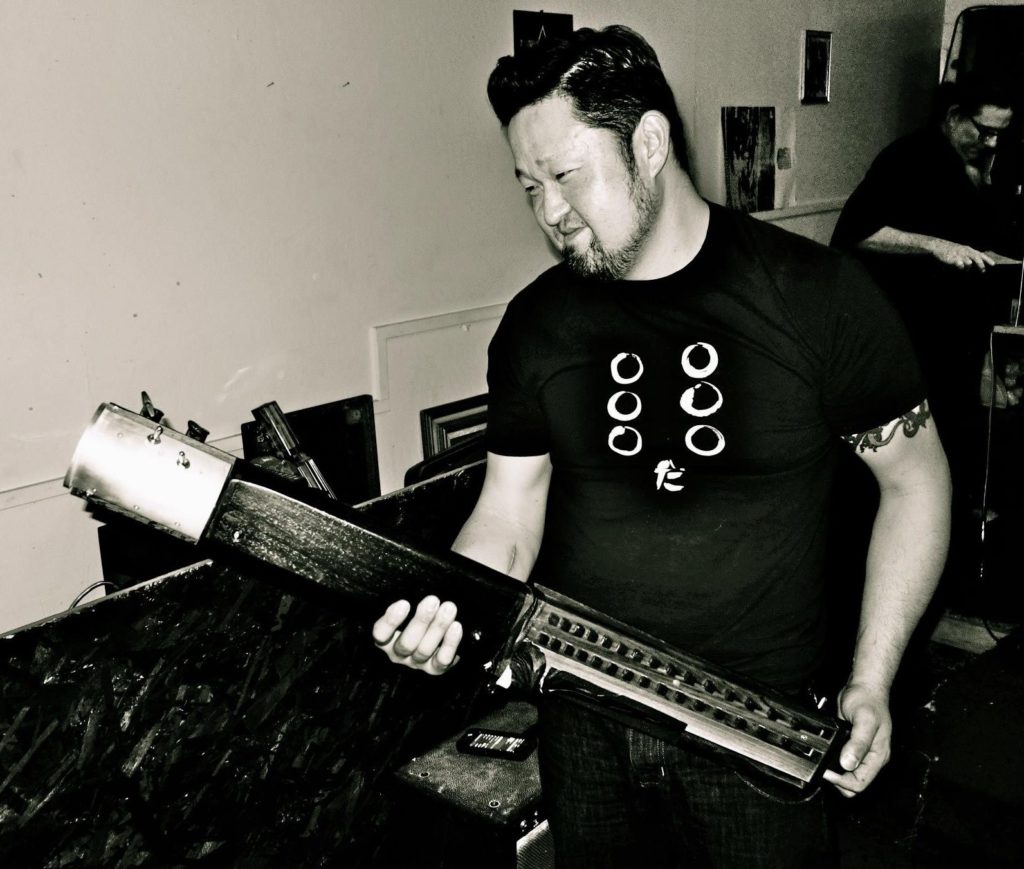
Artist Talk and Demonstration
Thursday, October 1, 6 – 8 PM
To open the Thingamajigs Festival (Oct. 1-2-3-4)
 Sung Kim (b. 1975) is an improvisor, sculptor, and instrument builder born in Seoul, Korea, and raised in Washington, D.C. In 1989, Kim studied ceramic sculpture at the Corcoran School of Art. It was at Corcoran that Kim started building his own variations of the guitar. Kim received his BFA in sculpture from the School of the Art Institute of Chicago in 1999. In Chicago, Kim began to deviate from the guitar to explore other techniques, tonalities, and sympathetic resonance. He also began collaborating with musicians to explore his instruments in an improvisational context. Kim now facilitates his musical and sculptural endeavors by owning and operating an architectural woodworking design/build studio in the San Francisco Bay Area.
Sung Kim (b. 1975) is an improvisor, sculptor, and instrument builder born in Seoul, Korea, and raised in Washington, D.C. In 1989, Kim studied ceramic sculpture at the Corcoran School of Art. It was at Corcoran that Kim started building his own variations of the guitar. Kim received his BFA in sculpture from the School of the Art Institute of Chicago in 1999. In Chicago, Kim began to deviate from the guitar to explore other techniques, tonalities, and sympathetic resonance. He also began collaborating with musicians to explore his instruments in an improvisational context. Kim now facilitates his musical and sculptural endeavors by owning and operating an architectural woodworking design/build studio in the San Francisco Bay Area.
My work as an instrument builder was born out of the necessity to create a voice for myself to articulate and to compose. My instruments are all works in progress and by treating them as such, I allow myself to constantly develop and build in an organic manner. Many of these pieces begin as individual components built as I develop solutions dealing with mechanics, playing techniques, and resonance. These components are then combined, modified, or discarded as needed.
New American Gamelan Instruments by Daniel Schmidt
Thu, Jul 9 — Fri, Aug 28, 2015
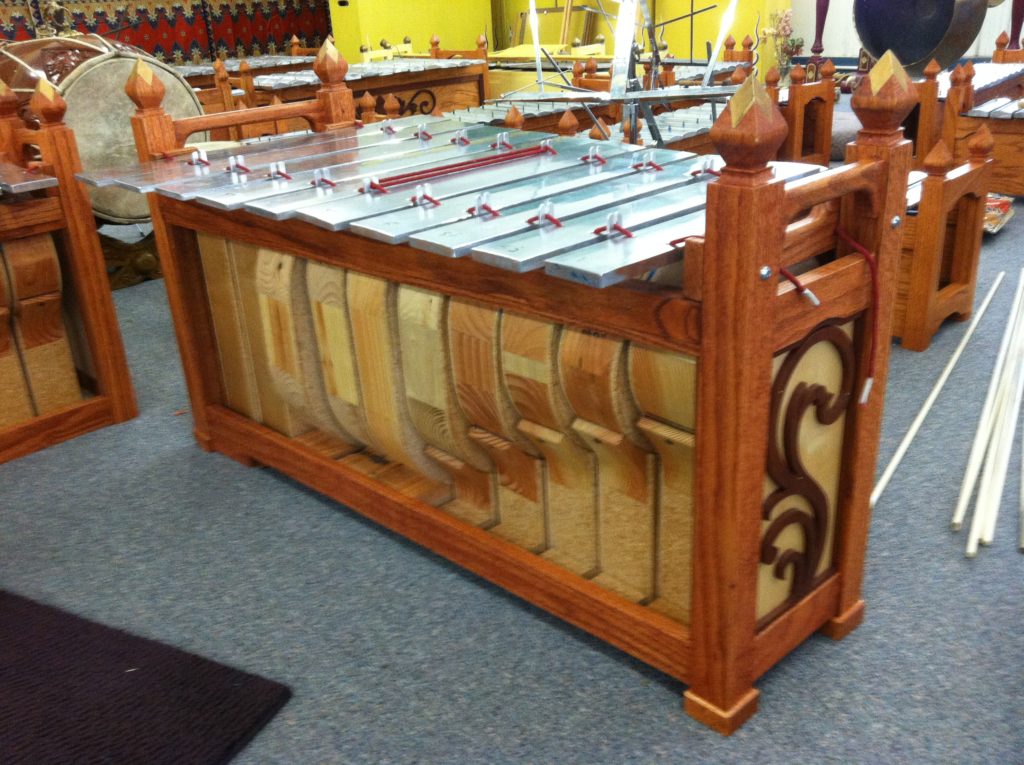
Daniel Schmidt has built the instruments displayed in this installation over the last five years with the help of students and alumni from Mills College. The bonang (the aluminum discs that look like flying saucers) and the slenthem (the lower range metallophone with a soft attack and long sustain) have been built in the last 2 years.
This gamelan is an aluminum set using the septimal just tuning for slendro used by Lou Harrison. The new set is unnamed, as it is not yet complete. If you have any suggestions, please let us know!
About the Artist
Daniel Schmidt Likes to take the scenic route. He spent the latter half of the 20th century dividing his efforts between electronic music, mixed media work, theater based activities, instrument design and building, singing, teaching, and performing and writing for traditional and American Gamelan. He has worked with Allan Kaprow, studied with K.R.T. Wasitodiningrat, helped build the electronic music studios at Cal Arts, and has built numerous aluminum gamelans. He has been the director of the Berkeley Gamelan, the Eugene Chamber Theater, and currently directs the gamelan ensembles at Mills College and the Universal Unitarian Church of Berkeley.
Although Schmidt’s pieces utilize a wide variety of different media (electronic tape based work, traditional acoustic instrumental work, mixed media work, etc.), there is always some undercurrent of experimentation; rhythmic oddities, the creation of specialized instruments, novel approaches to performance and performer interaction, and many other approaches.
Daniel Schmidt’s work as an instrument builder his highlighted by a long-time collaboration with the Paul Dresher Ensemble, and notable commissions from the Boston and San Francisco Symphonies, the Exploratorium, and North Texas State and Sonoma State Universities. Schmidt received his BA in music from Westminster Choir College, Princeton, NJ and his MFA in composition and Javanese Music from California Institute of the Arts.
Sunrise of the Planetary Dream Collector: Instruments from the Kronos Quartet and Terry Riley collections
Thu, May 7 — Mon, Jun 29, 2015
Opening Reception: Thursday, May 7, 6 – 8 PM
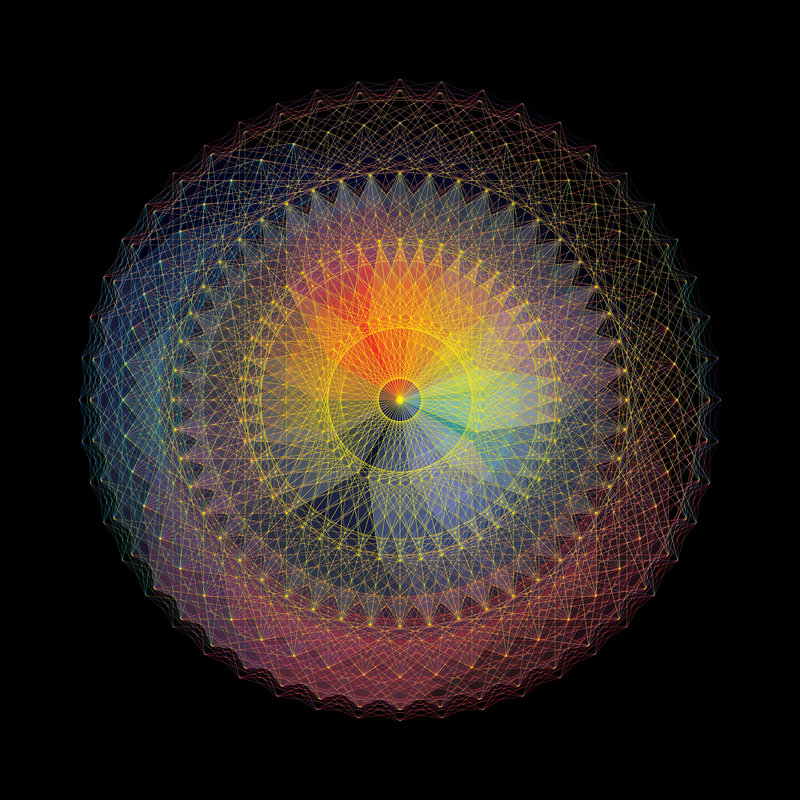
Kronos Quartet and Terry Riley began their decades-long friendship at Mills College in the late 1970s. Since then, Kronos has commissioned 28 works from Riley, more than from any other composer in the group’s history. This exhibit offers a peek into the sound worlds composer and quartet continue to create together, including original instruments by Walter Kitundu, vintage synthesizers, and shamanic plants.
In honor of Terry Riley’s 80th birthday, Kronos Quartet / Kronos Performing Arts Association announces KRONOS PRESENTS: Terry Riley Festival, a three-day festival, June 26-28 at the SFJAZZ Center, featuring performances of several of the composer’s most significant and rarely-performed works, with special guests Zakir Hussain, Wu Man, The Living Earth Show, Gyan Riley and Terry Riley himself.
Visual Harmony: Contemporary Tuning Graphics
Wed, Apr 1 — Fri, May 1, 2015
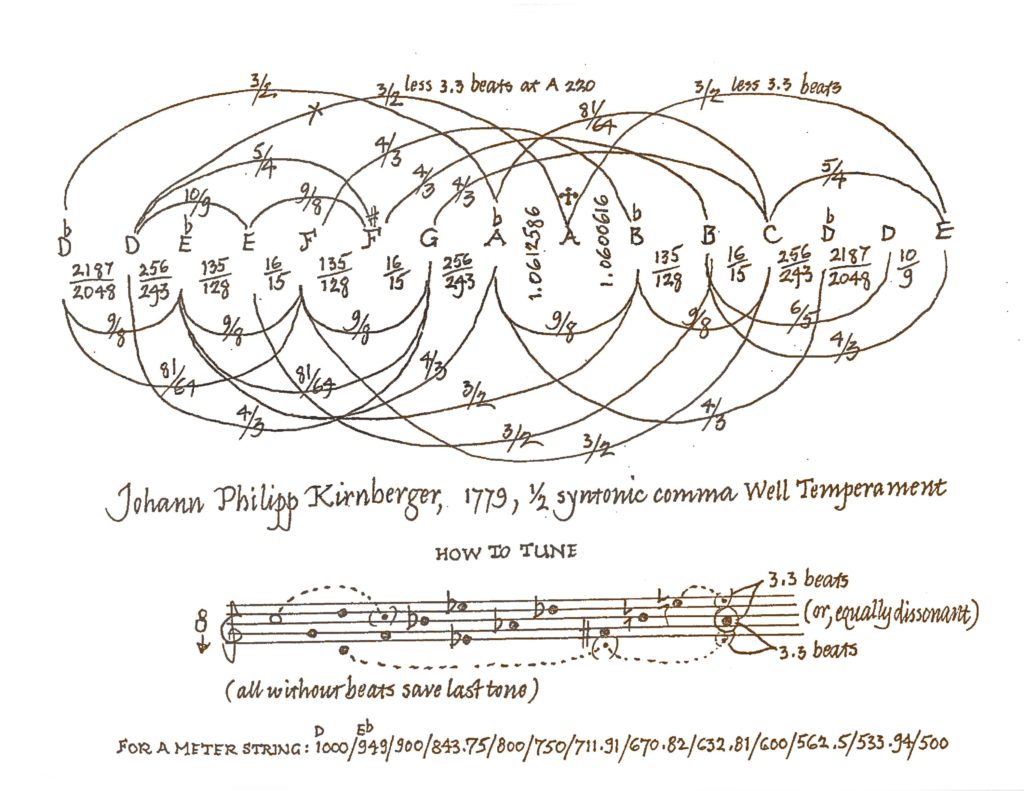
Most music in the western world uses a particular tuning system known as 12-Tone Equal Temperament. Over the last 200 years and more, this system has proven effective and extremely practical. But infinitely many other tuning systems are possible, and the argument can be made that some other systems reflect more naturally the way our ears and musical brains perceive and interpret musical intervals. In the 1960s and ‘70s, a number of composers and theorists began exploring anew the possibilities for musical scales outside the realm of 12-equal. This was by no means a new idea, but these thinkers brought a renewed energy and focus to the subject that continues strong among musical theorists to this day. This exhibit celebrates five of the leading lights of that movement.
The analysis of musical scales has its foundation in mathematics – a mathematics based on the frequencies of the pitches involved and the relationships between those frequencies. Scale analysis lends itself particularly well to geometric interpretation, with pitch relationships represented as spatial configurations. In the images displayed here, theorists and artists use graphics to illustrate the relationships and operations underlying diverse musical scales. Some of these images may originally have been designed primarily as diagrammatic and informational documents; others clearly were intended as art. In fact, all are both: in the mathematics of scale expressed as geometry, we find visual harmony.
Lou Harrison (1917-2003)
Lou Harrison’s music is characterized always by exquisite sonorities. Central to his pursuit of this quality was his concern with the particular tunings in which his works were to be realized. He did not seek exotic or revolutionary tunings so much as he searched for whatever tunings would be most right, most natural, most beautiful for the work at hand. Among other things, he had a particular interest in historical tunings – tunings developed before the dominance of 12-equal. It happens that Lou Harrison had a way with an ink pen as well (his calligraphy was beautiful), and this can be seen in the charts seen here representing early European temperaments.
Lou Harrison Archive MS132, University of California at Santa Cruz Special Collections
Harry Partch (1901-1974)
Harry Partch’s primary interest was in just intonation – which is to say, tuning systems based on ratios between whole numbers – and in broadening the tonal resources available to composers by expanding the range of ratios that listeners could accept as musically meaningful. In pursuing this he was “seduced” into instrument making, and in many of his instruments the implicit logic and geometry of the tuning systems was reflected as two-dimensional arrays in the spatial layout of the sounding elements. Many of his ideas also take shape as diagrammatic representations of pitch relationships, as can be seen in his pieces exhibited here.
Tonality Diamond used by permission of Innova Recordings, from Enclosure Three: Harry Partch.
Ervin Wilson (b 1928)
Erv Wilson’s primary role has been not that of the composer, but that of one who creates the systems with which composers can work – or, more accurately, one who seeks to illuminate the tonal possibilities available to all. The mathematical organizing principals that underlie his explorations provide illuminating ways to think about scales of all sorts, and, beyond that, to think about an infinite, non-static universe of possible scales. He has represented his ideas in two-dimensional charts as can be seen in the graphics reproduced here, as well as three-dimensional physical models, and more abstractly as multidimensional spaces.
Graphics courtesy of the Erv Wilson Archive, Kraig Grady, curator.
John Chalmers (b 1940)
John Chalmers has published extensively in the field of tuning theory, both as author of his own works and as founder of the journal Xenharmonikon. In recent years he has used computer graphic software to generate exquisite realizations of scale geometry as color images in print and on the screen. Each of his prints in this exhibit represents a particular scale, the image resulting from the functional relationships of the scale translated into location and color.
Images courtesy of John Chalmers. More images can be found on the John H. Chalmers Facebook page.
Ivor Darreg (1917-1994)
Ivor Darreg was interested in both just intonations (tuning systems based on the ratios between the frequencies of the pitches) and equal temperaments (tunings with pitches equally spaced through the octave, which require a different mathematical approach). He was fascinated by the unique aesthetic effect – the characteristic “mood”, in his word – created by each tuning. The charts included in this exhibit are representative of his tuning graphics. As an instrument maker he created another sort of tuning graphic in his Megalyras. These were two- or four-sided string instruments, playable with a slide, with the slide locations for various tunings laid out in full color along the necks.
Original tuning charts courtesy of the Sonic Arts Gallery in San Diego, Jonathan Glasier, curator.
The Window Gallery thanks the following people for generous assistance with this exhibit: Dennis Aman, Philip Blackburn, Steve Brock, John Chalmers, Jonathan Glasier, Kraig Grady, Charles Hanson, Larry Polansky, Ian Saxton.
Images from an Unseen World
Sun, Mar 1 — Wed, Apr 1, 2015
the CymaGlyphs of John Stuart Reid
 |
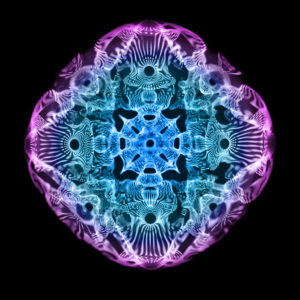 |
The Cymascope is a new type of scientific instrument that makes sound visible by converting vibrations of sound to vibrations in water.
The resulting images are both scientifically intriguing and artistically beautiful, leaving a lasting impression of an unseen world.
John Stuart Reid (b. 1948) is an English acoustics engineer, scientist and inventor. He has studied the world of sound for over 30 years and speaks extensively on his research findings to audiences throughout the United States and the United Kingdom. Co-inventor of the CymaScope, John’s work is inspired by acoustic pioneers, Ernst Chladni, Mary D. Waller and Hans Jenny and has taken their findings to a new level. His primary interests lie in investigating sound as a formative force and discovering why sound heals.
The CymaScope represents the first scientific instrument that can give us a visual image of sound and vibration – a cymatic image – helping us to understand our world and universe in ways previously hidden from view. The CymaScope holds the same potential for advancement as the microscope and telescope and its applications are on the brink of touching every aspect of human endeavor.
Felt Has Feelings by Bryan Day
Sat, Jan 10 — Thu, Jan 15, 2015
Reception & Artist Talk: Saturday, January 10, 6-8 PM
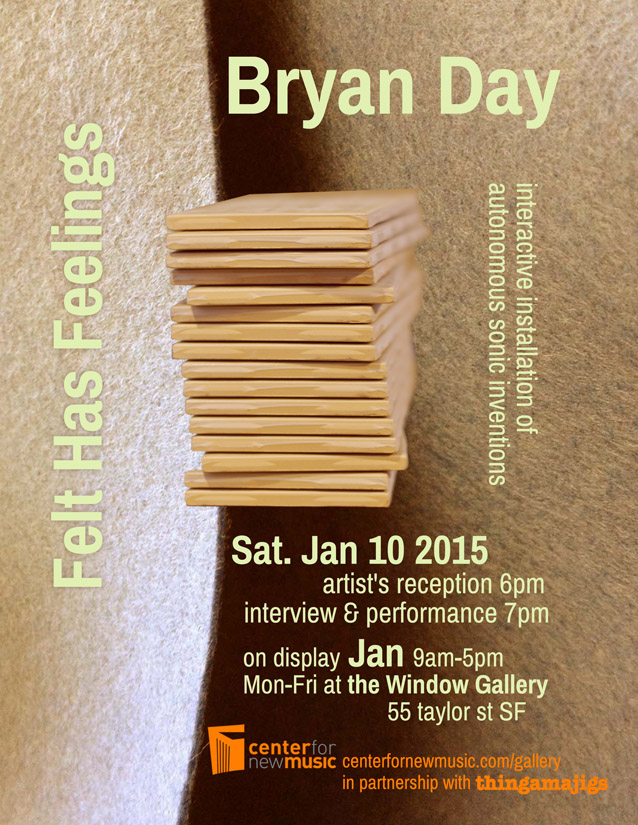
Bryan Day is a improviser, instrument inventor, illustrator and installation artist based in Richmond, CA. His work involves combining elements of the natural and man-made world using field recordings, custom audio generation software and homemade instruments. Day?s work explores the parallels between the patterns and systems in nature to those in contemporary society.
Day has toured throughout the US, Europe, Japan, Korea, Argentina and Mexico, performing both solo as Sistrum and Eloine and in the Shelf Life and Seeded Plain ensembles.
 Festival appearances include Thingamajigs Festival (San Francisco, 2013), New Media Sound and Art Summit (Austin, 2013), Milwaukee Noise Festival (Milwaukee, 2012), Denver Noise Festival (Denver, 2011), Heliotrope Festival (Minneapolis, 2010), Megapolis Festival (Baltimore, 2010), Denver Noise Festival (Denver, 2010), Transistor Festival (Denver, 2009), Quiet Music Festival (Cork, Ireland, 2008), Sonic Circuits Festival (Washington, D.C., 2007), Soundfield Festival (Chicago, 2005), and SubZero Festival (Minneapolis, 2001). Day has over 40 solo and ensemble releases on labels such as Creative Sources, Bug Incision, Friends and Relatives, Gameboy, Freedom From, Digitalis, Featherspines, Neus-318, Journal of Experimental Fiction, Unread, and Seagull.
Festival appearances include Thingamajigs Festival (San Francisco, 2013), New Media Sound and Art Summit (Austin, 2013), Milwaukee Noise Festival (Milwaukee, 2012), Denver Noise Festival (Denver, 2011), Heliotrope Festival (Minneapolis, 2010), Megapolis Festival (Baltimore, 2010), Denver Noise Festival (Denver, 2010), Transistor Festival (Denver, 2009), Quiet Music Festival (Cork, Ireland, 2008), Sonic Circuits Festival (Washington, D.C., 2007), Soundfield Festival (Chicago, 2005), and SubZero Festival (Minneapolis, 2001). Day has over 40 solo and ensemble releases on labels such as Creative Sources, Bug Incision, Friends and Relatives, Gameboy, Freedom From, Digitalis, Featherspines, Neus-318, Journal of Experimental Fiction, Unread, and Seagull.
Instruments by Dan Gottwald
Mon, Dec 1 — Wed, Dec 31, 2014
Reception & Artist Talk: Monday, December 22, 6-8 PM
[one_third]

[/one_third]
[one_third]

[/one_third]
[one_third_last]

[/one_third_last]
Dan Gottwald is a sculptor, instrument builder, video/installation/performance artist and composer. His work focuses largely on the tactile and the sonic as temporary events.
Gottwald’s work has been shown and performed in Albuquerque and Santa Fe, New Mexico as well as in Los Angeles, Oakland and San Francisco, California. Gottwald holds a BFA in Studio Arts from the University of New Mexico (where he ended up making music) and is currently pursuing an MFA in Electronic Music at Mills College (where he mostly makes sculptures). He is the artistic director and curator of the Analogous Ensemble, a performance collective dedicated to visual arts, music and dance incorporating new instruments.
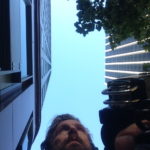 “My interest in touch is derived from sound and my interest in sound from touch. These driving forces in turn influence my love of the visual aspects of form and performance. In order to hear a sound we need a body to be touched by the rarified molecules of vibrating matter we understand as sound. In order to make a sound we need a body to affect matter. A musical instrument is mid-way between these conditions. It is the thing to touch and it is the thing that makes sound. To take these aspects of form and create something new to explore is my attempt to broaden the field of creative and performative experience. I relish the challenge of making a form inviting, responsive and durable enough to be that kind of interface.
“My interest in touch is derived from sound and my interest in sound from touch. These driving forces in turn influence my love of the visual aspects of form and performance. In order to hear a sound we need a body to be touched by the rarified molecules of vibrating matter we understand as sound. In order to make a sound we need a body to affect matter. A musical instrument is mid-way between these conditions. It is the thing to touch and it is the thing that makes sound. To take these aspects of form and create something new to explore is my attempt to broaden the field of creative and performative experience. I relish the challenge of making a form inviting, responsive and durable enough to be that kind of interface.
“Whether it is an audience allowed to interact with a piece, the result of a piece acting on an audience or regularly independent media acting together, it is the point of contact, the action of touch and repercussions of those interactions that I find compelling. I believe in blurry lines and I enjoy playing in those material and conceptual spaces where it becomes difficult to classify or discern one thing from the next.”
Visit dangottwald.com for more information.
Skatchboxes and Skatchplates by Tom Nunn
Thu, Sep 4 — Fri, Oct 31, 2014
Opening Reception: Thursday, October 2: 6-8 PM
[one_third]
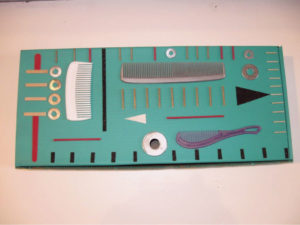
[/one_third]
[one_third]

[/one_third]
[one_third_last]
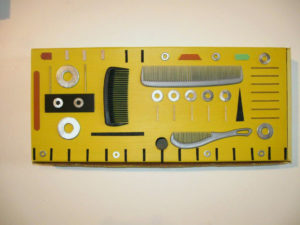
[/one_third_last]
Photos by David Michalak
Tom Nunn will be exhibiting a number of Skatchboxes and Skatchplates. The Skatchboxes here are part of a series of painted Skatchboxes called “Paintboxes,” created between April 2013 and February 2014. The Skatchboxes are made of cardboard boxes that originally contained computer parts (larger boxes) or computer keyboards (smaller boxes). Various objects are glued to the surface of the box and played with specially shaped soft plastic combs. The sounds are amplified using contact microphones (piezo pickups) taped to the underside of the playing surface (inside the box).
Skatchplates are similar in the objects used and the use of pickups, but the body of the instrument has a flat triangular shape with open ends – the result of simply folding a single sheet of cardboard at two points. The small panel is made to fold under the playing surface for compact packing/carrying.
About the Artist
Tom Nunn has designed, built and performed with original musical instruments since 1976, and has built over 250 instruments. His instruments typically utilize commonly available materials, are sculptural in appearance, utilize contact microphones for amplification, and are designed specifically for improvisation with elements of ambiguity, unpredictability and nonlinearity. Tom has performed extensively throughout the San Francisco Bay Area for over 30 years, as well as in other parts of the U.S., Canada, Europe, and New Zealand, both as soloist and with other musicians. Tom also performs with T.D. SKATCHIT, RTD3, MUSIC FOR HARD TIMES, and GHOST IN THE HOUSE and has appeared on a number of recordings, including his solo CD, Identity (2007), T.D. Skatchit & Company (2009), Skatch Migration (2010), Skatch Surveillance (2012), and Ear of the Storm (2013) (Edgetone Records). In 1998, he self-published WISDOM OF THE IMPULSE: ON THE NATURE OF MUSICAL FREE IMPROVISATION.
Of Land and Sea: Natural-Object Instruments by Cheryl E. Leonard
Thu, Jul 3 — Sun, Aug 31, 2014
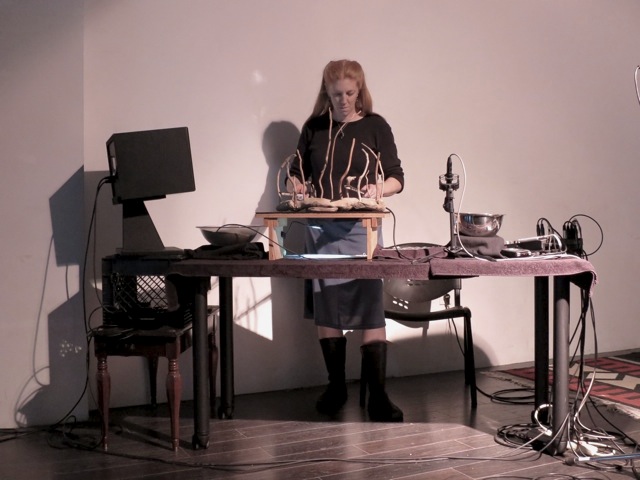 |
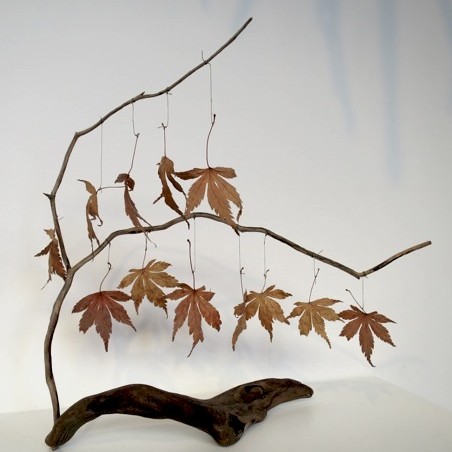 |
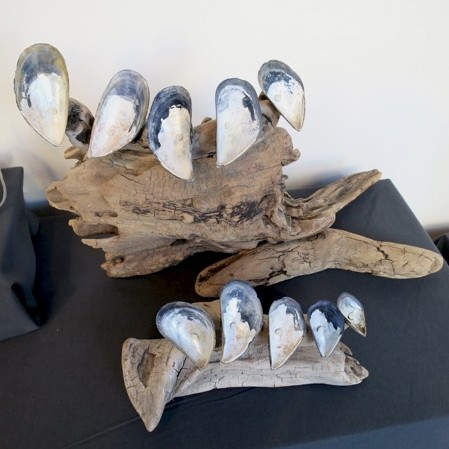 |
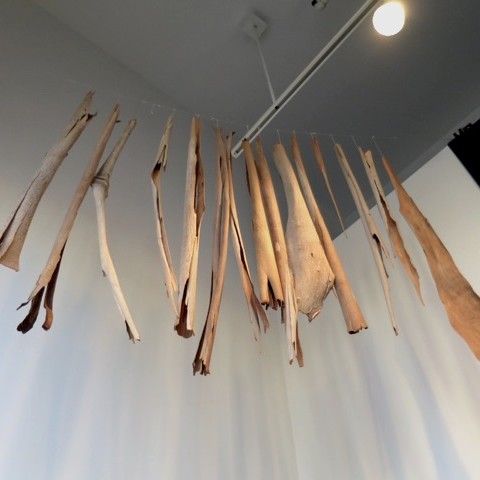
|
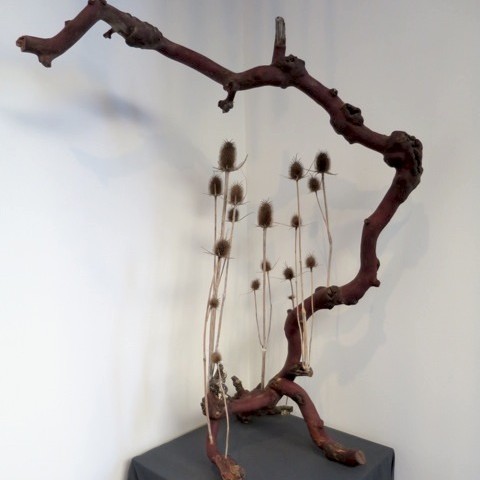 |
Cheryl Leonard in performance and selected instruments, from opening reception. Photos by Michael Zelner. (Complete Set)

When I first began investigating the musical potential of natural objects I simply duct-taped microphones to rocks, shells, bones, wood, pinecones, and leaves, and attempted to rub, tap, bow, brush, and tickle new sounds out of them. I soon realized these materials would be more sonorous and much easier to play if I mounted them somehow. So, using hand and power tools leftover from my days working as a satellite dish installer, I started constructing crude stands out of pieces of driftwood that were lying around my studio. Over time my practical instrument stands have evolved into increasingly elaborate musical sculptures, and I now consider the visual aspects of an instrument to be of equal importance with its sonic qualities.
One of the allures of creating music with natural materials is delving into the minutia of the very quiet, and most of my instruments are intended to be amplified. Microphones enable me to explore the subtle details of sounds produced by stones, driftwood, pinecones, penguin bones, icebergs, etc. I am fascinated and continually surprised by the voices these objects contain and the beautiful intricacies of their tones. Once I find a lexicon of sounds that intrigue me I shape them into musical forms that reflect, model, or demonstrate each piece’s theme. Most of my works are inspired by natural phenomena, structures, motions, or processes. Morphing ecosystems, water flow patterns, animal breathing rhythms, cloud formations, and the sculpting of mountains by glaciers are a few of the subjects my past projects have investigated.
A passion for wild and remote places drives my creative process. I try to imbue my works with the sense of wonder and awe I have when I encounter millions of baby frogs hopping through an old growth forest, stand on a mountain summit looking at a rainbow halo around my shadow, watch a giant iceberg upend, or feel the booms of a calving glacier resonate in my chest. In making music with natural objects I hope to inspire others to hear the world in new ways, to look at common materials as potential treasures, and to consider the human relationship within the natural world.
About the Artist
 Cheryl E. Leonard is a San Francisco-based composer, performer, and instrument builder. Over the last decade she has focused on investigating sounds, structures, and objects from the natural world. Many of her recent works cultivate stones, wood, water, ice, sand, shells, feathers, and bones as musical instruments. Leonard is fascinated by the subtle textures and intricacies of sounds, especially very quiet phenomena. She uses microphones to explore micro-aural worlds hidden within her sound sources and develops compositions that highlight the unique voices they contain. Her projects often feature one-of-a-kind sculptural instruments that are played live onstage and field recordings from remote locales.
Cheryl E. Leonard is a San Francisco-based composer, performer, and instrument builder. Over the last decade she has focused on investigating sounds, structures, and objects from the natural world. Many of her recent works cultivate stones, wood, water, ice, sand, shells, feathers, and bones as musical instruments. Leonard is fascinated by the subtle textures and intricacies of sounds, especially very quiet phenomena. She uses microphones to explore micro-aural worlds hidden within her sound sources and develops compositions that highlight the unique voices they contain. Her projects often feature one-of-a-kind sculptural instruments that are played live onstage and field recordings from remote locales.
Leonard holds a BA from Hampshire College and an MA from Mills College. Her music has been performed worldwide and her work with natural-object instruments has been featured on several television programs and in the video documentary Noisy People. Her collaborative works with visual artists Genevieve Swifte and Oona Stern have been exhibited in galleries in California, Norway, Australia, Mexico, and Argentina. Leonard has received grants from the National Science Foundation’s Antarctic Artists and Writers Program, ASCAP, American Composers Forum, American Music Center, the Eric Stokes Fund, and Meet the Composer. She has been commissioned to create musical instruments and compositions for Kronos Quartet, Illuminated Corridor, and Michael Straus. Cheryl has been awarded residencies at Oberpfälzer Kunstlerhaus, the Djerassi Resident Artists Program, the Arctic Circle, Villa Montalvo, and Engine 27. Recordings of her music are available from NEXMAP, Unusual Animals, Ubuibi, Pax, Evolving Door, Apraxia, 23 Five, The Lab, and Great Hoary Marmot Music.
Giant Music Boxes and The Long Tube, by Brenda Hutchinson
Thu, May 1 — Mon, Jun 30, 2014
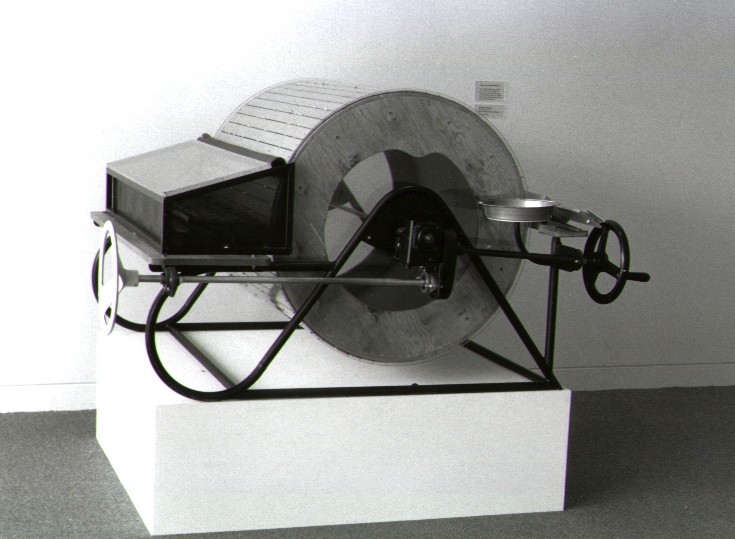
My work has always been more about invitation than instruction or direction. Engaging with sound in a mindful way has been the single most empowering aspect of my life. I believe in its transformative powers and have been inspired and committed to finding ways extend this experience to others.
Brenda Hutchinson was born in Trenton, New Jersey in 1954. She is a composer and sound artist whose work is based on the cultivation and encouragement of openness in her own life and in those she works with. Hutchinson encourages participants to experiment with sound, share stories, and make music. She has spent the past 2 decades singing into a 9 1/2 foot tube and has designed a gestural interface for the Long Tube and MAX/MSP. Recently, Brenda has been developing a sound initiated drawing interface and assistive device to work with memory and cognitive impairment. She is also Groucho Parx, a member of the Avatar Orchestra Metaverse in Second Life.
Brenda’s exhibit in the window gallery of C4NM will feature her Giant Music Boxes and Long Tube:
Originally made for the Exploratorium, the Giant Music Box is an instrument/interactive exhibit that anyone can use to make music. It was my response to the challenge of creating an instrument and situation where people could play alone or with others and create something that “sounded good”. I have always loved the sound of those little music boxes and thought it would be wonderful to extend that private experience to a shared opportunity for music making.
 While the Giant Music box is obviously an object created expressly for making music, the Long Tube became an instrument in the same way that a bucket or pair of sticks or any found object is transformed by the way it is played. The particular beauty of the Long Tube as a found object instrument is that it is interactive. The Long Tube is bionic and if you sing into it, something interesting will happen.
While the Giant Music box is obviously an object created expressly for making music, the Long Tube became an instrument in the same way that a bucket or pair of sticks or any found object is transformed by the way it is played. The particular beauty of the Long Tube as a found object instrument is that it is interactive. The Long Tube is bionic and if you sing into it, something interesting will happen.
Part of the reason I perform with the Long Tube is to inspire other people to try because it is so simple and immediately rewarding as a musical instrument. Eventually my curiosity with expanding the sonic and interactive possibilities of the Long Tube overpowered my desire to demonstrate its egalitarian nature, and I developed a gestural interface to work with the computer and live performance.
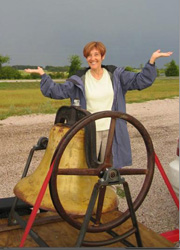
Recordings of her work are available through TELLUS, DEEP LISTENING, THE AERIAL, O.O. DISCS, FROG PEAK MUSIC and Leonardo Music Magazine.
Join composer and sound artist Brenda Hutchinson for an opening reception on Thursday, May 1, 2014, from 6 to 8 PM.
Experimental Musical Instruments by Peter Whitehead
Tue, Mar 4 — Wed, Apr 30, 2014
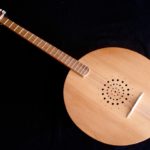
|
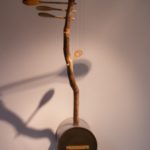
|
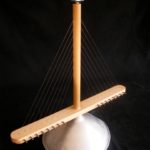
|
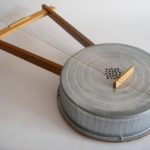
|
The exhibit represents a portion of the instruments created by Peter Whitehead over a 20 year period.
Whitehead is a composer, songwriter and instrument builder. His instrument building grew out of his earlier work with sculpture made from found materials and a fascination with sound which began in childhood.
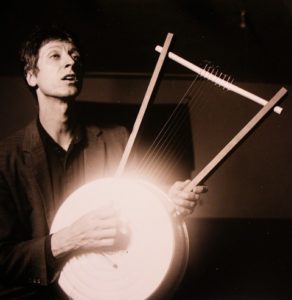 While traveling in S.E. Asia in 1989 he realized he could combine sculpture, performance and music by constructing and playing original instruments. Having experimented with playing ‘found’ objects before this, it was at this time that he began to construct his first instruments. Many of his creations are derived from folk instruments from around the world and some are based on images of ancient instruments that no longer exist, although the materials used to construct them are modern or industrial.
While traveling in S.E. Asia in 1989 he realized he could combine sculpture, performance and music by constructing and playing original instruments. Having experimented with playing ‘found’ objects before this, it was at this time that he began to construct his first instruments. Many of his creations are derived from folk instruments from around the world and some are based on images of ancient instruments that no longer exist, although the materials used to construct them are modern or industrial.
Whitehead has composed songs and scores for film and dance using a variety of instruments ranging from found to invented to conventional. In recent years this palette has been expanded to include electronics and samples of found or invented instruments.
He has also composed for and performed with a number of prominent choreographers and dancers including Mikhail Baryshnikov, Susan Marshall & Company, Anna Halprin, Charles Moulton/Janice Garrett and Sarah Shelton Mann. His work has appeared in several films including “City of Ghosts” directed by Matt Dillon and “Following Sean” directed by Ralph Arlick.
Thanks to digital technology his music has been used for Television and Radio in over 30 countries.
Whitehead will be present at c4nm for an opening reception and instrument demonstration on Thursday, March 6, from 6 to 8 PM.
Kronos at 40: Instruments from the Collection
Tue, Jan 7 — Fri, Feb 28, 2014

This exhibit features large sculptural instruments that were created for Kronos by Walter Kitundu, Victor Gama and others. Violinist David Harrington explains: “Composers and fellow musicians have learned about our fascination with the wide world of sounds and now, to our delight, frequently bring us instrumental gifts to add to our collection. As our palette of musical colors has grown bigger, we have attempted to make Kronos sound like many different instruments.”
Works included:
1) Phonoharp by Walter Kitundu. Made for the piece Cerulean Suite III by Walter Kitundu.
2) Toha by Victor Gama. Made for the piece Rio Cunene by Victor Gama.
3) Beguèna Maridhia by Walter Kitundu. Made for the piece Suite from the Repertoire of Alèmu Aga arranged by Jacob Garchik.
4) Pendulum by Alexander V. Nichols. Made for the piece Pendulum Music by Steve Reich.
5) Trimpin violin by Trimpin. Made for the piece 4 Cast: Unpredictable by Trimpin and the Kronos Quartet.
6) Stroh viola by Walter Kitundu. Made for the piece Transylvanian Horn Courtship by Terry Riley.
7) Pendulum by Alexander V. Nichols. Made for the piece Pendulum Music by Steve Reich.
8) Zeta Music Systems Inc. electric violin.
9) Wooden Laterna cylinder by Panos Ioannidis. Made for the piece Strophe in Antistrophe by Magda Giannikou.
“In the last forty years the members of Kronos have played many instruments in addition to our bowed four-stringed ones we each began playing as kids. We have played an assortment of drums, bells, and gongs from many cultures, a wide range of keyboards such as a toy piano, casios, omnichords and stylophones and instruments from India [shruti box, tambura], Serbia [gusle], Brazil [caxixi] and instruments from many other lands, too. An Apache violin was made especially for one of our pieces as were individual turntables for another and a harp-cello inspired by the ancient Ethiopian beguena for yet another. We’ve loved playing all kinds of kids toys from around the world. We’ve turned artillery shells used in wars in Vietnam and Angola into musical objects and we’ve bowed barbed wire fences as well as drift wood. Recently we were bowing inflated surgical gloves for a song about sea pigs.
“Discovering hidden relationships within the huge family of instruments has been a delight. Composers and fellow musicians have learned about our fascination with the wide world of sounds and now, to our delight, frequently bring us instrumental gifts to add to our collection. As our palette of musical colors has grown bigger, we have attempted to make Kronos sound like many different instruments.
“We have found that the most important instruments we possess are our ears and keeping them fresh, nourished and curious is an essential part of our work. It is amazing how our violins, viola, and cello can take on new lives. We have learned that music celebrates life and is found wherever people find themselves. Plinking, plonking, blowing and bowing is fun to do and music itself is becoming larger, more mysterious and more difficult to define as time goes on.”
David Harrington
10 December, 2013
Four Pieces: Works by Walter Kitundu
Fri, Nov 1 — Tue, Dec 31, 2013
Artist Walter Kitundu brings his unique vision to the Center for New Music’s window gallery with FOUR PIECES, presented by Thingamajigs. Please join us for the opening reception, which will include an artist talk and brief performance.
We Are Everything We Are Not is a reflection on the nature of our personal and collective meanderings. It is a response to the self-oriented lens through which we tend to view the world. Our actions often have implications far beyond the span of our attention and the reach of our vision.
Sound In Motion: the Sonic Clothing of Bob Marsh
Thu, Sep 5 — Thu, Oct 31, 2013
The work of Bob Marsh over the past two and a half years in the creation of “sonic clothing” brings together, in a uniquely dynamic way, his passion for making sculpture, avnat-garde music and dance. Beginning with materials from everyday life—plastic water bottles, tape, newspaper pictures—he transforms them to highlight various sound producing capacities, both obvious and latent, and places the materials in an intimate position with our primary instrument: the human body. The dormant sounds are wakened by movements large and small and announce the existence of a new being.
For the showing at the Center for New Music, Marsh will create a new work from the drawings and constructions he’s made over the last three years following the dance classes with Anna Halprin. Anna frequently asks students to cast their movement experiences into another medium—drawing, or writing, or combinations thereof. Marsh will take his graphic and sculptural notes and turn them into an opportunity for movement.
Invented Instruments by David Samas
Mon, Jul 1 — Thu, Aug 29, 2013
This exhibition of work by David Samas features instruments fashioned from raw materials, for his chamber opera The Green Wood, a genre-bending sonic romp through the world’s forests. The Green Wood seeks to uncover the voice, point of view, and inner life of the forest soundscape as it evolves from the silence before dawn, through the ornate dawn call of the songbirds and voices of the rivers and trees, into the defining evening choir of frogs and wolves, ending in the stillness and reflection of the witching hours.
David Samas is a composer, cosmologist, poet, painter, performer, philosopher, farmer and father of 4; he is a practitioner and professor of arcane healing technologies and traditional magics, a field which includes massage, herbalism, hypnotherapy, psychoacoustics and shamanism. He has a BFA from the SF Art Institute in conceptual art and studied poetics at the New College of California, Vassar, Bennington, and SF State. As a young man he performed with the SF Boys Chorus, the SF Opera, and the SF Symphony with which he won a GRAMMY for the “best classical recording” of 1994. He also makes sacred geometry amulets and talismans, is an excellent cook, and self publishes small editions of handbound art books.
Experimental Musical Instruments by Bart Hopkin
Fri, Apr 26 — Sun, Jun 30, 2013
Bart Hopkin is a designer and builder of unconventional musical instruments, and a student of musical instruments worldwide. For many years he was publisher and editor of the quarterly journal Experimental Musical Instruments, and he has written several books on musical instruments and their construction. In playing the instruments and performing with them, his focus most recently has been on semi-self-playing instruments ― constructions which, once gotten started, will keep going for a while with just occasional interventions, leaving the player free to layer in sounds from other sources.
The sounds that can be heard intermittently in the room are recordings of Bart’s instruments, including some that are included in this display.
